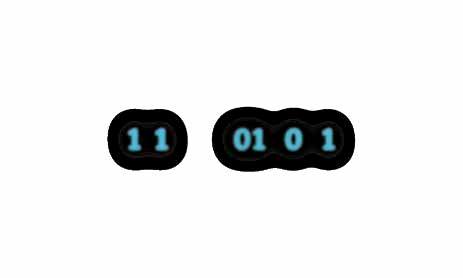















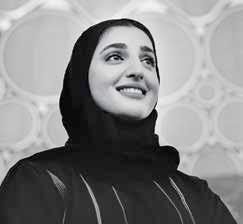













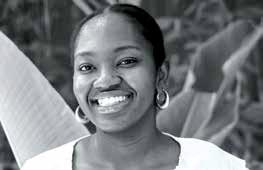




























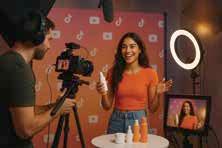
































































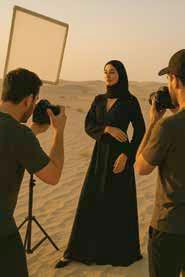

We don’t just create content; we craft stories with cultural precision and purpose.
At SMS, branded content is a strategic tool - built on insight, designed to connect, and made to move audiences.
Turn your brand into a story worth telling. Connect with SMS.
We turn brand stories into moments, content into connection, and campaigns into lasting impact.
Campaign Middle East
spotlights promising young talent aged 30 and younger working client-side across marketing, communications, digital and social media.
Bayut’s Sahar Khan and Hyundai UAE’s Wassim Derbi share marketers’ perspectives on backing the right people and what it will take to stay ahead of the curve for the foreseeable future.


Have brands gained the trust of consumers in terms of safeguarding consented data?

Campaign Middle East asks industry leaders about how multi-modal search experiences are evolving in the age of AI agents, and how marketers need to diversify and measure be er within the search ecosystem.
A comprehensive directory of radio stations, podcast networks, audio streaming platforms and sonic branding agencies.
72
Property Finder’s Sevgi Gur discusses the human-centric and AI-driven transformation within marketing.
Motivate Media Group
69
Publicis Groupe Middle East’s Jennifer Fischer on unlocking AI superpowers.

Head Office: 34th Floor, Media One Tower, Dubai Media City, Dubai, UAE. Tel: +971 4 427 3000, Fax: +971 4 428 2266. Email: motivate@motivate.ae Dubai Media City: SD 2-94, 2nd Floor, Building 2, Dubai, UAE. Tel: +971 4 390 3550, Fax: +971 4 390 4845 Abu Dhabi: Motivate Advertising, Marketing & Publishing, PO Box 43072, Abu Dhabi, UAE. Tel: +971 2 677 2005, Fax: +97126573401, Email: motivate-adh@motivate.ae Saudi Arabia: Regus Offices No. 455 - 456, 4th Floor, Hamad Tower, King Fahad Road, Al Olaya, Riyadh, KSA. Tel: +966 11 834 3595 / +966 11 834 3596. Email: motivate@motivate.ae
London: Motivate Publishing Ltd, Acre House, 11/15 William Road, London NW1 3ER. Email: motivateuk@motivate.ae www.motivatemedia.com
EDITORIAL: Motivate Media Group Editor-in-Chief Obaid Humaid Al Tayer | Managing Partner and Group Editor Ian Fairservice Campaign Middle East Editor Anup Oommen | Senior Reporter Ishwari Khatu | Junior Reporter Shantelle Nagarajan | Junior Reporter Hiba Faisal | Group Editor - Arabic Rehab A. Barham
DESIGN: Senior Designer Thokchom Remy | Art Director - Arabic Ahmad Kamal
ADVERTISING ENQUIRIES: Chief Commercial Officer Anthony Milne | Publishing Director Nadeem Quraishi (nadeem@motivate.ae) | Sales Manager Tarun Gangwani (tarun.gangwani@motivate.ae)
PRODUCTION: General Manager S. Sunil Kumar | Production Manager Binu Purandaran | Assistant Production Manager Venita Pinto HAYMARKET MEDIA GROUP: Chairman Kevin Costello | Managing Director Jane Macken





It’s time to cut to the chase: The marketing landscape is shifting beneath our feet, and marketers hoping to plant their feet in the sands of ‘what worked in the past’ are likely to be swept away in the oncoming tide of technology.
Here’s the kicker:
Consumers are already surfing the wave of generative AI search tools such as ChatGPT, artificial intelligence (AI)-powered virtual voice assistants such as Alexa+, and shopping agents that autonomously compare prices, find discounts and ‘add to cart’ on their behalf.
While some marketers are still catching up, others that have dared to experiment, test, learn and scale new tools are already miles ahead of supposed industry experts banking on the best of years gone by.
What needs to change? If discussions at the recent Campaign Breakfast Briefing: Marketing Strategies 2025 event and the discourse within this edition of the magazine are to be taken to heart, everything needs to change.
Marketers need to rethink not only how content is created, but also for whom content is created. ‘Zero-click search’ and the dawn of AI agents marks a move into territories where brands – and the agencies servicing them – are no longer vying only for consumers’ attention. They are also hoping to be ‘noticed’ by algorithms and machines that influence consumer decision-making – and taking decisions on their behalf and at their behest. This also means marketers need to redefine how they measure visibility. Consumers aren’t moving in a perfectly linear manner through that seemingly symmetrical funnel from awareness to consideration to conversion. The age of AI now requires new textbooks on attribution models.
Search specialists are being asked to unlearn the old and learn the new. ‘Working models’ are being dismantled and reconstructed. There’s a sudden dearth of ‘AI content strategists’ because keyword optimisation and traffic-centric tactics are giving way to answer engine optimisation (AEO) and generative engine optimisation (GEO).
Reinvention and relearning are the new normal – and, sad to say, so are redundancies and restructuring for people and teams leaning into purely reactive strategies. Generative AI tools such as ChatGPT, Gemini, Claude, Midjourney and Perplexity are the new interns, earning stipends by saving time. AI-powered workflow automation tools such as Zapier, Make and n8n are the new team leads ensuring operational efficiency.
Edition (and other editions) of Campaign which is the copyright of Haymarket. Campaignis a trademark of Haymarket and is used under licence. The views and opinions expressed within this magazine are not necessarily those of Haymarket Magazines Limited or those of its contributors.
Marketers are being called upon to reclaim strategy, act based on AI-derived insights, disrupt and differentiate with empathy, and build value-led and culturally resonant brands that connect with core audiences on a human level. The shift is not merely technical or technological – it’s
strategic, structured and … it’s here.

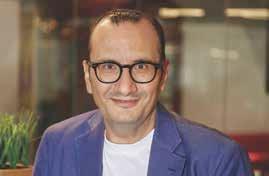
The Middle East celebrated with a haul of six big wins, including Gold, Silver and Bronze, across five categories at the Campaign Global Agency of the Year Awards 2025.
The awards received a record number of entries – 117 companies from 27 countries.
SOCIALEYEZ has been appointed as the official creative agency for the Department of Government Enablement (DGE) in Abu Dhabi, including its sub-accounts TAMM and MAWAHEB.
As part of this strategic partnership, SOCIALEYEZ will manage the Department’s digital presence – from social media management and strategic campaign planning to high-end content production, creative direction and website development.
SOCIALEYEZ claims this strategic partnership aligns with its mission to support visionary government-led initiatives and enhance public sector communication across the UAE.
In April 2025, the agency also announced its entry into the food and beverage (F&B) sector through two new partnerships with fast-food chain Texas Chicken and restaurant chain Buffalo Wild Wings.


Leaders at Publicis Groupe Middle East & Turkey (ME&T) won two leadership category awards. The Gold award for Head of Agency went to the holding company’s CEO Bassel Kakish. Reviewing the entry, judges applauded Kakish for turning Publicis Groupe ME&T into “a real
powerhouse”. Adding to Publicis Groupe ME&T’s leadership wins, Tahaab Rais took home Strategic Planning Leader of The Year 2024 as the Gold winner in the category.
Judges called Rais “a visionary leader who redefines what strategy means in today’s ever-evolving
landscape. A clear towering strength of impact across his agency.”
Adding to the list of the region’s wins, TBWA\RAAD received three awards, with the agency clinching the Gold for Best Place to Work: Individual Shop & Network.
While scoring the entry, judges commended the agency for its “trust of senior leadership”, deeming it “not only an outstanding result, but incredibly good news for their business”.
Romy Abdelnour, the Head of Communications at TBWA\RAAD also took home a Gold as Corporate Communications / Marketing Person of The Year 2024.
Judges praised Abdelnour’s “strong track record on brand building, brand reputation and media relations”.
The agency also won Bronze in the Best Network: Middle East & Africa category. Making the case for its win, TBWA\RAAD credited its 1,000-plus employees, referred to as ‘Pirates’, who it claims grew revenue at double-digit rates and helped welcome almost 50 new clients aboard.
Publicis Groupe’s Saatchi & Saatchi Middle East took the top spot in this category with a Silver win.
A Gold winner was not recognised from this category.
Publicis Groupe’s ‘Power of One’ model – connecting strategy, creative, and execution under a single point of contact – has become a core part of its pitch and delivery.
Publicis Groupe Middle East’s Dubai, Riyadh and Doha offices also showed steady progress and consistent creative performance. Account wins in 2024 included Pfizer, Subway and Amazon.



Yango Tech, the unified ecosystem delivering tailored advanced B2B technology solutions to local businesses within Yango Group, has announced the upcoming launch of its GenAI Platform.
The system is designed to help retailers and brands gain visibility and engage with customers across AI chatbots such as Claude, ChatGPT and Perplexity.
The GenAI Platform will allow retailers to list and promote their products directly within AI-powered
chat interfaces, turning everyday conversations into high-intent shopping experiences. For example, when customers search for queries such as “Best sneakers under $200” or “Where to buy a new hairstyler”, retailers using the GenAI Platform can appear as the top result, providing real-time pricing and availability.
At the core of the platform is Yango Tech’s MCP Router, a system that acts as a central translator and traffic manager. It collects product-related


To celebrate its 20th anniversary, dubizzle launched a witty two-part campaign that champions the platform’s status in the UAE’s property and car marketplaces. Rolled out across a full 360-degree marketing push, the campaign features two humour-laced films that bring to life a familiar scenario: the struggle to buy or sell – until dubizzle enters the picture. Apart from making audiences laugh, the anniversary campaign is also meant to highlight the platform’s legacy and role in people’s lives across two decades. Leaning heavily into brand rather than performance, the campaign has been rolled out across digital, social, radio, PR, video, platform assets and out-of-home (OOH) channels.
queries from different AI platforms, routes them to the merchant’s content systems (known as MCPs), and delivers ranked results back to the user in real-time.
Initial rollouts of the GenAI Platform are set to begin with select retailers in the MENA region by the end of 2025. One of the key benefits for retailers is improved discoverability. Following the MENA rollout, Yango Tech plans to expand the GenAI Platform to Latin America and other markets throughout 2026.
The MENA region’s digital advertising spend reached $6.95bn in 2024, up 19.8 per cent from the previous year, according to new data released by IAB MENA. The announcement, made at a closeddoor member event on June 12, confirms the region’s continued momentum – and reframes its recent growth trajectory following a restatement of last year’s figures. In 2023, IAB MENA had previously reported the market at $6.25bn, but enhanced econometric modelling and broader industry validation – to align themselves with international data standards – prompted a revision to $5.8bn, adjusting last year’s growth rate from 13.6 per cent to 14.3 per cent. Despite the change, both years mark milestones: 2023 was the first time MENA crossed the $6bn threshold, while 2024 now stands as the region’s highest digital adspend total on record. Search advertising also grew above the market average in 2024, driven in part by new activity in retail media and performance marketing. As a region, MENA retained its position as a Top 5 market in EMEA, while Saudi Arabia – now classified as a Top 10 individual market globally – led regional growth with a 23.5 per cent year-on-year increase.


Use
This out-of-home (OOH) takeover of Dubai features a star from the Dubai Bling reality television show in Dubai: Safa Siddiqui. The takeover was inspired by a comment left by a user on the initial OOH installment: ‘Safa, a billboard isn’t enough. I want that entire road stamped with you, that’s when I know I’m in Dubai.’ One fan’s cheeky remark became the spark for a citywide takeover. The campaign also includes a reality TV format digital-first installment which features Love is Blind Habibi cast member Dounia Al Ibrahim. Combined with influencer partnerships on social media, the campaign gained more than 200 million impressions across the Middle East.
Agencies Brandizer, Wavemaker, Hypermedia – a subsidiary of W Group Holding, and Qraft
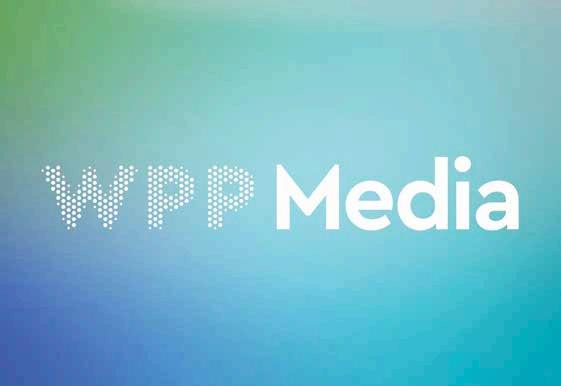
GroupM has officially rebranded to WPP Media and is now describing itself as an “AI-driven media company”.
On the rebrand, Mark Read, Chief Executive Officer at WPP, said that while “GroupM was built for a time when media scale mattered most, WPP Media reflects the power of AI, data and technology and simpler, more integrated solutions”. Mindshare, Wavemaker and EssenceMediacom are set to continue to provide clients with dedicated
teams as brands within WPP Media. Despite media agencies continuing to operate as distinct brands within WPP Media, GroupM told staff that these brands will move to a single profit and loss (P&L) structure and act as “one voice in the market”, with agency-specific titles set to “sunset”.
Following the rebrand, WPP also announced that Read will retire from the company’s board and as CEO on 31 December 2025, after more than 30 years with the company, which includes seven years as
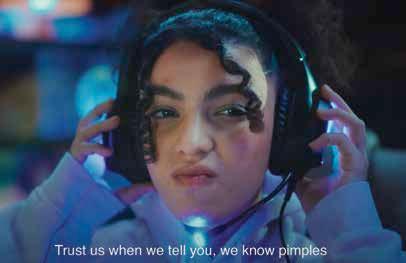

Himalaya Neem Face Wash, a staple in the skincare routines of young consumers across the region, is shifting gears in its latest campaign to speak more directly to Generation Alpha. The campaign’s creative tone is deliberately understated, using humour and familiarity rather than a heavy-handed sales message. Spot titles such as ‘The GOAT of pimple-free skin is here for the win!’ and ‘Now unboxing: Main Character Energy!’ reflect this light-touch approach. The campaign aims to maintain the brand’s presence among new skincare users without overplaying its legacy or talking down to its audience, and without forcing the brand into unfamiliar territory.

the CEO. Commenting on his decision to retire, Read said, “It has been an immense privilege to serve as CEO for the past seven years. When I took on this role our mission was to build a simpler, stronger business, and put structure and new energy behind our creativity and performance, powered by world-leading technology. I am proud that our teams across the business have delivered that exceptionally well.”
Adding to the news of the company’s restructure, Brian Lesser, chief executive of WPP Media, told investors in March 2025 that WPP “[knows] that we have to be simpler” and laid out a five-point plan, which included a shift to focus on an AI-based data strategy. Lesser added, “By investing in our AI-powered product [WPP Open], integrating our offer with data and technology, and equipping our people with future-facing skills, we’re helping our clients to stay ahead of rapidly changing consumer behaviour and unlock the limitless opportunities for growth that AI will create.”
Lesser has made a series of changes to streamline the business since joining in September 2024, when he replaced Christian Juhl. He axed global agency brand chief executive roles for media agencies EssenceMediacom, Mindshare and Wavemaker in a bid to further centralise operations.
GroupM EMEA chief executive Josh Krichefski left the business in March, after 14 years. Its leaders in key markets, including the UK, now report directly to Lesser.
Nick Lawson, former global chief executive of EssenceMediacom, left prior to Krichefski in December 2024. In his place, Frances RalstonGood, former Global Chief Operating Officer at EssenceMediacom, was left to oversee his responsibilities, but also left in March 2025.

This campaign builds on L’Oréal’s long-standing commitment to women’s empowerment – while challenging the language that continues to shape female identity in the region. The campaign’s out-of-home presence debuted in Beirut, with upcoming rollouts in Riyadh, Dubai, and across the region. The hero film features actresses Yasmine Sabri and Aseel Omran, standing shoulder-to-shoulder with women across the region. They take to the streets, displaying the power of words, including two missing Arabic letters, “al” that transform the meaning of the words “sit bait” (housewife) into “sit al bait” (woman of the house), rewriting the narrative, and restoring value to the unseen labour of women.
The deal unlocks high-frequency brand exposure inside the Kingdom of Saudi Arabia’s newest transit network: a powerful network of 2,688 digital screens within 183 trains that are comprised of 448 carriages, operating across six lines.
Saudi Signs Media and its exclusive media representative Rotana Signs have been awarded a new media platform within Riyadh Metro carriages – a powerful network of 2,688 digital screens installed inside 183 trains that are comprised of 448 carriages and operate across six lines.
As the largest and newest urban transit system in Saudi Arabia, Riyadh Metro has already welcomed more than 18 million passengers and conducted more than 162,000 trips. As such, this
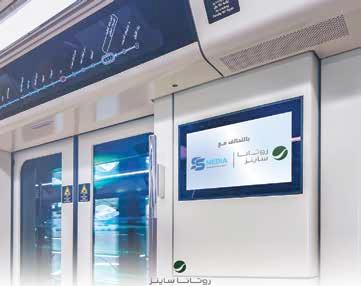
“This reflects our commitment to delivering innovative advertising solutions that support the city’s growth and align with the objectives of Vision 2030.”
As the carriage environment is elongated, confined and distraction-free, it is ideal for advertising presence that helps build brand awareness, increased recall and deepened engagement. Long dwell times and repeated utilisation by the public, advertisers benefit from the ability to reach commuters across all six metro lines – the blue, red, orange, yellow, green and purple lines – which pass through the city’s key residential areas, business districts and major hubs.
Serving a broad cross-section of residents such as students, young professionals and families, in addition to business travellers and international visitors, the digital screen network is positioned as a highly valuable platform for brands aiming to build visibility and high frequency exposure.
As part of the city’s ongoing transformation under Vision 2030, the Riyadh Metro network effectively connects all major north-south and east-west routes across key sections of the city fulfilling mobility needs for both locals and visitors. The addition of the digital screen network has turned every metro journey into a valuable brand-building opportunity, helping advertisers convert routine commutes into high-impact touchpoints.
Hassan Zaini


reflects our commitment to delivering innovative
Commenting on this project, , Deputy CEO of Sales at Rotana Signs, said, “We take great pride in contributing to Riyadh’s development journey. The presence of digital screens within a novel environment such as that of Riyadh Metro carriages reflects our commitment to delivering innovative advertising solutions that support the city’s growth and align with the objectives of Vision 2030.”





within Dubai Metro and the Haramain High-Speed companies, we continue to empower brands through strategic platforms across the
Zaini added, “This expansion builds on our regional track record, including successful media operations within Dubai Metro and the Haramain High-Speed Railway. Backed by the expertise of our sister companies, we continue to empower brands through strategic platforms across the region’s leading transit networks”.



As Riyadh continues its evolution into
deployment of the Metro carriage’s novel and evolving touchpoint provides advertisers with a unique opportunity to engage with a captive and growing audience group while moving through the capital’s most vital mobility corridors.
Each of the metro’s carriages features six strategically positioned digital screens placed adjacent to sliding doors and journey progress displays. Their placement is a natural focal point for passengers that guarantees maximum visibility and attention throughout each trip.

As Riyadh continues its evolution into a global hub of innovation and connectivity, this landmark deployment of the Metro carriage’s digital screens offers brands an efficient, expansive and immersive media opportunity, placing advertisers at the very heart of the city’s dynamic progress.









Have brands successfully gained the trust of consumers in terms of safeguarding consented data?

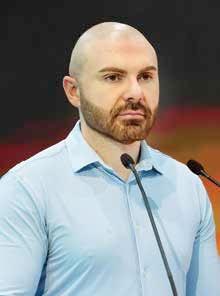
Baha Hamadi Founder and Managing Director, Keel Comms
Not really. Despite increased awareness around data privacy and stricter regulations, many consumers remain sceptical about how brands handle their data. Misuse cases such as the recent adidas data breach continue to erode trust, making it difficult for brands to fully assure customers of their data security. The evolving privacy frameworks are a step forward but have yet to translate into tangible confidence for most consumers. To truly earn trust, brands must prioritise transparency, proactive communication and demonstrable accountability – going beyond compliance to build meaningful relationships based on respect and ethical data stewardship.
Harsh Kocher Account Director, TBWA\RAAD
Consumers don’t trust brands because of privacy policies – they trust them because of what the brand stands for. First-party data is only as powerful as the brand equity behind it. In our region, people share data with brands they already associate with value, consistency and relevance. So, while frameworks evolve, trust still comes down to gut feel: Do I like this brand enough to let it in? It’s not a tech issue – it’s a brand issue. And if you haven’t earned that trust, no pop-up, checkbox or cookie disclaimer is going to save you.
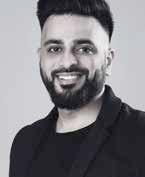
Tanya Chaudhary Senior Communications Manager, BPG Group
In the Middle East, especially across the GCC, brands are taking meaningful endeavours to earn consumer trust. However, it is still a journey. In today’s business environment, safeguarding consented data is no longer just an IT mandate; it’s a communications imperative. Visa’s recent Checkout Friction Report revealed 67 per cent of UAE shoppers prefer biometric methods like Face ID. This goes to show how privacy-first tech, when clearly communicated, drives both security and customer confidence. In my work across data-led communications, I’ve seen how transparent, culturally attuned messaging bridges the gap between compliance and trust. I believe brands that explain how they protect data, and not just that they do, will lead.

Louis Nicholls Account Executive, MCH Global
Even though people are more aware of how their data’s being used, most still don’t fully trust brands with it. In experiential marketing, where everything’s personal, emotional and, often, in real life, the stakes are even higher. Sure, people are up for engaging, but that doesn’t mean they’re handing over blind trust. The real issue is transparency. Most brands still don’t explain how they’re using data, why it matters, or what consumers actually get out of it.
Until experiences are built with clear data control in the hands of the user, trust will stay surface-level. First-party data has huge potential, but if it’s not used in a visible and ethical way, it ends up feeling more invasive than empowering. Trust isn’t automatic. You’ve got to earn it every single time.

David Barnes Data and Tech Lead, Omnicom Media Group
In today’s marketing landscape, consumer trust is paramount. Just last week, I drove down Sheikh Zayed Road and saw Apple’s latest privacy-focused campaign proudly stating ‘Safari. A browser that’s actually private’, which serves as a bold reminder that privacy remains top of mind. For brands, this reinforces the need to adopt privacyfirst approaches in both principle and practice.
Consumers are often still willing to share data, but only when there’s a clear value exchange. Whether through personalisation, access or convenience, the benefit must be tangible. While brands are still earning full consumer trust on data privacy, many will still share when the value is clear. Yet brands must tread carefully as one misstep can quickly trigger a PR crisis or erode that trust entirely.

Regional Managing Director, Magna Global MENA
Consumers don’t fully trust brands with their data. More than 60 per cent believe companies routinely misuse personal information. As the world shifts towards a more cookieless environment, the technology exists to enhance privacy, but significant governance gaps persist, creating this fundamental trust deficit.
For example, data partnerships among brands have surged, driving widespread adoption of privacy-preserving tools such as data clean rooms, while consent management platforms (CMPs) securely manage data from websites and apps. However, such technology doesn’t guarantee that meaningful, transparent consent was clearly obtained from users.
Trust can be engineered through robust technology, but effective governance frameworks and genuine transparency remain essential prerequisites.
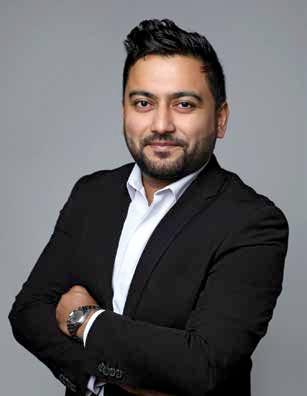
Director of Creative Strategy and Insights, Serviceplan Group Middle East
Today, data isn’t a relationship. It’s a negotiation. The nature of first-party data is changing in some categories, where the stakes are lower. When the rewards are real, people are willing to share. It’s not just about trust. It’s about the trade. Give them front-row access, exclusive deals, priority treatment, an experience worth bragging about, and they will happily share email, birthday and even their shoe size is yours. Brands need to understand: they will share if you dare. People don’t mind sharing their data; they mind sharing it for nothing.
If the rewards are juicy enough, if the perks are palpable, if the outcome is instant, people will hand over their shoe size, resting heart rate or even their driving licence number. Overall, data is great when it talks gains and vulnerable when it talks security.



Bestselling Author and Former Chief BusinessOfficer


5th Element’s Khaldoun Zaghir examines how GCC is poisitioned to lead the global digital out-of-home revolution.
By Khaldoun Zaghir, General Manager, 5th Element
The numbers don’t lie: Digital Out-of-Home (DOOH) advertising is experiencing unprecedented growth that’s reshaping the entire advertising ecosystem. Global DOOH market value surpassed $27.5bn in 2024, up from around $24.3bn in 2023, and is projected to exceed $74 bn by 2032. This isn’t just growth – it’s a fundamental transformation of how brands connect with consumers in the physical world.
What makes this particularly compelling is the velocity of change.
According to WARC, global investment in DOOH grew by 15.0 per cent in 2024 and is projected to increase a further 14.9 per cent in 2025, reaching $17.6bn. We’re witnessing sustained double-digit growth in a mature advertising market – a clear signal that DOOH has evolved from experimental channel to strategic imperative.
THE DOOH ECOSYSTEM
Traditional DOOH accounts for 94 per cent budget globally and in this region it is almost 98 per cent. Programmatic is an emerging trend but has many gaps. While programmatic DOOH has captured headlines globally, it’s important to recognise its current scale in the Middle East context. Programmatic represents approximately 2 per cent of GCC DOOH spending – a small but growing segment of what remains a predominantly direct-buy market.
The gradual programmatic adoption means that brands can focus on mastering DOOH fundamentals – creative optimisation, location strategy, audience understanding – without the complexity of automated buying platforms. The 98 per cent of spending flowing through traditional channels represents proven, relationship-driven approaches that deliver measurable results through established partnerships and market knowledge.
WINNING THE ATTENTION WAR
In an era of ad-blocking, banner blindness and privacy concerns, DOOH offers something increasingly rare: authentic, unblockable engagement. DOOH ranks among the top five channels consumers prefer, particularly because it involves in-person interaction, and is recognised as one of the top three channels capturing consumer attention most.
The technological sophistication driving this preference is remarkable. Modern DOOH campaigns leverage contextual intelligence – adapting creative content based on weather, time of day, local events, and even realtime traffic patterns, traffic trends and historical performance.

emerged as the undisputed leader in regional DOOH adoption, with digital formats representing an extraordinary 90 per cent of total out-of-home advertising spend in the Kingdom. This level of digital penetration is among the highest globally, positioning Saudi Arabia as a true DOOH-first market that has leapfrogged traditional static outdoor advertising. The Kingdom’s approach is particularly strategic.
In Saudi Arabia, there has been a notable trend towards the use of digital billboards in major cities such as Riyadh and Jeddah, with these digital displays offering advertisers the flexibility to change their messaging quickly and easily. This near-complete digital transformation means that brands entering the Saudi market must think digitally from day one – traditional static approaches simply don’t align with market infrastructure or audience expectations.
This flexibility aligns perfectly with Vision 2030’s emphasis on economic diversification and digital transformation, with the urban population reaching 30.36 million in 2022. Meanwhile, the UAE’s DOOH market represents a fascinating study in innovation and premium positioning. The UAE’s DOOH advertising market is expected to reach $54.7mn by 2030, growing at a CAGR of 8.9 per cent from 2024 to 2030.
What sets the UAE apart is not just market size, but market sophistication. The UAE is witnessing a surge in digital out-of-home advertising, leveraging advanced technology to engage consumers in innovative ways. Dubai, in particular, has become a testing ground for cutting-edge DOOH experiences.
The explosive growth of DOOH brings both opportunity and responsibility. As marketing budgets shift toward digital channels, accountability becomes paramount.
DOOH’s advantage lies not just in its reach, but in its measurability. Modern DOOH platforms provide real-time monitoring capabilities that traditional outdoor could never offer:
Impression verification: Proof-of-play technology that confirms when and where ads actually displayed.
Audience analytics: Detailed demographic and behavioural data about who engaged with campaigns.


Perhaps most significantly, DOOH addresses the industry’s biggest challenge: measurement and transparency. Research shows that exposure to any form of OOH advertising amplifies attention on private screens by 52 per cent. This ‘priming effect’ creates measurable lift across digital channels, solving the attribution puzzle that has long plagued outdoor advertising.


Cross-channel attribution: Tracking how DOOH exposure influences online search, social engagement, and purchase behaviour. : Understanding how external factors (weather,
Environmental context events, traffic) impact campaign performance


While global markets are embracing DOOH, the Middle East and North Africa region represents one of the most compelling growth stories. The MENA DOOH market is expected to reach $390.66mn in 2025 and grow at a CAGR of 16.41 per cent to reach $835.12mn by 2030.
This isn’t just about market size – it’s about market timing. The region’s unique characteristics create perfect conditions for DOOH adoption: Saudi Arabia has





messaging based on performance data, and provide stakeholders with

optimal attention rates? How do different creative approaches perform across various audience segments? This level of insight effectiveness over time. For regional leaders, the question isn’t whether to embrace DOOH – it’s how quickly they can scale

This transparency revolution is particularly crucial in the Middle East, where marketing leaders demand ROI accountability and performance justification. The ability to monitor campaign delivery in real-time, adjust messaging based on performance data, and provide stakeholders with granular reporting transforms DOOH from a brand-building expense into a measurable growth driver. The monitoring capabilities extend beyond campaign metrics to operational intelligence: Which locations drive the highest engagement? What times of day yield optimal attention rates? How do different creative approaches perform across various audience segments? This level of insight enables continuous optimisation that compounds campaign effectiveness over time. For regional leaders, the question isn’t whether to embrace DOOH – it’s how quickly they can scale their capabilities to match the pace of change while ensuring every campaign delivers measurable, transparent results. The brands that master this balance will gain not just market share, but the operational sophistication to thrive in an increasingly complex advertising landscape.


ensuring every campaign delivers measurable, transparent results. The brands that master this balance will gain not thrive in an increasingly complex advertising landscape.

If you’ve been around long enough in the real estate game, you’ll know that agents are always chasing leads. Buyer leads, seller leads and landlord leads – whatever brings in the next transaction and that all important commission.
But for those of us working in marketing, one truth becomes clear over time: the strategies that deliver the most meaningful outcomes rarely come from following the crowd. Real impact lies in identifying what truly works –and for whom – and, then, executing with intent.
At Bayut, we’ve spent years exploring how to better connect property owners with trusted professionals. What emerged was not just a campaign or a product – it was a shift in mindset. Rather than casting a wide net through generic marketing, we focused on individuals who had already earned their community’s trust through consistent performance.
This led to the development of TruBroker – a recognition system that highlighted agents who demonstrated real service, integrity and expertise. But the initiative didn’t end online. Instead of limiting visibility to digital rankings or platform performance, we brought these agents into the real world.
Rather than throwing money at generic out-of-home (OOH) campaigns and crossing our fingers, hoping that sellers would come knocking, we focused on something a bit bolder: empowering the agents who deserve the attention. We did this through prominent billboard placements across the city, top-tier leaderboard visibility and exposure designed to align with their professional strengths.
Interestingly, this approach challenged prevailing assumptions in marketing. We’re often told that traditional channels, including outdoor advertising, have lost their relevance in a digital-first landscape. But our experience proved otherwise: a wellplaced, strategically timed billboard can still foster trust, drive action and result
in direct seller enquiries. Agents who
reported increased contact from
in direct seller enquiries. Agents who were featured on billboards on major roads such as Sheikh Zayed Road, Hessa Street and Umm Suqeim Street reported increased contact from property owners who remembered seeing their face – not just from a search result, but from a moment in traffic.
As one consultant described it, the visibility became a catalyst – not only to generate leads, but also to build credibility.
We spoke to property consultant Rey Sadhwani at White & Co., who explained that ever since she attained the TruBroker status, her experience has completely transformed. She said that it has not only helped her build trust with sellers through authentic listings but has also significantly increased her exposure and supported her lead generation.
It’s worth pausing to consider what this tells us about trust in today’s property market. Securing a listing is rarely just about being available; it’s about being visible in the right way. Sellers are not only looking for an agent – they are looking for signals of reliability, consistency and local insight, who can get them what they want as soon as possible. And that’s exactly what the TruBroker badge represents.
Parmida Azizi, a senior property consultant at Ax Capital Real Estate reiterated this when she told us why becoming a TruBroker has been a game-changer for her career, explaining that it has significantly increased her leads and attracted sellers who want to list with her.
This wasn’t an accidental outcome. It was built on performance data, agent reputation and ongoing engagement with our platform. While the benefits for agents are clear – more quality leads, higher visibility and stronger personal brands – the wider impact on the industry is equally valuable. By spotlighting excellence, we help raise the standard for all.



“BY SPOTLIGHTING EXCELLENCE, WE HELP RAISE THE STANDARD FOR ALL.”
This isn’t simply a Bayut story, nor a one-off campaign success. It’s a case study of how backing the right people – those already delivering real value –can shift behaviours across the market. In an industry where awards can be bought, and recognition can be associated with tacky campaigns that show nothing but exchange of money, and where everyone is searching for the next lead generator, perhaps the more important question is: How do we support those who truly deserve the leads in the first place?
The results speak volumes. And, more importantly, they offer a glimpse of a real estate future that’s guided by trust, transparency and ‘earned’ recognition.
By Sahar Khan, Vice President of Marketing, Bayut
Bayut’s Sahar Khan shows how backing the right people – those already delivering real value – can shift behaviours across the market.
After nearly 18 years in the marketing and communications field, one thing remains clear: the landscape is always shifting. Every year introduces new tools, trends and technologies.
However, the real turning point came with the rise of social media, smartphones and, now, generative AI. What was once a structured and predictable ecosystem is now dynamic, fragmented and incredibly fast-paced.
In the GCC, marketing has become not only more thrilling than ever, but also more complex. Succeeding today takes more than creativity. It demands agility, technological fluency and a commitment to constant reinvention.
The marketing landscape in the GCC is evolving at an unprecedented pace. We’ve moved beyond broad, one-size-fits-all campaigns and long feedback loops. Today, we operate in real time – engaging with digitally savvy, well-informed consumers who demand relevance, responsiveness and authenticity from brands.
This new reality brings immense pressure and unlocks exciting opportunities for marketers. While tools and platforms will continue to advance, one thing is certain: as we evolve, new challenges will emerge. That’s why, for the foreseeable future, these are the four priorities I believe are essential to stay ahead.
The ROI imperative: Marketing as a growth driver – A key challenge facing marketers is quantifying the impact of their efforts to their shareholders. In a world where budgets are scrutinised more closely than ever, marketing can no longer be seen as only a creative or brand-building function – it has to be a growth engine.
Executives want conversion rates, not just narratives. That means marketers need to go beyond vanity metrics and prove how their work drives real business outcomes. The solution starts with alignment. Marketing objectives must tie directly into business goals, whether that’s customer acquisition, lifetime value or retention.
From there, it’s about measuring what matters and telling a compelling, databacked story. The more we can speak the language of return on investments (ROI), the more we elevate marketing from a cost centre to a strategic growth partner. Those who can show their impact will be the ones securing bigger budgets, influencing decisions and shaping the future of their organisations.
AI in action: From complexity to clarity – Managing modern digital campaigns is a juggling act. Multiple platforms, varying formats and constant optimisation – there’s a lot to keep track of. The manual workload alone can slow teams down and dilute impact. This is where artificial intelligence (AI) is stepping in as a transformative force. Not to replace marketers, but to empower them.
AI solutions are already streamlining several aspects from ad targeting and content creation to performance analysis and budget allocation. By automating repetitive tasks and surfacing actionable insights, AI allows marketers to focus on strategy and creativity. Predictive analytics can identify high-value customers before they convert, while real-time adjustments ensure campaigns stay on track.
We’re moving toward a world where end-to-end campaigns can be built, launched and optimised with just a few clicks – freeing up time and mental bandwidth for innovation.
“THE REAL OPPORTUNITY LIES IN DEVELOPING DATA FLUENCY ACROSS MARKETING TEAMS.”
Making sense of the data – Marketers aren’t short on data; they’re drowning in it. Clicks, impressions, open rates, bounce rates and conversion paths – we have all the data. But having this data and knowing how to use it are two very different things. Many teams still rely on instinct or isolated metrics instead of turning insights into strategy. The real opportunity lies in developing data fluency across marketing teams.
This doesn’t mean everyone needs to be a data scientist, but it does mean that they need to know how to ask the right questions and interpret the answers. That starts with building a culture that values insight over assumption. It also means investing in tools that make complex data easier to digest, and offering training that
Hyundai UAE and Genesis UAE’s Wassim Derbi shares what marketers need to prioritise to stay ahead for the foreseeable future.
empowers teams to act on what they find. In a data-rich world, marketers who can turn numbers into narratives – and action – will lead the charge.
Agility over perfection – The days of long planning cycles and static campaigns are behind us. In the GCC, where trends move at lightning speed and audience expectations evolve constantly, agility is more than a buzzword; it’s a survival strategy.
Success belongs to brands that are quick to test, fast to learn and brave enough to pivot when needed. Agile marketing isn’t about chasing every trend; it’s about building a flexible mindset.

It’s the ability to launch a campaign in a week, test five versions, and iterate based on performance without waiting for perfection.
The brands that thrive are the ones willing to move fast, learn on the fly and prioritise relevance over rigidity.
The future of marketing in the GCC is bright, but it will reward those who embrace change. It calls for a shift in how we think, work and lead. From proving ROI and mastering AI, to becoming data-literate and embracing agility, the demands on today’s marketers are high – but so is the potential for impact. This is an exciting time to be in marketing. Yes, it’s challenging, but for those willing to evolve, it’s also full of opportunity.
By Wassim Derbi, Head of Strategic Marketing and Brand Communication, Hyundai UAE and Genesis UAE



Campaign Middle East asks industry leaders about how multi-modal search experiences are evolving, and how marketers need to diversify and measure better within the search ecosystem.
By Anup Oommen
“Hey Siri, create a grocery list starting with …”
“Hey Alexa, what are today’s deals on …”
“Dear ChatGPT, where can I find …” “Yasmina, what’s that song with lyrics saying …”
The ways in which people search and shop are changing. People in the Middle East have switched from habitually opening default browsers on their devices to querying generative AI engines, virtual voice assistants and interactive chatbots.
Personalised recommendations, tailored discounts and product suggestions are now expected by mobilefirst and multilingual Middle East audiences – especially given that their multi-modal search has been layered with generative AI tools.
This has ushered in an era of ‘zero-click search’ – with answers being spoon-fed through artificial intelligence (AI)generated summaries. Add to the mix agentic AI, which are systems that act on behalf of users, and shopping agents, which autonomously compare prices, find discounts and ‘add to cart’. This has welcomed a culture that no longer requires consumers to manually hunt for deals. In short, the path to purchase is no longer linear or as textbook as the funnel would dictate.

Marketers are pivoting accordingly. Search specialists are being called on to become AI content strategists. Keyword optimisation and traffic-centric tactics are giving way to ‘answer engine optimisation’ (AEO). Brands – and the agencies servicing them – are no longer catering only to consumers; they are also attempting to ensure that their data and content appeal to algorithms and machines taking decisions on behalf of consumers.
MARKETERS MUST ‘LEARN PRONTO’ Campaign Middle East speaks to several industry leaders about the evolution of multi-modal search experiences, changing consumer search preferences, and how marketers need to measure better in the age of AI.
Terry Kane, Managing Director –Middle East and Africa, The Trade Desk, begins the conversation by
saying, “Search is moving beyond keywords, reshaping how consumers express intent. The challenge for marketers isn’t just to be present – it’s to stay relevant across channels with adaptive creative, rooted in durable identity and contextual insight.”
Najeeb Jarrar, Regional Marketing Director – Middle East and Africa, Google, adds, “Marketers’ key challenge now is recognising richer, more intuitive consumer interactions. This requires optimising for context and intent across input modalities, not just keywords. To simplify this: brands must ensure content is discoverable and understandable visually, audibly and across complex queries.”
With an aim to unleash the untapped potential of search through AI, Google revealed AI Overviews at its recent Google Marketing Live 2025 event, rolling out the tool across more than 200 countries and territories, with support in more than 40 languages, including in Arabic.
When asked about the speed of adoption of such search tools, Jarrar says that AI Overviews has already gained more than 1.5 billion monthly users globally, while Google Lens currently witnesses more than 25 billion visual searches each month, with a significant portion of users – up to one in every five – showing commercial intent.
Reacting to AI Overviews and new interfaces such as ‘io’, the AI device cooked up by OpenAI and former Apple designer Jony Ive, Laura Gleadhill, General Manager, Keyade Middle East, a WPP Media Brand, says, “These point to a screenless, conversational future. For marketers, this means content, product feeds and site structures need to be optimised for AI interpretation, not just search engines. The priority is ensuring your brand is eligible to surface in these new environments – not just be discoverable. Teams across search engine optimisation (SEO), paid and content must work together, and measurement needs to account for multi-surface, zeroclick interactions.”
The role of platforms is also changing. In 2024, approximately 64 per cent of Gen Z consumers used TikTok as a search engine, driven by the wealth of content available on the platform, according to an Adobe study.
In this context, Terry Mo, Head of Digital, OMD, raises some interesting questions: “How do platforms differentiate between real and AI-generated content? Are they willing

to fight the battle? Will regulation step in to combat this, or will the line be drawn naturally between platforms that pride themselves on engaging quality content and platforms that build their reputations on accuracy?”
As such, leaders agree that brands need to rethink their content strategies, especially in a culturally sensitive region. While aiming to achieve distinctiveness, brands must foray beyond keywords to embrace relevant elements across modalities.
“But this is easier said than done,” says James Dutton, Chief Product Officer, UM MENAT. “It requires staying culturally relevant by understanding nuanced, contextual conversations while adapting to


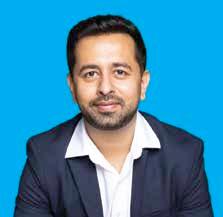






ever-changing AI-generated content, which is being blended with brand content.”
“Another key challenge is ensuring accessibility across all modalities,” Dutton says. “The concept of brand distinctiveness is important here, where clear value propositions and integrated experiences are created to meet heightened consumer expectations.”
Jarrar adds, “In this new era of search, success hinges on a deeper, humancentric strategy resonating with the region’s youthful, mobile-first population. This requires shifting from keywords to understanding user intent and creating highquality, culturally attuned and authoritative information – particularly in Arabic. For MENA brands, the goal is to be a trusted answer within intelligent search to build lasting brand affinity.”
However, to achieve this, marketers must welcome change and upskill on the go – quickly.
Sholto Douglas-Home, Chief Marcomms and Sales Officer, Expo City Dubai, says, “It’s clear this convergence of modalities will rapidly become the norm, but exactly how this will change the way content is tagged, loaded and optimised is something that we as marketers are having to learn – and learn pronto.”
Commenting on what marketers must prioritise learning, Douglas-Home adds, “In principle, it’s all about breaking down content silos, keeping on top of adtech developments, and designing for large language model (LLM) and intra-platform discoverability. That said, the reality is likely to be more fundamental in terms
of understanding changing human behaviour: people will be re-framing and re-orientating their search expectations by moving from ‘searching for an answer’ to ‘searching for inspiration’.”
Before we discuss what’s next, it’s important to acknowledge that search has been witnessing significant change – even before the dawn of generative AI.
OMD’s Terry Mo explains, “Knowledge graphs and search on social platforms have been taking a share of search activity from the established search engines, while more specialised queries have split off to platforms such as online travel agencies (OTAs) and retail e-commerce. Search specialists with a laser focus on Google Search have been shifting towards irrelevance, but specialists requiring understanding of consumer behaviour is more important than ever.”
With the advent of generative AI has come the ‘zero-click search’ era – an age when search queries result in definitive answers, not requiring further clickthroughs that were previously required by search engines that offered links to the most relevant results. Hence, ‘zero click’.

“This repositions the roles of search specialists,” Jarrar says. “Their focus must evolve from driving clicks to ensuring brand visibility and authority within AIgenerated summaries and multi-modal results. The goal becomes one of ‘more useful results’. Search specialists must delve deeper into content quality and how generative AI synthesises information. They will be instrumental in building genuinely valuable and informative content, encouraging engagement even without immediate clicks.”
With consumers favouring conversational queries and AI summaries, Deepak Mankani, Head of Search Experience, Merkle MENA, adds, “Specialists must optimise for LLMs, voice search and social platforms – all while maintaining the usual rigour on SEO fundamentals. As traditional search engine traffic is set to decline, new metrics such as AI share of voice and AI readiness will prioritise the search engine results page (SERP) presence and engagement over clicks.”
The notion that search specialists must shift from driving traffic driver to driving brand visibility is further cemented by
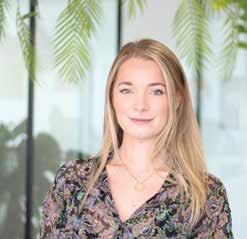
leaders who point to the fact that AI is increasingly answering questions directly in the SERP.
Keyade Middle East’s Gleadhill says, “Search specialists now need to optimise for presence within AI-generated content – not just for clicks. That means focusing on structured data, content relevance and technical hygiene. The role has become more strategic, sitting at the intersection of SEO, paid media, content and user experience (UX). Specialists need to shape how and where a brand appears, even when the user doesn’t land on the website – and redefine performance accordingly.”
UM MENAT’s Dutton takes this a step further, saying that search specialists will need to evolve from “keyword strategists” to “AI content architects”.
He says that search specialists will need to “craft structured content that is both discoverable by AI and engaging for human users, while also focusing on creating unique brand experiences that go beyond simple information retrieval to driving deeper connections and brand loyalty.”
He adds, “The future may hold a world where brand websites, as we know them, become obsolete – an era when it’s not just zero-click but also zero-page, and when AI manages most consumer interactions.”
Industry leaders also share that agentic AI will fundamentally change the customer journey and, by extension, the marketing playbook.
Gleadhill says, “Consumers will delegate tasks such as buying, booking or researching, and AI agents will make decisions based on structured inputs: availability, reviews, pricing and relevance. That shifts influence from the consumer to the algorithm.”
This shift challenges traditional marketing tactics. Visibility, trust and AI agentoptimised experiences have become a ‘must do’ for marketers because agentic AI tools are revolutionising brand interactions.
Merkle MENA’s Mankani says, “Brands must appeal not just to humans, but also to AI agents making decisions on their behalf. As agentic AI replaces passive models, success will depend on being discoverable, trusted and integrated into these new decision-making ecosystems.”
Gleadhill adds, “Marketers need to ensure their data, product feeds and content are clean, accessible and optimised for machineled evaluation. Messaging still matters – but technical readiness, operational agility and trust signals will increasingly determine if your brand gets picked.”
Additionally, agentic AI is also surpassing traditional reactive models, providing personalised and proactive engagement by anticipating user needs. It also offers tailored, real-time recommendations.
Dania Dallasheh, Business Director, Spark Foundry, says, “By autonomously gathering and analysing data, agentic AI grants brands deeper insights into consumer behaviour for more informed strategic development. This shift from reactive to proactive marketing drives brands to integrate these tools, crafting seamless and intuitive experiences.”
It’s no surprise, therefore, that agentic AI tools are reshaping the way brands connect with consumers in the digital age, and the way marketers are strategising and executing campaigns. For instance, Google’s Marketing Advisor – an AI-powered Chrome sidekick for marketers, announced in June 2025 and due to roll out later this year –is expected to offer real-time guidance, conduct business assessments and identify strategies across diverse properties, streamlining complex tasks and uncovering new growth opportunities.
Unlike traditional chatbots, Marketing Advisor will be able to proactively assess performance, recommend alternative strategies, and even apply changes across multiple business units. There’s no doubt about it: Marketing will need to not only embrace agentic AI but also learn how to engage with it.
Jarrar says, “From strategic planning and optimisation to reporting and troubleshooting, marketers will need to engage AI directly for holistic campaign management. This represents a significant evolution beyond traditional AI models, which have primarily focused on data analysis or content generation. Agentic capabilities, being integrated into platforms, aim to provide personalised
recommendations, insights and automate problem-solving.”
Expo City Dubai’s Douglas-Home goes to the extent of calling agentic AI a “game-changing opportunity for brand owners,” especially given that AI agents are becoming the ‘masters’ of personal shopping and customer service by handling autonomous, multi-layered and informed brand interactions.
He says, “Handled correctly, any AI agent delivering customer experiences that genuinely resonate with a brand’s values, messaging, tone of voice and principles will open the door to a holy grail of optimised marketing campaigns through ultra-niche personalisation and empathy on steroids.”
While eMarketer data reveals that the adoption and execution of such AI experiences still lags behind technological advancement, leaders share that companies such as Google that are deepening AI integration into their core products will catalyse the shift towards agentic AI.
However, industry leaders also caution that this shift should be built on foundations of trust and led by utility. With increasing consumer demand for personalised and seamless brand experiences, marketers need to wade carefully into the agentic AI realm, rather than diving in merely because the option exists.
OMD’s Mo says, “Consumers will shift to agentic AI if they trust that AI over the brand. For example, I might use an agent to book a holiday. But if I have a favourite hotel group, then will I use an agent on that brand’s website or will I use a commercially available agent to search for cheaper prices, acting like a modern OTA? That choice will depend on the individual consumer. The only wrong move is when a brand ignores the possibilities of agentic. That’s just bad customer experience (CX).”
Dutton adds, “We shouldn’t get bogged down ‘developing an agent’ but rather focus on leveraging the right environments to create meaningful consumer utility experiences.”
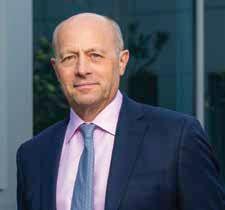
It also includes retail platforms such as Amazon and noon, social search on TikTok and Instagram, and AI-driven discovery through tools such as OpenAI’s ChatGPT and Google’s AI Overviews.
With marketers navigating fluctuating cost per click (CPC), new channels such as retail media and consumer demand for personalised recommendations are now forcing marketers to diversify and measure better.
Gleadhill says, “As CPCs rise on core search channels, marketers need to diversify within the search ecosystem – investing in retail media for high-intent moments, optimising feeds and product data for visibility, and using first-party signals to personalise experiences.”
She adds, “Measurement must evolve too: incrementality testing, margin-based metrics and cross-channel attribution are critical to prove what’s truly driving business results, not just clicks.”
Focus on the full funnel, from discovery to decision, ensuring a strong presence across all stages where consumers interact with information.
Dutton says, “This requires a shift from the popularity of lower-funnel, performancebased media metrics to holistic brand growth measurement frameworks that capture brand lift, cultural resonance, and the overall impact on brand health, enabling datadriven decisions that maximise return on investment (ROI) and build lasting brand value. Overcoming this challenge requires a focus on long-term brand building and a willingness to experiment with new measurement methodologies.”
If done right, this move from monitoring CPCs to holistic brand growth through new measurement methods could be just the medicine the industry needs to revive itself.
Spark Foundry’s Dallasheh says, “Leveraging data analytics and AI insights enables precise tracking of consumer behaviour and preferences, allowing more tailored personalised recommendations that collectively drive desired business growth. Implementing advanced attribution models facilitate more effective cross-channel impact evaluation, improving investment efficiency amid fluctuating CPCs.”
She adds, “By prioritising customer experience and engaging content across various touchpoints, marketers can now strengthen brand loyalty while adeptly measuring and adapting to the rapidly evolving marketplace.”




The truth of the matter is: Search has diversified far beyond Google and Bing.
diversified far beyond Google and Bing.















The Trade Desk’s Kane agrees, “Don’t chase CPCs. The key is to diversify and focus on goals and tangible outcomes. Retail media, connected TV and audio all work better when you have a unified view of your customers and their behaviours in real time across all these channels. Fragmented ‘disconnected’ campaigns are often a sign that the right tech stack isn’t in place.”
Kane also calls for marketers to leverage programmatic advertising for enhanced targeting, deeper insights into campaign performance, real-time optimisation, and personalisation at scale across the open internet.
Leaders also agree that marketers must: Embrace AI-powered ad products designed to reach users across new ‘inputs and outputs’ without requiring additional work; Prioritise high-quality data and comparable measurement to track true performance and optimise campaigns; and





Mo sums it up, saying, “CPCs were never a reliable metric, and any move we can make towards new measurement solutions is a win for the industry. Even brands and advertisers can shift focus to metrics such as brand lift and digital attention measurement, or use marketing mix modelling to measure the overall impact on business objectives.”
He adds, “The shift in conversation away from media metrics and towards business impact is one of the healthiest things to have happened to digital media for many, many years.”
All in all, marketers have their work cut out for them in the way they craft content and search strategies; embrace and engage with generative AI, agentic AI and shopping agents; and go the extra mile to connect with consumers calling for relevance, personalisation and memorable brand experiences.































At Bloomberg Media, we operate at the intersection of business, technology and storytelling, serving our audiences with content that will engage and resonate. As platforms proliferate and attention spans shrink, the challenge is no longer just visibility – it’s creating meaningful connections at scale.
To meet that challenge, we’ve developed a suite of proprietary artificial intelligence (AI) tools that decode complexity and surface actionable insights to inform smarter content strategies. From uncovering emerging themes to anticipating the priorities of global decision-makers, our data-driven intelligence tools, including AiQ, Brand Accelerator and Industry Accelerator, shape narratives that resonate with our audience and drive measurable impact for our partners.



AiQ aggregates editorial output from more than 150,000 publishers worldwide to map sentiment, track narratives, and identify whitespace, allowing brands to position themselves in places others haven’t yet reached.



In a region where innovation is being accelerated by policy, capital and ambition, staying ahead of the curve isn’t an option – it’s a necessity, writes Bloomberg Media’s Nicola Porter.


“We pair the precision of AI with the emotional intelligence of editorial craft to create content that informs, engages and performs.”

across platforms and across borders.


As AI tools advance, one truth remains: great stories move people. Today’s audiences, especially in fast-evolving, digitally native markets – such as here in the Middle East – aren’t just listening for what brands offer; they’re listening for what they stand for. It’s no longer enough to talk about values; brands must show them through actionable thought leadership and authentic storytelling. Audiences expect to see real impact – in society, the environment, and within their industries – and are more likely to engage with brands that align with their own beliefs.

Brand Accelerator evaluates how brands are currently perceived, surfaces market challenges and opportunities and offers data-led recommendations to strengthen positioning.
Industry Accelerator uses predictive analytics to anticipate what matters most to decision-makers in sectors such as finance, healthcare, energy and technology.


But technology is only as powerful as the humans behind it. AI is not a substitute for creativity; it’s an enabler. Our content development process is a close collaborative effort between our global data scientists and creative strategists. This partnership ensures that we are leveraging our AI tools with intent – to fuel creativity, unlock cultural insight, and understand the industries, topics and themes that most resonate with our audience, allowing us to craft stories that will connect.

In a recent Bloomberg Media study, which focused on the value of corporate reputation, respondents who prioritise business results over corporate reputation, as well as those on the other end of the spectrum, were united in their belief of the importance of thought leadership as an effective tool to positively influence a company’s reputation, with more than 70 per cent in agreement.
We use research studies to inform our approach – not only the content strategy at the front end of a campaign, but also to provide a continuous cycle of improvement and optimisation for our partners. We go beyond traditional performance metrics and conduct bespoke primary research that tracks changes in perception. This post-campaign intelligence measures the impact of our storytelling and how consumer relationships with the brand are shaped over time.
That’s why the human element is essential because, in an era of automation and acceleration, the most effective campaigns are rooted in insight, and designed to engage, educate and entertain audiences.



We pair the precision of AI with the emotional intelligence of editorial craft to create content that informs, engages and performs –

Technology will keep evolving but, in the end, the most powerful tools won’t win because they’re innovative; they’ll win because they help us do something timeless: communicate more intelligently, more meaningfully and more consistently to our evolving audience.
By Nicola Porter, Executive Editor, Bloomberg Media Studios


For more than a decade, performance marketers in the region have focused on one goal: ranking at the top of search results.
We’ve built search engine optimisation (SEO) strategies, refined keywords and optimised every page element to win attention. But that playbook is starting to feel outdated.
Today, we’re entering a very different reality. One where we no longer scroll pages to find results. Where generative AI tools such as ChatGPT and Google’s search generative experience (SGE) deliver a single, synthesised answer. If your brand isn’t part of that answer, you simply don’t exist. This change matters even in MENA, where Google holds more than 95 per cent of the search engine market share in markets such as the UAE.
Traditional SEO was about getting seen. Answer engine optimisation (AEO) and generative engine optimisation (GEO) are about being understood and trusted by machines. These engines don’t point people to your site. They absorb your online ecosystem content and summarise what they believe matters most. If your brand’s voice isn’t credible, clear and structured, it may never be included in that response.
This shift isn’t just technical. It’s also strategic. Brands that aren’t feeding these models with quality information will slowly fade from relevance. The challenge is no longer about search engine rankings. It’s about ensuring your brand is part of the knowledge base that powers AIgenerated answers. This change is especially important for our region. While global generative models grow more powerful, Arabic content remains underrepresented, limiting the accuracy and nuance of AI-generated answers for MENA consumers. This matters because the way people search is also evolving.
The voice and speech recognition market in the Middle East and Africa hit $2.39bn in 2023, with a projected 16.1 per cent compound annual growth rate (CAGR) until 2030. In Saudi Arabia alone, voice search usage is expected to cross 20 per cent of digital queries by 2025, driven by smart assistants and mobilefirst behaviours. Add to that the fact that 26 per cent of MENA consumers now use generative AI tools daily, with another 42 per cent using them several times a week, and you start to see the future forming in front of us. Our audiences aren’t just typing queries; they’re expecting direct, relevant answers. And while many companies are still testing AI, some organisations in the region have already integrated generative AI into at least one business function.
How should we respond? First, we need to rethink how we create content. It’s not just

Samsung Electronics – MENA’s Omar Saheb explains why marketers in the Middle East need to rethink visibility in the age of generative AI.
“ARABIC CONTENT REMAINS UNDERREPRESENTED, LIMITING THE ACCURACY AND NUANCE OF AI-GENERATED ANSWERS FOR MENA CONSUMERS.”
about producing more; it’s about answering real questions clearly and doing it in a way that AI can parse. That means using structured formats, anticipating user intent and simplifying language without losing depth.
Second, we need to update how we measure visibility. If someone asks a generative engine for a product recommendation and your brand is named in the answer, that’s impact. It may not show up in your web traffic report, but it shapes consumer perception. It’s time to build new key performance indicators (KPIs) around presence in AI-driven environments.
Third, agencies and partners need to evolve. It’s no longer about keyword bidding or link building. It’s about technical integration, using schema markup, building brand-specific data
sets and collaborating with platforms to ensure your brand is ‘understood’ by AI.
We’re hearing a lot of buzz about AI, but this isn’t just another trend. The way people discover and interact with brands is being redefined – even purchase journeys are changing. For MENA, this brings both challenges and opportunities.
We have linguistic complexity, rapidly evolving platforms and highly diverse consumer behaviour. But we also have the ability to leap forward.
Here are three actions that can make a difference now:
1. Prioritise Arabic-first content that is structured and credible;
2. Start testing across generative AI platforms to learn what works;
3. Invest in upskilling your teams on AI; from content to data to performance.
We need to start building trust with systems that will increasingly shape what people know, believe and buy. Populating the web with more content, reviews, articles and frequently asked questions (FAQs), and integrating it all will help. The question isn’t whether this shift is coming. It’s already here. The real question is: will your brand be part of the GenAI answer?
By Omar Saheb, Chief Marketing Officer – MENA, Samsung Electronics MENA

Hypermedia’s Philip Ma a shares his take on The Royals: Palm Jumeirah’s exclusive gateway to high-end advertising.
Not long ago, I stood on the edge of Palm Jumeirah, Dubai’s renowned man-made island, watching our team activate the last of six towering digital unipoles. I remember the feeling – this wasn’t just another advertising platform. It was a moment that captured what luxury advertising should feel like. No clutter. No noise. Just unmatched prestige, in one of the most iconic destinations in the world.
We call them ‘The Royals’. And there’s a reason for that. Advertising, especially in luxury, has always been a game of context. The right brand in the wrong place loses more than attention; it loses meaning. What we built at Palm Jumeirah is a response to that. A curated environment – zero clutter, and full impact. Not one other media asset stands within a square kilometre of these six digital landmarks.
Each screen rises 15 metres high, stretching 8 metres across, positioned with surgical accuracy at the entrance and exit to Palm Jumeirah – the driveway of the elite. The location attracts more than 30,000 high-income residents – some arrive in Rolls-Royces, others via yachts – Michelin-star diners, A-list celebrities, and global executives who don’t just consume luxury, but define it. These are not passing glances; they are purposeful audiences. And that’s where the real value lies.
use predictive mobility models, not guesswork. We map real exposure, not just footfall. And the result: Less waste, more impact.
But data is only part of the picture.
‘The Royals’ network wasn’t easy. We built it in one month. That’s unheard of. We overcame engineering headaches, logistical puzzles and regulatory labyrinths. We laid power lines under an island bridge. We negotiated with monorail operators and worked through sandstorms – at 2 am, under floodlights, with surgical focus. We didn’t cut corners. We cut through barriers. Why? Because luxury deserves better than ‘good enough’. As the industry keeps chasing bigger, faster and louder, I believe the future of luxury advertising will swing back to something quieter. Sharper. More intentional. ‘The Royals’ are a glimpse of that future.
In a city obsessed with luxury, we asked ourselves: How do you elevate a brand in a way that feels as rare and powerful as the brand itself? We found our answer in simplicity … and placement.
From the start, we made every decision with intention. From the elegant minimalism of the structure to the anti-glare lighting designed not to intrude but to compliment the Palm’s unique architecture. From sustainable construction materials to premium, energy-efficient LED screens that display only the most refined campaigns.
Luxury brands are selective for a reason. Their customers

Luxury brands understood this from day one. Chanel was first, followed by Bvlgari, Hermes, Tiffany & Co., BMW and Rolex. These aren’t just advertisers; they’re curators of culture. They chose ‘The Royals’ media network not because they needed another screen. They chose it because they needed a stage.


aren’t just advertisers; they’re curators of culture. They chose ‘The

Luxury doesn’t play games. It doesn’t shout. It doesn’t hustle. It whispers in the right places, knowing the right people are already listening.
We’ve seen more than 177 million monthly impressions. More than 428,000 unique high-value individuals have been reached. But that’s not the whole story. What matters more is the quality of those impressions. The intention. The exclusivity. These aren’t drive-by views. They’re premium engagements – measured, verified, optimised.
Thanks to our sister company DXTA Technology operating under the umbrella of W Group Holding, each campaign runs on audience measurement and data analytics. We






























Luxury brands are selective for a reason. Their customers don’t respond to volume. They respond to value, to context, to craft. A Chanel bag isn’t about stitching and leather. It’s about identity. The same goes for luxury advertising. And that’s what ‘The Royals’ give them: not just space, but significance. What’s interesting is how many people tell me that they remember exactly which brand they saw the last time they drove past ‘The Royals’. That’s rare. We’re so used to ignoring ads. But when the environment is curated, when there’s no clutter, people pay attention. They don’t just see the brand; they experience it. That’s the future of luxury media, if you ask me. It’s not about bigger budgets or louder screens. It’s about less, fewer distractions, sharper impact. It’s about creating room for prestige to breathe. Brands don’t need more space. They need better space. Focused space. Premium space. And above all, meaningful space. And that’s what ‘The Royals’ offer.


Luxury doesn’t play games. It doesn’t shout. It doesn’t to craft. A Chanel bag isn’t about stitching and leather. It’s about identity. The same goes for luxury advertising. but significance. What’s interesting is how many people tell me that they remember exactly which brand they saw the so used to ignoring ads. But when the environment is curated, when there’s no clutter, people pay experience it. That’s the future of luxury media, if you ask me. It’s not about bigger budgets or louder screens. It’s about less, fewer distractions, sharper impact. It’s about creating room for prestige to breathe. Brands don’t need more Premium space. And above all, meaningful
Philip Ma a, CEO, Hypermedia








Annalect UAE’s Dr. Hoda Daou shares her take on the hype of data monetisation and the ‘gold rush’ of 2025.
“It’s all about data” – a phrase we’ve heard often and, for the most part, believe. Data is at the core of nearly everything –information, analytics, insights and now the new currency of audience media buys, promising high commercial value for data owners and improved returns for advertisers. However, is all data truly valuable? How can we measure its value and ROI?
Many companies are aggressively pursuing data monetisation by locking into exclusive tech and data partnerships or even acquiring technologies such as clean rooms. The downside of these exclusive deals is their limiting effect on flexibility and objectivity, placing a premium on data whose value remains unproven. Each client or end-user has unique requirements and perception of value, making an agile and agnostic approach essential for success in this space.
MENA’S DATA CHALLENGE: HIGH STAKES, LOW SUPPLY In the MENA region, the challenges are pronounced due to limited data sources. Few companies have invested in the technologies required to collect and derive value from their data.
While many retail companies have established various initiatives such as loyalty programmes to gather data, making it actionable and addressable requires significant investment, resources and time. The eagerness to monetise this data often leads to overvaluation of datasets without a robust strategy in place.
The US data ecosystem has been evolving for more than 20 years, making it one of the most established globally – valued at $1.06bn in 2024. Characterised by advanced technology and robust infrastructure, the US leads in audience marketplaces offering advertisers access to rich audience data for precise targeting.
The diverse sources of data, including television viewership, online behaviour and e-commerce metrics, provide comprehensive consumer insights that enhance advertising strategies. Additionally, a strong regulatory framework ensures compliance with privacy laws which helps bolster consumer trust.
The abundance of data sources that are a result of decades of data collection mean that the price per
“IN EVERY DATA INITIATIVE, WE EXPLORE ALL ANGLES TO ESTIMATE VALUE BASED ON TANGIBLE OUTCOMES FOR ADVERTISERS.”
However, there is theory and there is reality. So far, tests have shown that success is not always guaranteed. As with any media campaign, optimising for certain key performance indicators (KPIs) doesn’t always lead to positive outcomes.
Audience buys often require additional investments beyond media buys, raising the question of whether they always drive a positive ROI.
Omnicom was among the first holding companies globally to establish an audience marketplace using neutral clean rooms, acquiring significant expertise in this space and building an understanding of the pitfalls and the delta between theory and reality. In every data initiative, we explore all angles to estimate value based on tangible outcomes for advertisers.
dataset is accessible – a simple supply and demand trend – keeping the price of buying this data reasonable when compared with the value extracted.
In our region, many companies have invested in data collection strategies. However, compared with the US, we remain shy in numbers because we started driving down this road approximately a decade after them. The datasets available are scarce; the price per dataset is high; and the value is yet to be proven. Is it reasonable for these businesses to anticipate a ‘gold rush’ from such data?
Some agencies have gone as far as building data ecosystems and operating exclusive datasets on behalf of data owners. While this model seems like a smart business exchange, it often introduces bias. Owning data can compromise neutrality, which is crucial for agencies aiming to prioritise advertisers’ best interests.
In theory, collaborating with a data partner who has access to detailed audience insights should lead to better performance and higher return on investment (ROI) compared with off-the-shelf platform audiences. This assumption attracts many advertisers and is the reason why many of them are seeking such capability.
For instance, in consumer packaged goods (CPG), revenue can be directly measured by the number of products sold to a specific audience. Whereas in automotive, the number of booked test drives can serve as an indirect indicator of future car sales.
At Omnicom, we prioritise protecting our data partners by ensuring they retain ownership of their data while establishing neutral grounds for the audience marketplace, owned, managed and operated by data owners themselves.
To best service our clients, we believe in a truly agnostic approach to data and technology, underpinned by testing and collaborating with a diverse range of data providers.
This strategy enables us to assess the value of data accurately before entering partnership discussions and allows us to offer a broad catalogue of audience options tailored to our clients’ unique needs.
No single framework has all the answers. Our open model equips us to develop adaptable, highperforming strategies that evolve with client priorities, avoiding the pitfalls of predefined partnerships.
While it is clear that data carries value, we are still early in this journey. An open, testing-oriented approach is essential for success in this space, allowing for informed decision-making before committing to large-scale partnerships.
By Dr. Hoda Daou, Managing Director, Annalect UAE
Hills Advertising’s Sami Al Mufleh calls for brands to cut through the noise, captivate audiences and own their own markets by merging data-backed out-of-home performance with boundary-pushing creativity.

In an era when consumers are bombarded with digital ads, out-of-home (OOH) advertising has re-emerged as a cornerstone of brand visibility. Its unmatched reach, noticeability and cost efficiency make it a critical channel – but when fused with bold creative innovation, it becomes a game-changer.
At Hills Advertising, we’ve proven that blending OOH’s performancedriven strengths with cutting-edge creative executions isn’t just a strategy; it’s a formula for dominating cluttered markets.
To thrive in today’s saturated media landscape, OOH campaigns must excel in two core areas: performance-driven precision and creative ingenuity. These pillars are not mutually exclusive; instead, they amplify each other to deliver campaigns that captivate audiences and maximise ROI.
Performance-driven foundations: The science of scale and efficiency OOH’s resurgence isn’t accidental; it’s rooted in its ability to deliver quantifiable results at scale.
Here’s how performance metrics redefine what OOH can achieve: Mass reach and frequency: In hyper-connected cities such as Dubai, where highways act as daily lifelines for millions, OOH bridges the gap between physical and digital attention. For instance, a bridge on the UAE’s Sheikh Zayed Road can deliver more than 40 per cent monthly reach of Dubai’s population, with an average frequency of more than 15 exposures per commuter per month, according to data provided by Streach. This repetition is critical: Studies show that consumers need approximately five to seven ad exposures before a message ‘sticks’. OOH’s ubiquity ensures brands stay top-of-mind.
Cost efficiency: There is a myth that OOH is expensive, but it is actually not. OOH boasts one of the lowest cost-per-thousand (CPM) rates in advertising – often 40 per cent lower than digital video campaigns. Unlike fleeting digital impressions, OOH offers prolonged visibility. For example, a single bridge banner on Sheikh Zayed Road can generate more than 4 million daily impressions at a much more efficient cost than paid social ads.
Measurable impact: Modern OOH is no longer a ‘spray-and-pray’ tactic. Advanced tools such as geolocation data, mobile retargeting and AI-powered analytics track metrics such as reach, frequency and impressions – even correlating spikes in website visits or app downloads. Streach by 7th Decimal has done an excellent job in that space by becoming one of the region’s most trusted OOH measurement entities.
Creativity that commands attention: The art of disruption
While performance metrics lay the groundwork, creativity transforms OOH from a static medium into an immersive experience. In a world of ad fatigue, audiences crave novelty. Here’s how innovative executions cut through the noise:
3D extensions: Sculptural elements that leap off the board, creating viral-worthy photo moments.
Die-cut designs: Unconventional shapes that disrupt the urban landscape
Neon and light integration: Illuminated visuals that dominate night-time traffic and social feeds. Neon-lit visuals or glow-in-thedark elements turn banners into 24/7 landmarks.
Static billboards are no longer enough. Audiences crave experiences, and creative executions such as these turn OOH into a canvas.
WHY THE SYNERGY MATTERS
The magic happens when performance and creativity intersect. Performance ensures that the right audiences see the message repeatedly, while creativity ensures they remember it. Consider this: Engaging OOH ads drive 2.5 times higher recall than standard billboards. At Hills Advertising, we have always been able to deliver in both those core areas.
We recently introduced ‘The Network’, a powerful, highwaycentric, large-scale network in the UAE. ‘The Network’ is engineered with strategic placements across prime highways, guaranteeing more than 60 per cent reach, more than 15 average monthly frequency and the lowest CPM available in the market today.
In parallel, our in-house creative team designs executions, under ‘The Landmark’ flagship, whether it is 3D designs, die-cuts, neon lights or full-frame branding, thus, turning commuters into participants.
THE FUTURE OF OOH IS HERE
Dubai’s skyline is a testament to ambition – and its advertising should be no different. By merging data-backed OOH performance with boundary-pushing creativity, brands can cut through the noise, captivate audiences and own their markets.
At Hills Advertising, we’re not just media planners; we’re experience architects. With our network of large OOH bridges as our backbone and creativity as our toolkit, we deliver campaigns that don’t just reach audiences – they resonate.
By Sami Al Mufleh, Founder and CEO, Hills Advertising

We’re living through one of the most profound transformations in marketing – on par with the rise of digital. What makes it both exhilarating and unnerving is the pace. The rules are being rewritten in real time, and the tools we rely on are evolving faster than most organisations can keep up with.
But here’s the thing – marketers were never meant to play it safe. Our role has always been to make sense of complexity, distill clarity from chaos and build meaningful connections with the world outside our walls. That role has never been more urgent – or more exciting.
As we look to the future of marketing, it’s time to move past the noise and anchor the conversation in three interconnected pillars: people, process and purpose. This isn’t just a framework; it’s a call to rewire how we think, lead and create impact.
PEOPLE: THE NEW MARKETER HAS ENTERED THE CHAT
The starting point isn’t technology; it’s talent. The marketers who will thrive in this new era are those who can unlearn as confidently as they learn; those brave enough to let go of familiar playbooks and embrace reinvention as a daily practice.
This doesn’t mean abandoning what’s worked; it means evolving it for a more fluid, complex world.
Today’s marketing talent operates at the intersection of multiple disciplines. We’re no longer just storytellers or brandbuilders. We are part technologist, part creator and part systems-thinker. We’re expected to move seamlessly between consumer empathy, data fluency, creative judgment and commercial impact.
It’s a big shift. And it won’t happen by accident.
We need to design for it – starting with mindset. That means letting go of legacy tactics that deliver comfortable metrics, and cultivating curiosity, experimentation and the confidence to challenge old norms. And it requires a different kind of leadership:
One that doesn’t just fund training, but models reinvention.
One that balances top-down clarity with bottom-up creativity.
One that sees people not just as executors of tasks, but as co-creators of transformation.
The future belongs to those who take ownership of their relevance – and who see AI not as a threat but as a tool to unlock deeper, more human creativity.
Let’s be honest: Many marketing processes still reflect a world that no longer exists. They’re designed for predictability, perfection, and post-rationalisation.
But today’s reality demands speed, flexibility and the courage to test in public. AI is already reshaping the operating model, starting with the repetitive and the manual.
Property
Finder’s Sevgi Gur discusses the transformation within marketing – one that is humancentric and AI-driven – while calling for marketers to lead with vision, velocity and values.
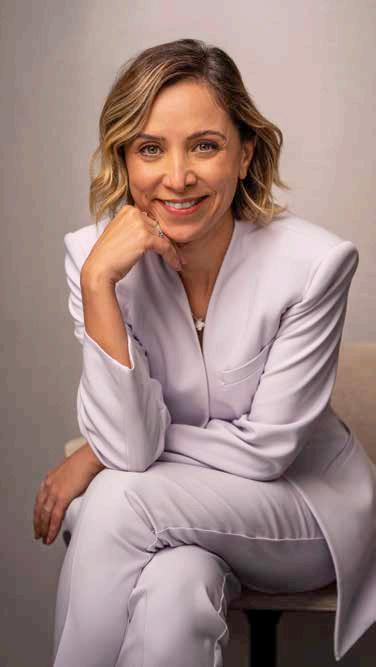
From transcribing meetings and resizing creative to drafting briefs and surfacing insights –automation is quietly reclaiming hours we didn’t realise we were losing. But here’s the question: what will we do with that time?
This is the moment to reclaim our strategic and creative depth. To move from reactive, campaign-led cycles to proactive, brand-building systems. To stop chasing impressions – and start designing for real impact.
Agility is the buzzword, but responsiveness is what we really need. That means:
Creating faster, tighter feedback loops with customers.
Building cross-functional teams that bring together tech, brand, and commercial thinking.
Using AI not just for content creation, but for insight discovery – surfacing patterns we’ve missed or simulating future scenarios with confidence.
The marketing process is no longer a straight line from brief to launch; it’s a living, breathing system. And our job is to shape it – with intention, not inertia.
THE
In a world of infinite content and infinite scroll, the brands that stand out won’t be the loudest; they’ll be the ones anchored in something real. Yes, AI has made it easier than ever to create, scale and personalise. But if the core of your brand lacks clarity, consistency or conviction – technology will only amplify the noise.
Now, more than ever, we need to be crystal clear on who we are, what we stand for and why we matter in people’s lives. Purpose isn’t a slogan or a seasonal campaign. It’s the strategic engine that guides decisions, inspires creativity and ensures consistency across the full customer journey.
When embedded deeply, purpose becomes the glue between your brand, your business and your audience. It brings focus to innovation. It helps teams prioritise. It offers something bigger to believe in than quarterly KPIs. And, perhaps most importantly, it helps us resist the gravitational pull of every new trend or tool. Because while the landscape will keep shifting, your purpose is the constant that keeps you moving in the right direction and helps you create value for your business, your consumers and customers.
MARKETING AT AN INFLECTION POINT
This is not the time for marketers to shrink back. This is the moment to step forward. Yes, the pace is relentless. Yes, the change is real. But this is also the most energising time to be in marketing – for those ready to lead with vision, velocity and values.
The future of marketing isn’t a tech story. It’s a human one. And we get to write the next chapter.
By Sevgi Gur, Chief Marketing Officer, Property Finder
Initiative UAE’s Yasmine Hussein on why algorithms need cultural intelligence.
As AI transforms media planning across global markets, the MENA region presents a compelling paradox. On one hand, the region is witnessing a surge in artificial intelligence (AI) and automation, driven by a mobile-first population and governments investing heavily in digital transformation. On the other, its cultural complexity – spanning diverse languages, dialects, traditions and sociopolitical sensitivities – demands a more nuanced, human-centric approach to media strategy.
THE PROMISE AND THE PARADOX
AI’s potential in MENA is already materialising in meaningful ways. Leading telecom companies in Saudi Arabia, for example, are dynamically adapting media investments around cultural tentpoles such as Riyadh Season and Saudi National Day, using AI to optimise placement, content and timing. These are not ‘one-size-fits-all’ campaigns. They are highly responsive, tailored initiatives made possible by machine-driven data processing and prediction. Similarly, UAE banks and telecom operators are leveraging AI to deliver highly personalised, multilingual campaigns that track and adjust performance in real time. These organisations are not just reducing media wastage; they are achieving cultural relevance and responsiveness at scale. But here’s where the paradox emerges: the very complexity that makes AI useful in MENA – scale, multilingualism, platform fragmentation – also exposes its limitations. Algorithmic models, regardless of sophistication, lack cultural fluency. For example, they can process data about Ramadan, but they can’t understand the emotional weight of family gathering moments. They can optimise for Arabic keywords, but they miss the cultural subtext that determines whether a message resonates or offends.
This tension between technological capability and cultural complexity isn’t a problem to be solved – it’s the new operational reality for media planning in MENA. Agencies that recognise this paradox early are positioning themselves to leverage AI’s strengths whilst maintaining the human insight essential for meaningful audience connection.
The next evolution of media planning in MENA is about architecting integrated systems where cultural intelligence guides algorithmic precision. The most successful media strategies emerging across the region share a common characteristic: they’re built on structured partnerships between human intelligence and AI capabilities, with machines excelling at processing vast datasets, automating performance reporting, and enabling real-time optimisation, whilst humans focus on strategic thinking, cultural interpretation, ethical decision-making, and long-term brand stewardship. Consider the practical reality of programmatic media buying during cultural moments such as Eid or National Day celebrations. AI systems can instantly analyse millions of bid opportunities, optimise spending
“Success requires knowing not just who the audience is, but what they value, how they interpret messaging and why cultural context shapes every interaction.”
across platforms, and adjust creative rotation based on performance metrics. But determining whether a particular creative approach respects cultural values, resonates with family dynamics, or aligns with local celebration traditions requires human judgement informed by deep cultural understanding.
Media planners in the region aren’t simply trafficking impressions or optimising cost-per-acquisition metrics. They’re navigating an intricate cultural ecosystem that demands localised storytelling, ethical consideration, and nuanced audience understanding.
Success requires knowing not just who the audience is, but what they value, how they interpret messaging, and why cultural context shapes every interaction.
This cultural complexity creates a significant competitive advantage for agencies that understand it. Brands treating AI purely as a cost-saving tool inevitably lose ground to those leveraging it as a capability multiplier. The winning combination pairs AI’s speed, precision, and scalability with human cultural depth, ethical accountability, and strategic vision.
THE INTEGRATED APPROACH
Winning agencies across MENA are those simultaneously investing in both advanced AI tools and exceptional talent. Rather than deploying AI to replace planners, they’re developing intelligent systems that eliminate routine tasks, empowering their teams to concentrate on strategic thinking and cultural insight.
This integration manifests in several ways:
Hybrid team structures: Data scientists work directly alongside strategists and media planners, ensuring technical capabilities align with cultural insights from project inception.
Cultural training datasets: AI systems are trained not just on performance metrics, but on cultural relevance indicators, consumer behaviour patterns and local market nuances that influence campaign effectiveness.
Human-guided machine learning: Feedback loops enable experienced planners to shape algorithmic learning, ensuring AI systems evolve with both cultural sensitivity and performance efficiency.

THE BOTTOM LINE

where each elevates the other. A future lands meaningfully, ethically,




Holistic success metrics: Campaign evaluation extends beyond clicks and conversions to include cultural impact, brand relevance and audience connection.

AI, on its own, cannot build meaningful relationships with audiences. It can help deliver messages, but it cannot shape them. That remains the domain of planners, creatives, and strategists. And in a region as evolving and culturally rich as MENA, that human element isn’t optional – it’s essential. Ultimately, this is not about choosing between human or machine; it’s about designing an integrated system where each elevates the other. A future where AI drives scale and efficiency, whilst human intelligence ensures it lands meaningfully, ethically, and effectively.
By Yasmine Hussein, General Manager, Initiative UAE





































HAVAS Red Middle East’s Palak Mehta calls for the industry to stay curious about AI, anchor every use case in human tension and let empathy guide each decision.
Afew months ago, social feeds overflowed with selfies reimagined as dreamy Studio Ghibli cartoons. Millions of people produced and shared these images in hours, without design teams or media budgets. That ‘Ghiblification’ wave showed how culture moves at a pace traditional workflows cannot match.
For communicators, the question is no longer whether artificial intelligence (AI) matters, but how fast we can fold it into the craft without letting go of human intelligence that makes ideas resonate.
PR has always thrived on spotting tension, shaping narrative and delivering relevance in real time. What has changed is the gap between the spark of an idea and the moment it reaches an audience. Generative tools have bridged that gap. A single prompt can turn a headline into a

storyboard. A quick voice-clone can place a familiar personality at the centre of an activation. AI not only removes the friction that previously slowed judgment; at times, it replaces judgement altogether.
Consider how the Australian Northern Territory launched ChatNT to reframe the perception of their low travel season. The team trained a conversational bot on broadcaster Abbie Chatfield’s speech patterns and regional travel data, then let visitors ‘chat’ with Abbie for bespoke itineraries. This approach worked because it solved a real tension – travellers’ doubts about holidaying in tropical heat – while delivering service in a voice people already trusted. Web dwell time surged and intent to book rose, proving that a smart AI layer can convert curiosity into action when the story feels personal.
Another example comes from Lenovo’s Meet Your Digital Self initiative. Life-size avatars built from volunteers’ social footprints invited families to talk with a mirror image of their online persona. The experience turned abstract worries about digital identity, into a tangible moment that earned headlines across tech, health and lifestyle media. The lesson is not the novelty of the software, but the clarity of the insight: people struggle to bridge the gap between real and online selves, and an AI-enabled demo made that struggle visible.
Both cases follow the same sequence. First, isolate a tension that matters to a defined community. Next, prototype a creative answer at speed. Finally, let audiences experience the answer before the conversation moves on. AI supplies the mechanics; emotional intelligence supplies the meaning.
Speed by itself is meaningless if the work misses the mark. That is why the most effective teams pair generative creativity with fast, accurate audience insight. Within HAVAS, the Converged operating system does exactly that by drawing together first-party data and large-scale research signals in a single interface. A planner can pull a persona such as ‘UAE professionals who value work-life balance and follow tech founders on LinkedIn’ in seconds, test two headline options, and watch predicted
reach and cost shift in real time. For PR leads, this means message testing happens during conception, not after launch, and the same dataset guides earned, paid and owned decisions.
A streamlined workflow brings two benefits. The obvious gain is time: campaigns that once took weeks to move from concept deck to market now accelerate in days. The deeper gain is confidence. Legal and corporate-affairs teams can see every data source used to build a persona and approve language before it goes public, reducing the last-minute edits that drain momentum from bold ideas.
Yet none of this diminishes the need for human craft. AI cannot read a room, sense cultural fatigue or decide when silence is wiser than speech. Audiences still judge authenticity by tone, context and timing. A generative image may catch the eye, but it is the nuanced message behind that image that earns trust. The future of PR is not about turning communicators into coders. It is about equipping communicators with faster tools while preserving the discretion that guides when to use them.
MEANINGFUL PROGRESS DEMANDS AMBITION AND RESPONSIBILITY
AI is powerful, but it is also fallible. Algorithms inherit the blind spots of their training data, so unchecked output can reinforce stereotypes or silence voices. Bias tests, diverse review panels and clear opt-out paths are practical safeguards, yet accountability always rests with the people who deploy the tool, not the code itself.
With those guardrails in place, artificial intelligence removes the ceiling on what communicators can imagine and deliver. We shift from storytellers who merely pitch ideas to partners who can prototype, test and launch them in a single sprint.
The brief is simple: stay curious about AI, anchor every use case in human tension and let empathy guide each decision. AI is not replacing us; it is handing us a wider canvas, a shorter path from insight to influence, and a stronger voice in shaping culture.
The advantage belongs to the teams ready to claim that canvas before someone else does.
By Palak Mehta, Communications Director, HAVAS Red Middle East
AiOO’s Hammad Benjelloun discusses the Dubai-born technology for smarter, more responsive and ‘conversational’ public screens.
We’ve digitised everything: Television, radio, retail and, even, fridges. But despite the onward march of pixels across cityscapes, out-of-home (OOH) media has remained frozen in time. Screens got flashier, but not smarter. They still broadcast the same message to everyone, regardless of who’s walking by.
That’s the gap AiOO is closing.
BUILT FOR THE REAL-TIME CITY
AiOO isn’t a dashboard; it’s an ecosystem. At its core is Audience-Eye, an anonymised audience intelligence engine that analyses and understands in real time the audience present in front of a screen, demographics, behavioural signals and intent clusters.
No facial recognition. No tracking. Just smart, privacy-first audience data that turns public space into engaging contextual media.
This engine powers real-time content and campaign delivery decisions. The moment someone steps into view, AiOO decides what message they see. It’s media that adapts to people, not the other way around.
And this isn’t vapourware. AiOO is already live across Dubai’s metro, malls and supermarkets. Screens are reacting. Campaigns are learning. Audiences are being addressed, not assumed.
THE DUBAI ADVANTAGE
AiOO was born in a city that doesn’t prototype slowly. Backed by 25 years of legacy from W Group Holding and first deployed across Hypermedia’s vast digital-out-of-home (DOOH) network, the tech reflects Dubai’s broader philosophy: build fast, scale globally.
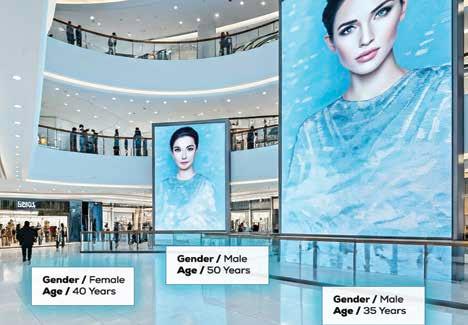

“With AiOO, advertisers aren’t just buying media, they’re bidding on live, verified qualified audiences.”
But AiOO isn’t stopping at the city’s borders. Through its global SSP infrastructure, AiOO is rolling out internationally, giving agencies and advertisers worldwide access to real-time audience-targeting at urban scale.
This is Dubai’s smart city playbook, exported.
FROM SCREENS TO SIGNALS: A NEW MARKETPLACE
With AiOO, advertisers aren’t just buying media, they’re bidding on live, verified qualified audiences.
The platform’s Campaign IQ engine uses behavioural clustering and predictive modeling to automate standard and programmatic DOOH (pDOOH) campaigns, planning and delivery.
AiOO and SSP dynamically price impressions based on audience composition and demand, turning fleeting urban attention into a liquid, measurable asset.
It’s not about slots. It’s about moments.
WHY IT MATTERS
In a world where AI can spin up ad creatives in seconds and target people across applications and devices, it’s absurd that the physical world still broadcasts like it’s 1999.
AiOO closes that loop. It makes the public screen responsive. Alive. And, ultimately, it reimagines what a city can be.
Not just smart. Conversational.
By Hammad Benjelloun, CEO, AiOO
We spend weeks crafting neat narratives in fancy fonts to convince executives and clients that we’ve got it all figured out. Top-funnel, mid-funnel and bottom-funnel; awareness, consideration and conversion – all beautifully packaged and confidently presented. Throw in a few icons, a funnel diagram that looks suspiciously like the one from 2012 and, voilà, ‘the plan’ emerges.
Let’s get real: Your perfectly symmetrical funnel doesn’t reflect how anyone actually buys. People don’t move through your ‘customer journey’ like obedient little pixels. They jump around, pause, restart, forget and remember again six months later because of a random Instagram Reel.
By then, your attribution model is confused. And your strategy? It’s off pretending it worked exactly as planned. Spoiler alert: it didn’t.
The industry doesn’t write strategies to work; it writes them to impress rooms. It has 45-minute decks filled with buzzwords such as ‘omni-channel presence’, ‘customer-centric AI driven journeys’ and ‘holistic strategy’. Honestly, I dare you to explain any of them clearly.
Artificial intelligence (AI) is here. Not coming. Not maybe. Not ‘being explored’. It’s already writing headlines, resizing creatives, generating media plans and auto-optimising budgets faster than your client can ask, “But can we get more impressions?”
However, AI still needs inputs. And right now, we’re feeding it broken ones. If you feed AI the wrong metrics, it will deliver those bad metrics perfectly. If you feed it outdated funnel logic, you’ll just get outdated results faster.
We’re handing our strategies to AI-powered platforms, expecting them to follow instructions that barely make sense in the real world. AI doesn’t need better prompts. It needs better logic. And that logic must be built around systems, not static plans.
This isn’t about throwing strategy out the window. Strategy still matters. But the way we build and apply strategy needs to evolve. Massively.
Right now, we treat strategy like sculpture. Chip away, shape it, present it and then walk away until next quarter. What we need is strategy that behaves like a system.
Think about your most effective campaigns. The ones that got better over time and outperformed benchmarks week after week. I’d bet they weren’t the ones where the PowerPoint was flawless; they were the ones where the feedback loop
Fusion5’s Fadi Sader shares why marketing strategies need a system, not a show.

was fast – where the team adjusted quickly, where the creative got better and where the system learned.
That’s the shift. We need to stop setting and measuring and start designing and responding.
If your strategy doesn’t include a real-time feedback mechanism, it’s not a strategy – it’s hope, disguised as a PowerPoint.
We don’t need more marketing managers. We need marketing engineers, people who can: Test continuously. Adapt in real-time.
React to behaviour, not assumptions. Scale what’s working, kill what’s not.
CMOS OF THE FUTURE WON’T BUILD TEAMS. THEY’LL DESIGN SYSTEMS AND AGENTS
OpenAI, Zapier, Replit, n8n - these tools aren’t ‘trendy’. They’re the new talent and, soon, chief marketing officers (CMOs) won’t manage departments. They’ll design intelligent growth systems.
They’ll behave more like chief technology officers (CTOs). Not approving every headline or call to action (CTA), but defining architecture, choosing agents and building loops.
Because today, one skilled marketer can fill five roles – from designing creative to campaign launch. That’s not in the future. This is today’s reality.
And yet, most organisations still operate like it’s 2015. The ones who evolve will ask: What agents do we need in our stack? What data is fuelling our loop?
How do we scale without adding headcount?
Agencies that adapt will thrive. Agencies that don’t? You’ll be managing someone else’s GPT agent while pretending it’s ‘collaboration’.
The scary part is that marketers love control. We believe that with the right plan, we can predict outcomes. But control is an illusion.
You can’t predict which creative will land next week. You can’t plan your way to a viral hook. You can’t guarantee that your ‘big idea’ will outperform your test ad. The only thing you can control is the system you build.
If your system can learn, adapt and scale on its own, you don’t need to hold on to control.
You just need to observe, adjust and feed it better inputs.
Yes, sometimes your AI-driven system will deliver something weird. And yes, sometimes that weird thing will outperform your hero creative. That’s not failure; that’s feedback. And that’s not chaos; that’s performance.
Marketing isn’t theatre anymore. It’s engineering.
If you’re still clinging to your funnel, you’re basically holding on to your Blockbuster card in the Netflix era. Sure, nostalgia feels safe. But growth feels better.
You don’t need a better strategy; you need a smarter system. And the nerve to trust it. Forget funnels. Forget decks. Build systems that outlearn your competitors, and maybe even you.
By Fadi Sader, Head of Growth and Performance Marketing, Fusion5


TKINESSO’s Karthik Kumar shares why marketers must break silos, embrace agility and rebuild trust to stay ahead.
he media and advertising industry is experiencing a significant change, driven by artificial intelligence (AI), changing consumer expectations, regulatory developments and rapid advancements in technology. We are entering a new era where marketing is not just automated; it is truly intelligent, integrated and inspiring.
The modern marketing landscape has a critical flaw: data fragmentation. Enterprise-level insights remain trapped across martech stacks, customer relationship management (CRM) tools and media platforms, slowing decisions and reducing effectiveness. The solution: intelligent, cloud-based systems that centralise disparate data sources. Enhanced with AI and machine learning, these platforms deliver real-time, actionable intelligence at scale. INTERACT is a prime example of this transition – an AI-powered marketing platform that serves as the core system for modern marketing. It brings together identity resolution, real-time segmentation, analytics and activation into one integrated environment, enabling faster, smarter and more precise campaign execution.

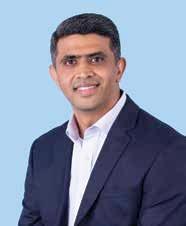
Enable dynamic, cross-channel activation spanning paid, owned, and earned media.
This agile approach transcends operational efficiency – it enables brands to maintain competitive agility, responding swiftly and intelligently to platform changes, evolving consumer behaviours, and regulatory compliance requirements.
Creativity remains marketing’s cornerstone, yet AI has become its most powerful catalyst. Generative AI tools such as ChatGPT, Sora and DALL-E are transforming content creation – from automated copywriting to localised video production and adaptive design.
These tools enable teams to rapidly test creative variations, scale personalisation and adapt brand storytelling whilst maintaining strategic coherence and creative excellence.

“While 77 per cent value AI’s convenience, human connection drives results –community-led experiences boost brand retention by 67 per cent.”
According to Acxiom’s Top 5 Customer Experience (CX) Trends for 2025, while 77 per cent of consumers value the convenience that AI delivers, the fundamental human need for authentic connection remains strong. Brands that prioritise community-led experiences are witnessing retention increases of up to 67 per cent. Today’s AI and machine learning unlock granular audience insights, predictive modelling, and personalised content. As brands pivot to audience-first, identity-based strategies, we’re witnessing a decisive shift from third-party cookie dependency to privacy-focused systems. By blending deterministic and probabilistic data signals, forward-thinking brands across diverse industries now identify high-value audience segments and engage them with precision across every customer touchpoint.
The traditional marketing funnel has become obsolete in today’s dynamic marketplace. Contemporary consumer journeys are fluid and nonlinear, requiring real-time decision-making. Leading brands are now deploying comprehensive, AI-powered frameworks that: Integrate first-party data from customer data platforms (CDPs), CRMs and digital platforms.
Leverage predictive modelling to create lookalike and highvalue segments.
Incorporate real-time behavioural signals to evaluate purchase intent and optimise engagement timing.
When AI, predictive analytics and creative insight converge, static campaigns become dynamic, self-optimising ecosystems where messaging continuously adapts based on real-time audience engagement and behavioural insights.

As technological innovation accelerates, regulatory frameworks and ethical standards are evolving with equal urgency. Across the Middle East, North Africa and Turkey (MENAT) region, data protection legislation – including the UAE’s DIFC Data Protection Law and Saudi Arabia’s Personal Data Protection Law – is advancing rapidly. Yet a critical disconnect persists: whilst 98 per cent of consumers know their data is collected, only 57 per cent understand how it’s used.
This trust gap demands action. Brands demonstrating transparency and responsible data stewardship build deeper consumer confidence. Research reveals that 78 per cent of users trust brands that provide clear, accessible communication about their data policies and practices. Success requires robust data governance, privacy-centric design, and ethical AI implementation. Addressing the talent gap in data science and AI demands sustained investment in skills development and organisation-wide AI literacy programmes.
Success will no longer be defined by who possesses the most data, but by who leverages it most strategically. To lead in this transformative era, brands must act now: embed AI into the core of their strategy, build connected ecosystems, and equip teams with the advanced tools and specialised talent necessary to drive meaningful change. This is not a time for incremental shifts – it’s a moment for bold transformation.
The future of marketing isn’t merely automated – it’s intelligent, interconnected, and genuinely inspiring.
By Karthik Kumar, Managing Director, KINESSO - MCN MENAT
Leaders from Arabian Automobiles Company, Petromin Corporation, TBWA\RAAD, Socialize/We Are Social and Cicero & Bernay explore how AI influencers are shaping a new era of authentic and relatable marketing.
By Hiba Faisal
Forget everything you thought you knew about influencers. Turns out, brands are leaning into ones that don’t drink matcha, go on sponsored retreats, and don’t even exist – at least not in the traditional sense.
In today’s digital-first landscape, some of the most compelling brand voices aren’t human at all. They’re virtual, coded brand ambassadors.
Welcome to the age of the AI influencer – where storytelling is more nuanced and a glitch might just be what it takes for humans to find the ‘humanity’ in AI.
After Campaign Middle East’s On the Record video podcast welcomed AI influencers to its studio, one thing became clear: these digital darlings aren’t just passing fads or virtual novelties.
To better understand how AI influencers are rewriting the rules of engagement, storytelling and brand loyalty, we asked regional marketers and agency leaders: What makes an AI personality resonate with audiences in an authentic way? Do they serve a purpose beyond mere short-term campaign tools?
THE AUTHENTICITY DILEMMA
Over the past year, one of the many buzzwords that has echoed across the industry is authenticity. To achieve authenticity, brands have attempted to push past polished perfection and build meaningful connections with communities. But the authenticity dilemma arises when a solution that’s intrinsically ‘inauthentic’ resonates authentically with audiences.
Tony Kayouka, Head of Social and Content, TBWA\RAAD, explains, “Let’s get this out of the way: AI influencers aren’t authentic, and they don’t need to be. The best ones don’t pretend to be real. They’re believable because they’re designed with intent. That’s what today’s audiences respond to; not another hyper-polished avatar, but a personality that’s flawed, specific and sometimes even contradictory.”
Building on the ‘imperfect by design’ narrative, Nizar Malaeb, Marketing Director, Arabian Automobiles Company (AAC), says, “With AI influencers becoming a fixture across social platforms, audiences, especially Gen Z or younger millennials, expect more than polished avatars and curated feeds. They want honesty and a sense of connection from any online voice, whether human or not.”
What then does it mean to be ‘authentic’?
Mousa Nimer, Account Director at Cicero & Bernay, says, “Authenticity isn’t about being human as much as it is about being believable.”

Kayouka adds, “It’s not about tricking people into thinking it’s human. It’s about making the character compelling enough that they care anyway.”
As a result, several brands have embraced imperfection in the pursuit of what is relatable to their hyper-local audiences in the region.
Explaining how this imperfection is achieved, Malaeb says, “Human writers and community managers must shape each AI persona to sound natural, adding pauses, slang and even small mistakes that echo real speech.”
Nimer adds, “A little quirk here, an intentional flaw there … it’s like digital botox with just the right amount of asymmetry. Consumers don’t want avatars that look like they live in an airbrushed alternate reality. They want voice, nuance and, yes, maybe even a glitch or two. That’s where marketing meets meaning.”

Kayouka says, “Great AI personas lean into bias, hesitation, irony: all the things that give them texture. Authenticity doesn’t come from looking real. It comes from being written well. In this space, taste matters more than tech. And story beats symmetry every time.”
However, for brands to build true credibility, they also need to be transparent about the artificial nature of AI influencers –and own that narrative.
Hussein M. Dajani, Group Chief Marketing and Customer Centricity Officer, Petromin Corporation, says, “Brands are implementing radical transparency by clearly disclosing AI origins while developing virtual personalities that engage meaningfully with local communities around social causes and cultural interests.”
Malaeb adds, “Instagram and TikTok now offer ‘AI-generated’ labels. Followers know exactly what they’re seeing. Brands that are straightforward, tend to earn more trust and engagement. Companies can answer the authenticity challenge by being upfront about what’s real and what’s not.”
The critical piece here is that although the AI influencers are artificial, the values they communicate and the way they are curated are so human driven that they come across as authentic ‘avatars’ of brands.
Akanksha Goel, Founder and CEO –Middle East, Socialize /We Are Social adds, “It’s never just AI - it’s always AI and human. The best outputs don’t come from tools; they come from teams with taste. As creative leaders, our job is to shape, not just scale. AI lets us build faster, but it’s human insight, intuition and cultural intelligence that make it believable, even memorable.”
Malaeb explains, “Virtual ambassadors work as part of a larger brand story, shaped by ethical guidelines and managed by real people. This mix of transparency and genuine human input makes AI influencers credible, even when everyone knows they’re artificial.”
DO AI INFLUENCERS HAVE A BEATING HEART?
Apart from authenticity and transparency, leaders also say that to truly connect with core audiences, brand ambassadors such as AI influencers need to be culturally relevant.
As Kayouka puts it, “What matters isn’t realism; it’s resonance. Audiences can spot hollow content in seconds, and in that landscape AI influencers have more to offer than synthetic faces. Ultimately, it’s not just about realism; it’s about cultural relevance and storytelling that resonates.”
In a world where real-life influencers and content creators still strive for perfection in the framing of their photographs, in the aesthetics of the setting, in the lighting and the ‘vibe’ of their social feeds, AI influencers have a harsh reality to share.
Dajani says, “Rather than pursuing flawless digital personas, brands are investing in AI influencers that demonstrate genuine understanding of regional lifestyle preferences, using local dialects and showcasing authentic cultural experiences. This approach addresses consumer demand for relatable brand ambassadors while maintaining the innovative appeal of AI technology.”
However, this requires an understanding of culture, habits and local routines. When
brands use this approach, they’re helping people see their own lives reflected at them. That’s how lasting connections form,” says Malaeb.
If done right, AI influencers have the power to transcend traditional marketing approaches by evoking emotions and creating connections, thus transforming data-led insights into compelling human narratives.
AI influencers are also bridging the gap between data and creativity. Cultural intelligence derived by analysing first-party data is translated into empathetic narratives … and that’s where AI influencers come in.
Nimer says, “AI can crunch numbers, but it can also tell stories if we let it. The magic isn’t in mimicking humans; it’s in giving data a heartbeat, digitally speaking. AI influencers can translate raw insights into narratives that can make us feel something.”
Dajani adds, “By starting with decision-focused narratives rather than data points and building structured stories that connect numbers to human experiences, AI influencers can humanise complex information while fostering community engagement around authentically resonant messaging that avoids superficial trend-chasing.”
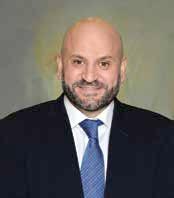

“Data is a starting point, not the story itself,” Malaeb says. “For example, if research shows parents care about car safety, the message shouldn’t stop at listing features. Instead, content should show real-life moments – like the rush of a school drop-off or the quiet of a late-night drive home. When these details feel true to life, audiences pay attention.”
This is where human intelligence in the driving seat with AI influencers riding shotgun really matters.
Nimer says, “My take is: We should use AI not to replace the human voice, but to amplify it strategically, empathetically and creatively. The humanising aspect isn’t necessarily about whether it sounds real; it’s about saying the right things.”
He adds, “When crafted with purpose, AI influencers deliver that ‘wait, did an AI just say that?’ charm. But here’s the kicker: they still need us. Marketers are the ones feeding the AI with the right context, strategy and storytelling DNA. We’re not stepping aside for machines; we’re teaching them how to speak brand fluently.”
for brands that want to shape it, AI is the hack: a way to translate data into creative expression that travels – across markets, time zones and cultural lines.”
To date, AI influencers have been viewed as effective campaign tools, but leaders say that it’s time to view them as more than just ‘disposable characters’.
Kayouka comments, “Most brands still treat AI influencers like novelty acts built for headlines, not memory. But the smart ones treat them like intellectual property (IP): distinct voice, narrative stretch and a role within the brand’s cultural system. That kind of presence doesn’t run on autopilot. It takes upkeep: scripting, styling, evolving tone and responding to context.”
Leaders agree that the ‘smarter’ companies are using AI influencers as flexible voices that evolve alongside their agile businesses.
Malaeb says, “Instead of fading them out after a single launch, they become part of everyday communication – adjusting content and tone as needed and always staying true to the brand’s core identity.”
This approach, leaders agree, is especially valuable in sectors such as automotive or technology where education and ongoing conversation matter.
Dajani adds, “Forward-thinking brands are repositioning AI influencers from tactical campaign tools to strategic brand assets that deliver sustained competitive advantage. Unlike human influencers, AI brand ambassadors maintain consistent messaging, never experience scandals, and can operate across multiple markets simultaneously.”
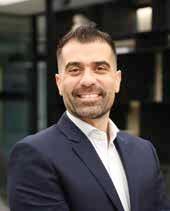
Goel agrees saying, “AI can create more space for human creativity – if we let it. The opportunity isn’t to replace the human touch, but to reimagine how we express it at scale. Culture now moves at the speed of social, and
Malaeb adds, “With a long-term role, AI influencers help keep messaging clear and consistent, even as products or markets evolve. When brands invest in this way, the AI persona becomes part of their foundation, helping them stand out and stay relevant in crowded digital spaces.”
The bottom line? In the hands of skilled marketers, AI influencers are becoming more than tools. They’re turning into long-term brand ambassadors with cultural fluency, emotional intelligence and brandbuilding power.
“The win? A character that doesn’t age, burn out or go off-script. It’s one that adapts to platform shifts, speaks with consistency and carries meaning across time. In a feed full of forgettable faces, an AI persona with point of view isn’t just efficient, it’s unmistakable,” says Kayouka.
Leaders reach a consensus that success lies not in the realism or the perfection of AI, but in transparency, resonance, the cultural sharpness of its expression and how the humanity of creatives shines through the AI influencers that they are bringing to life.
“FORWARD-THINKING BRANDS ARE REPOSITIONING AI INFLUENCERS FROM TACTICAL CAMPAIGN TOOLS TO STRATEGIC BRAND ASSETS.”



Imagination Saudi’s Sara Faisal shares what Saudi Arabia’s fiscal shift means for brands in tourism and destination development.






The completion of Saudi Arabia’s Fiscal Sustainability Programme in early 2025 marks more than the achievement of a financial target – it signals a critical shift in the Kingdom’s readiness to partner with private-sector brands in shaping its next era of tourism, culture and placemaking.
What began in 2016 as the Fiscal Balance Programme has helped position Saudi Arabia for long-term economic resilience and growth. For brands, this is a rare window: the public sector has laid the groundwork, and now the private sector is being invited to help define the experience layer through culture, entertainment, retail and technology.
With Expo 2030 Riyadh and the FIFA World Cup 2034 ahead, Saudi Arabia is strategically developing tourism infrastructure that emphasises commercial sustainability. But this isn’t limited to Riyadh or Jeddah. Other cities such as Abha, Hail and Al Ahsa are becoming dynamic zones for culture, retail and immersive brand experiences. It’s a diversification strategy that brings with it untapped potential, especially for brands looking to grow with the market rather than follow it.
Tourism in the Kingdom is structured around three core pillars: domestic travel, religious pilgrimage and international tourism. For each of these audiences, the infrastructure and intent to create deeply engaging experiences exists, and brands are increasingly seen as partners in delivering them.
Saudi Arabia’s enhanced fiscal position is accelerating the delivery of some of the region’s most iconic tourism and cultural developments. Destinations such as Diriyah Gate, The Red Sea Project and the King Salman Park aren’t just government initiatives, they are canvases for brand expression. These places need the kind of experiences only brands can deliver, from


hospitality and retail to live activations and immersive storytelling. But what matters most is how brands show up.
The new Saudi tourism landscape demands authenticity. It’s not enough to be present; experiences must align with local culture, values and aesthetics. The strongest brand activations will be those that listen closely, collaborate meaningfully and reflect regional identity while offering world-class engagement.
Sustainability is also front and centre. From eco-tourism in coastal zones to adventure offerings in mountainous regions, there’s growing space for purposedriven partnerships. Brands that align with this national focus – not just in message, but also in action – stand to gain long-term equity with visitors and Saudi residents.
Meanwhile, the rapid development of a local tourism workforce creates fresh opportunities for brands to embed themselves more deeply. Hospitality academies, cultural ambassador programmes and entrepreneurial initiatives are producing a new generation of storytellers, guides and innovators. Co-creating with this talent not only builds relevance; it builds trust.
And finally, technology is reshaping every touchpoint. Smart tourism systems, immersive heritage experiences and seamless digital infrastructure are making Saudi Arabia a future-ready tourism market. For digitally fluent brands, the possibilities are endless, from personalised engagement to scalable flagship activations.
‘‘It’s not enough to be present; experiences must align with local culture, values and aesthetics.”
By 2030, Saudi Arabia aims to welcome more than 100 million visitors annually and to rank among the top global tourism destinations. That scale isn’t just a national ambition but a global platform for brand visibility, relevance and growth.
The first movers will have an edge. Early investment, whether in hospitality, retail,



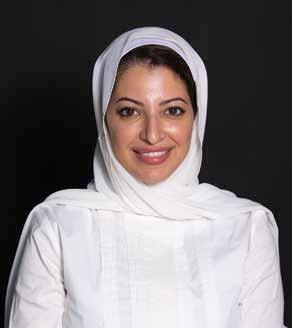


entertainment or content creation, will position brands as foundational to Saudi Arabia’s tourism identity. The government is actively inviting public-private collaboration across these sectors, making this a moment of strategic alignment.
At Imagination, we work at the intersection of government vision and brand creativity. We’ve helped shape tourism strategies and placemaking initiatives across the Kingdom – from Riyadh to Jeddah, and from AlUla to Hail.
Our work goes beyond execution, helping brands navigate the nuances, legal frameworks, cultural codes, multi-layered approvals and deliver experiences that resonate deeply and perform commercially.
Whether it’s activating stories at Diriyah, designing digital experiences for tourism visas, or supporting cultural initiatives in the south, we understand that success here depends on insight, agility and respect.
Saudi Arabia isn’t just building infrastructure; it’s building meaning, identity and invitation. For brands ready to think beyond traditional sponsorships or campaigns, this is a historic opportunity to co-create something enduring.
To stand out in the next phase of global tourism, brands must not only be seen, they also must be felt. In Saudi Arabia, the moment to make that impact is now.










































































Campaign Middle East asked client-side bosses to recommend the best young talent aged 30 and younger working within brands in marketing, communications, digital and social media roles. Here are the young, talented individuals that they recommended who will shape the region’s brand messaging in years to come.

Marketing Manager, Genesis Middle East & Africa
Rami Al-Salih, General Manager – Sales and Marketing, and Network / Training, Genesis Middle East & Africa: I’ve had the pleasure of working closely with Angel over the past few years, and I can confidently say he is one of the most dedicated and driven professionals I’ve encountered. His passion is unmatched, and his ability to bring creative ideas to life has led to some of the most impactful campaigns in our region. He has successfully led multiple regional launches for Genesis, which are considered some of the most globally recognised events. Strategic, detailed and driven – he makes a tremendous impact. Angel is not just a colleague, he’s also a true asset to the brand and an inspiration to the team.
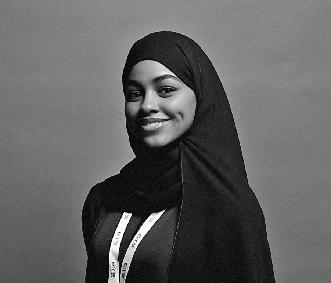
Marketing Director, Mr Mandoob
Obaid Alenazi, Chief Executive Officer, Mr Mandoob: Ahmed is a marketing leader with a rare mix of creativity and strategy. He has played a pivotal role in growing Mr Mandoob into one of KSA’s top delivery platforms. His campaigns are sharp, culturally relevant and deliver measurable results. A talent worth spotlighting.

Growth Marketing Specialist, Property Finder
Ahmed Osman, Director of Growth Marketing, Property Finder: Abdul Raqeeb drives impact far beyond his role. He delivers performance marketing results that consistently surpass benchmarks. He brings clarity, structure and velocity to complex problems – and does it with humility and consistency. His influence on our marketing stack and team culture is undeniable. He represents what the next generation of marketing professionals in the region looks like: grounded, data-driven and growth-focused.
Social Media Manager, Gates Hospitality
Caroline Holmberg, Co-Founder & Managing Director, Coco Comms:
I’ve worked with Agnese in two different roles. Her sharp storytelling, creative vision and brand voice instincts remain consistent and make her invaluable. She is definitely one to watch.

Marketing Executive, Zajel Courier Services
Nabeel Alkharabsheh, Marketing Manager, Zajel Courier Services:
I strongly recommend Ahad Yaqoot for this nomination. Her creativity, initiative, and commitment to excellence have had a clear impact on our marketing efforts. She consistently delivers high-quality work, brings fresh ideas to every project, and shows a strong sense of ownership and collaboration. Her ability to handle pressure while maintaining a positive, solution-oriented mindset makes her an asset to the team. I’ve seen remarkable growth in her and believe she has great potential ahead.

Marketing and Communications Manager, Gates Hospitality
Richard Cowling, Director of Operations, Gates Hospitality:
Amaka has hit the ground running, leading strategic marketing for Folly Brasserie in just eight weeks. She has also overseen the end-to-end marketing for the Jardin Des Arts launch with solid results. A reliable and determined leader, she’s shown her ability to drive impactful campaigns and champion awards lobbying – she has set a high bar for the marketing function.
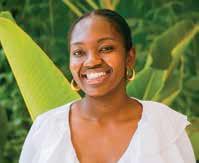

Assistant Marketing Manager, Jannah Hotels & Resorts
Julio Rafael, Director Marketing & Communications, Jannah Hotels & Resorts:
Chatarina Widi’s dedication and creativity stood out from day one. She managed multiple brands with great finesse, balancing strategic goals with authentic storytelling. Her insights and execution drove measurable business growth and brand loyalty.
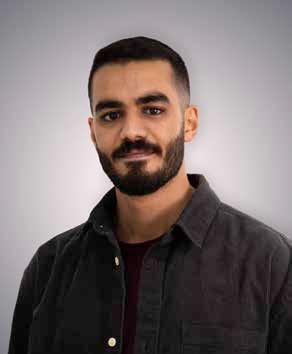
Senior Marketing Manager, Expo City Dubai
Nominated by Howaida Rabee, VP, Marketing, Expo City Dubai:
Aisha has been part of the Expo journey since 2019 and has played a vital role in marketing campaigns both before and during Expo 2020 – driving awareness, building engagement, and contributing to record-breaking visitation. As part of Expo City Dubai, the living legacy of Expo 2020, Aisha has led creative strategies, campaign execution, and media planning to position the city as a destination to live, work, and experience.
Senior Digital Marketing Specialist, NMS Jetour
Kareem Hussain, Marketing Director, NMS Jetour:
Adel is a results-driven marketing research and development specialist. He has a proven track record of leading successful digital marketing campaigns, enhancing brand presence and driving customer engagement. He is an expert in content creation, media campaign management and customer relationship enhancement with hands-on experience across several industries. Adel is also adept at leveraging analytics to inform strategy and optimise outcomes.
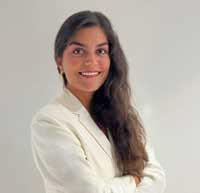
Retail and Marketing Manager, Shooting Stars Rights Management / Warner Bros Discovery
Alex Hall, Category Manager, Shooting Stars Rights Management / Warner Bros Discovery:
I have worked with Adam closely, and what separates him from the other people who I have worked with in a similar capacity is the innovative ideas he brings to the table. Angles to an activation or campaign that are usually overlooked by some, he catches and builds on them. A person in marketing must put themselves in the position of the seller and the buyer, and Adam understands both exceptionally well.
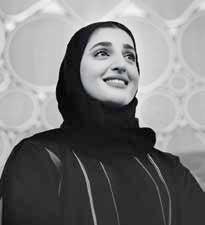
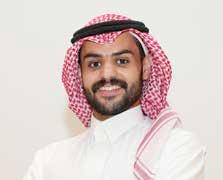
CECILIA NATALIA HAGE, 30
Global PR and Communications Manager, CFI
Salma El Saadany, Account Manager, Brazen MENA:
We have had the privilege of working closely with Cecilia across global campaigns, product launches and executive positioning. Her strategic foresight, cultural intelligence and instinctive leadership transform initiatives into exceptional outcomes. Cecilia excels in navigating and crafting compelling narratives that drive engagement. She inspires teams and consistently delivers results, making her a true brand force. In a world where communication is key to shaping a brand’s success, Cecilia is much more than just a ‘brand voice’ – she is a true brand force.
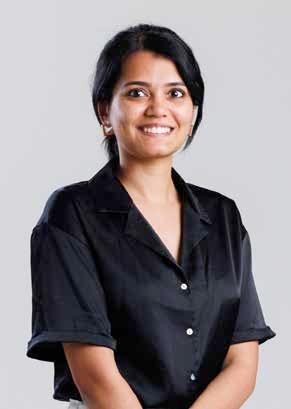
BONY ROY, 30
Manager - Future Talent and Industry, Dubai Lynx and Athar Festival
Kamille Marchant, Festival Director, Dubai Lynx and Athar Festival:
What sets Bony apart is her genuine dedication to development. She places it at the heart of everything she does, and it shows in the quality and care of her work. She is always eager to help, generous with her time and tireless in her pursuit of creating meaningful impact. Her collaborative spirit and vision have made her an indispensable force in shaping the future of our industry.
Regional Brand ManagerSensodyne - Gulf and Near East, Haleon
Aneela Halani, Marketing ManagerSensodyne - Gulf and Near East, Haleon: I’ve had the pleasure of working with Charlie and have consistently been impressed by his drive, strategic thinking and ownership mindset. He brings creativity to every project, communicates with clarity and always follows through. Whether leading brand campaigns or managing cross-functional tasks, he shows strong business acumen, adaptability and a solutions-first attitude. A reliable team player with integrity and initiative, I highly recommend him.
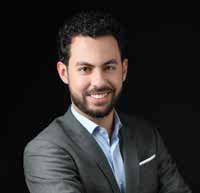
PR and Marketing Manager, Peninsula Hospitality Group
Nidhi Shetty, Director of Marketing, Peninsula Hospitality Group: Divya started working with us two years ago, she worked alone for our 10 properties including the Stables Dubai, Rodeo Drive and President Hotel, among others. She started our social media pages and has now moved into the PR and events aspects – growing our marketing team and creating the online social buzz we now have in our hospitality group. She is an energetic young Gen-Z and full of creative ideas. She literally shocked the team by achieving the highest sale in one day through Mangalore Express. We didn’t work with any agency; She ran it all in-house from social media to PR influencers to getting newspaper articles and ads.


Global PR Lead, Flowwow
Slava Bogdan, CEO, Founder, Flowwow: I highly recommend Darina Zotova for this recognition. In three years, I’ve had the distinct pleasure of watching Darina turn from a global PR manager into an experienced team lead with a strategic vision. She suggested the concept for our marketplace: ‘a global gifting marketplace for local shops’, which is now core to Flowwow’s identity. Today Darina supervises a team of four people, driving Flowwow’s brand presence in more than five markets. I know it’s only the beginning of her professional journey, and this nomination will be a chance to highlight her achievements.
Senior Communications Manager – Chevrolet and GMC, General Motors Middle East & North Africa
Ronald Balit, Communications Director, General Motors

Middle East and North Africa: Diala is an emerging leader with promising potential. Since joining as Senior Communications Manager, Chevrolet and GMC, her passion, intellect and work ethic stood out. She’s skilled in humanising brand objectives and creating effective communication strategies that deliver the story to its audience through optimal channels. She innovates fearlessly and is resilient in the face of failure. She consistently tries new things and adapts swiftly, while bringing her peers and agency team along. She demonstrates versatility by adapting her thought process, creativity and strategic acumen, always putting the audience first.

EL RADI LAYAL, 27
Head of Social and Influence, The Luxury Closet
Maya Azzi, Brand Chief Officer, The Luxury Closet:
Layal is a dynamic force in the industry – her strategic vision, creative edge and deep understanding of culture make her an invaluable brand leader. She consistently delivers campaigns that are not only engaging but meaningful, with a strong focus on sustainability and innovation.

Eyzell believes branding is about uncovering truth, not following trends. She builds with purpose and brands with integrity – crafting emotional clarity and cultural relevance for each concept, from luxury to street, and always with strategy, depth and soul.
Marketing and Communication Manager, One Development
Ahmed El Sherbini, Chief Marketing Officer, One Development:
Fareed is a key member of our group. As Marketing Manager at ONE Development, ONE/AD and Al Gebely Holding, Fareed leads multiple brands under pressure with strategic clarity and creative excellence. He launched flagship projects that set new industry benchmarks and drove high-impact campaigns and partnerships with icons such as Amr Diab, Kevin O’Leary and Kareena Kapoor. Fareed delivers fully integrated 360-degree marketing and is a standout talent shaping the future of marketing in real estate.
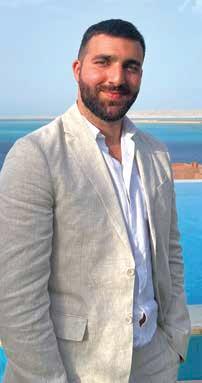
SAWADI, 25
Manager, Campaign Management, ROSHN Group
Moussa Haj, Associate Director, Campaign Management, ROSHN Group: Hashim is a star in our campaign management team here at ROSHN Group. Hashim has helped transform how we look at data and lead generation, and his energy and ideas are reshaping our approach to campaign management. Hashim also played a pivotal role during our rebranding last year. Hashim is a leader of the future, and he is very much an example of the best young Saudi talent in the marketing industry.

Marketing Administrator, Zurich International Life Ltd. Middle East
Masoom Shirazi, Senior Marketing Manager – Retail; Employee Benefits – ME, Zurich International Life Ltd. Middle East:
Hoor is a talented, dedicated team player who quickly adapted to her first corporate role. She shows a strong work ethic, a positive attitude and attention to detail, consistently delivering quality results on time. Approachable and helpful, she balances work and life well, demonstrating persistence and commitment. Her eagerness to learn and drive for excellence make her a valuable asset.
Assistant Director of E-Commerce, Rixos Hotels and ALL Inclusive Collection
Karthik Priyardashan, Director of Digital Marketing, Rixos Hotels and ALL Inclusive Collection: Ilhami has an instinctive understanding of what drives guests in today’s digital-first hospitality world. He’s played a key role in transforming our hotels’ online presence, delivering real results through smart campaigns, sharp storytelling and tech-driven strategy. His mix of creativity, commercial acumen and genuine passion for the industry makes him one to watch – not just in 2025, but for the future of hospitality marketing.
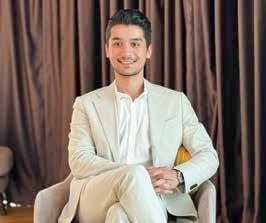


CRM Campaign Specialist, Sephora Middle East
Sereen Hindawi, Head of Loyalty and CRM, Sephora: I have always pushed for collaboration among teams … but nothing as tight knit as Ihcene and her colleague Nour. Despite different areas of focus they meld together in sharing, supporting and pushing each other – and everything in between. One is extroverted and the other introverted … yet they found a way to work and excel together. As a result their portfolio has seen incredible growth. Nour and Ihcene are definitely going to make their mark in the industry – not only because of their expertise, but also because of how they have learned to work as one solid team.
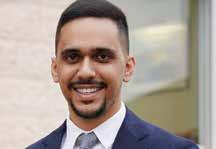
HUSSEIN NAJADAT, 28
PR and Communications Specialist, Dubizzle Group MENA
Noor Nabulsi, Head of Public Relations and Strategic Partnerships, Dubizzle Group MENA: Hussein is a strategic thinker with a natural talent for storytelling and media engagement. He brings clarity, creativity and precision to every project. I’ve seen firsthand how his work consistently elevates brand presence and earns stakeholder trust.
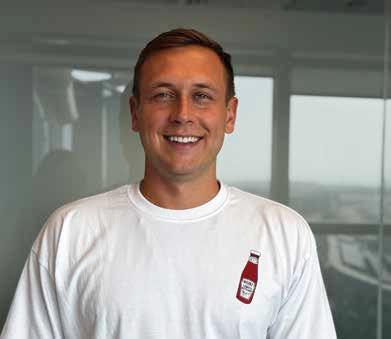
Brand Manager for Heinz MEA, Kraft Heinz
Passant El-Ghannam, Marketing Director, Kraft Heinz: Ilya is our rising star with unmatched passion, ownership and curiosity. He led our biggest innovation this year and multiple Heinz Ketchup campaigns. He is unapologetically bold – always asking, always growing. A creative force who’s just getting started.

Manager, DAMAC Properties
Sanjiv Swain, Senior Vice President
– Marketing, DAMAC Properties: It’s my pleasure to nominate Karen. She doesn’t just execute; she understands the nuances between brands and audiences.
Karen has an intuitive grasp of when to lead a narrative and when to hold back, distinguishing meaningful conversations from noise. She thinks in systems, not just campaigns, connecting market forces to build lasting brand equity. The communications field needs more people like Karen who bring intellectual rigour alongside creative instinct. She deserves this recognition not because she checks boxes, but because she’s redefining what strategic brand communications can achieve.
Senior Marketing Executive, Al Masaood Automobiles
Nominated by Delia Sandu, Head of Marketing, Al Masaood Automobiles
Khan said, “I’ve learned that a strong brand goes beyond products; it’s about the experience, service,and trust we deliver. I focus on creating campaigns that connect emotionally, educate meaningfully, and reflect the value that define our brand.”

Social Media Specialist, ROSHN Group
Feras Alsahhar, Social Media Director, ROSHN Group: Lamia Aldrees exemplifies the true spirit of excellence. Her discipline, emotional intelligence and proactive mindset inspire her colleagues to walk the extra mile, think analytically and deliver high-quality results that elevate our team and organisation.
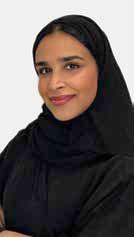

ISABEL CALANDRINI, 25
Marketing Manager, Sunset Hospitality Group
Charlotte Bellot, Associate Director, Sunset Hospitality Group:
Isabel is a true marketing and PR talent. Passionate, creative and driven, she brings excellence and heart to every project. Working with her is a privilege, she leads with collaboration, trust and integrity, inspiring everyone around her. I’m proud to have her on my team and honoured to be part of her journey. She’s destined for great things.

LAILA HABASH, 29
Brand Manager, Rixos Hotels & ALL Inclusive Collection
Anjeanette Manuel, Country PR Manager, Rixos Hotels:
Laila Habash is a powerhouse brand manager whose creative intuition and strategic thinking have elevated every campaign she’s touched. Her ability to marry data with storytelling has driven exceptional brand visibility and consumer engagement. Laila doesn’t just manage a brand – she shapes its voice and steers its cultural relevance. In a fast-evolving industry, she brings a rare mix of agility, emotional intelligence and innovation, making her truly deserving of this recognition as one of the region’s next-gen marketing leaders.
UAE Brand and Partnership Marketing Lead – Disney+, The Walt Disney Company
Tamim Fares, Director, Disney+ MENA, The Walt Disney Company: Lena is a force. An OG Disney+ MENA team member, now leading Marketing in the UAE, she has stepped up with ownership, creativity and impact. From the Daredevil: Born Again premiere to the Ultimate Summer Binge at Kite Beach, Lena delivers standout campaigns with positivity, precision and heart – from strategy to execution. Her dedication is unmatched; her presence uplifting; and her work sets the bar. A true brand face and rising star for Disney+ in the region and around the world.


MALAK ELNAHAS, 30
Senior Marketing Manager, Expo City Dubai
Howaida Rabee, VP – Marketing, Expo City Dubai:
It is my pleasure to recommend Malak El Nahas, a dynamic and creative Senior Marketing Manager at Expo City Dubai. Malak first joined the team ahead of the six-month Expo 2020 event, where she played a pivotal role in launching campaigns for both the opening and closing ceremonies, as well as managing high-impact, visitation-driven campaigns. Since rejoining the team at Expo City Dubai, Malak has worked closely with me to deliver bold, purpose-led campaigns that position the city as a hub for innovation, sustainability and business.
Carla El Hachem, Marketing Deputy General Manager, Nissan Middle East:
I’m proud to nominate Meera Saleem for the ‘30 Under 30 Brand Faces to Watch’ list. Since joining Nissan’s graduate programme, she stood out for her passion, creativity and drive. After rotations across departments, she found her home in marcomms – working on award-winning campaigns in addition to managing the brand’s social platforms. Her current role in brand and creative is a natural next step, and she’s already made a strong impact. Meera is smart, driven and creative and I have no doubt she’ll continue to shape the future of brand marketing.


LAMIA ALBATTAL, 23
Communications Specialist, Amsa Hospitality
Miret Padovani, Founder and Principal Consultant, Amsa Hospitality: Since day one at Amsa Hospitality, Lamia has taken full responsibility of marketing and communications tasks for the signings and openings of several properties. She is very reliable and competent. She takes care of every detail of a project.
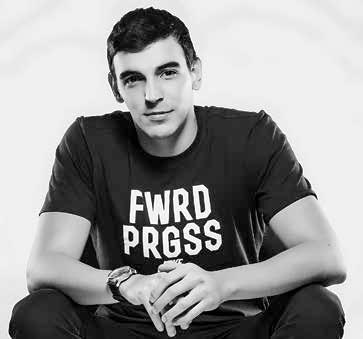
LUCAS STAMM, 30
Marketing Manager, O Beach Dubai
Paloma Tur, Global Director of Brand and Marketing, O Beach Dubai: Lucas is a standout creative leader who merges brand purpose with commercial impact. He consistently challenges the status quo, drives innovation and uplifts those around him. His ability to spot and nurture talents combined with sharp digital expertise and relentless curiosity make him indispensable to any team. He also excels in cross-functional collaboration and brings a contagious energy that adds to the secret sauce behind his team’s standout performance.
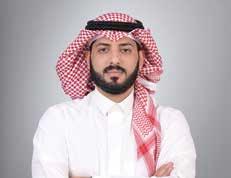
Marketing and Digital Coordinator – MENA, Warner Bros. Discovery
Marketing and Communications Consultant, National Center for Vegetation and Desert Development
Nominated by Khalid M. Alomar, Corporate Communication – General Manager
Alqashanin said, “I’m also a fantasy novelist with three published books in the ‘Land of the Mountains’ series. I’m also passionate about philosophy and recently published a book titled The Mind in the Shackles of the Soul. Beyond that, I’m an essayist who loves writing and reading.”
Aya Hammad, Marketing, PR & Digital Manager, Warner Bros Discovery Kids Networks – MENA:
Nada Al Dash is a highly valued member of the Warner Bros. Discovery MENA team, known for her exceptional creativity, strategic insight and dedication. With a sharp eye for detail, she skillfully oversees digital campaigns, ensuring our brand’s voice is consistently impactful across all platforms. Nada’s collaborative spirit and proactive mindset have been instrumental in driving our marketing achievements. Her enthusiasm for innovation and commitment to excellence make her an indispensable asset to the team.

Marketing Specialist, FUJIFILM Middle East and Africa
Samantha Brett, Regional Marketing Manager, FUJIFILM Middle East and Africa:
Menna joined our team as an exceptional talent and has grown into a key lead in regional marketing. Her mix of creativity, cultural insight and strategic thinking has been central to strengthening the Instax brand across the MENA region. Clients, media and partners have highlighted her professionalism and collaborative spirit. She brings ownership, precision and energy to projects, from influencer campaigns and activations to PR and digital. Her drive and creative spark make her a standout leader in the marketing industry.


Marketing Executive, dubizzle Middle East
Hadeel Jabr, Senior Marketing Manager, Dubizzle Middle East: Momina consistently delivers innovative marketing solutions with strategic insight and a collaborative spirit. Her dedication and creativity have significantly contributed to the success of multiple high-impact campaigns across dubizzle’s verticals.
Marketing and Communications Manager, Rotana Hotels and Resorts, Centro Sharjah
Daniel Norman, General Manager, Rotana Hotels and Resorts, Centro Sharjah:
Mohammed has brought a fresh perspective to the hotel’s marketing approach. He has elevated the quality of our content, photography and copy, successfully projecting the unique character of the property. He has exercised resilience and commitment to facilitate and activate new initiatives such as our largest Ramadan concept, engaging the hotel teams to deliver a unique event throughout the month. Mohammed has also introduced out-of-the-box marketing tools and secured high-quality resources in a very cost-effective way, ensuring return on investment (ROI) on all efforts.

Marketing Assistant, Heriot-Watt University
Sophia Benmimoun, Marketing Manager, Heriot-Watt University:
Melissa has demonstrated outstanding contributions as a key member of the marketing team, showcasing exceptional efforts in collaborating with schools, faculty and students. Her dedication and creativity have brought forth content that is unique, impactful and aligned with the university’s vision. Moreover, Melissa has consistently gone above and beyond by providing excellent support in covering events both on campus and abroad on social media which translated into impactful campaigns. Melissa’s achievements make her a perfect candidate for the 2025 Faces to Watch list.
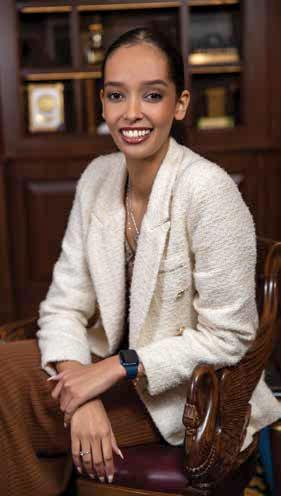
CRM Campaign Specialist, Sephora Middle East
Sooraj T R, Head of Innovation, Socialize / We Are Social: Nour has consistently impressed us with her blend of creative vision and technical mastery in managing Sephora’s CRM initiatives. Her eye for campaign innovation, expertise with CRM platforms and data segmentation has enabled us as Sephora’s CRM execution agency to launch precise, agile and impactful campaigns. She knows Sephora’s audience and exactly how to engage them. She is known for her attention to detail, collaborative spirit and hands-on technical prowess.
Senior Brand Manager, L’Oréal Liban
Abdallah Sharbaji, Head of Strategy and Client Lead – Levant, Mindshare: From day one, we could spot Natacha’s contagious passion and love for her products. Her humour and humility made her a joy to collaborate with. She didn’t just present; she made us live the brand. A digital media maven, she eagerly embraces emerging trends and thinks outside the box, bringing fresh ideas to the beauty industry. She is a true force.

ROHAN BABU, 25
Digital Marketing and Product Manager, Authentic Solutions
Asli Hassan, Co-founder, Authentic Solutions: Quality is Rohan’s top priority. He is always learning to stay ahead in marketing. He fully commits to the company’s mission and thinks beyond just tasks. His priorities are always backed by honesty, clear expectations and delivering work that goes beyond what’s expected.


Director of Marketing and Communications, Al Baleed Resort Salalah by Anantara
Hannah Castleton, PR Director, KPR:
As Nawfal’s newly appointed PR agency in the UAE, we’ve been blown away by his vision, drive and strategic mindset. His ability to make our lives easier is such a refreshing way to work with a huge hotel client. His blend of creativity with strategy is what sets him apart. He’s not only elevating the Al Baleed brand but also setting new benchmarks for hospitality marketing in the region and beyond. We love working with you Nawfal.

RULA AL KHATIB, 28
Lead Media Relations and Public Affairs, Chalhoub Group
Lynn Al Khatib, Vice President Communications, Chalhoub Group: It is with great enthusiasm that I nominate Rula Al Khatib for Campaign’s 2025 Faces to Watch edition. Rula has consistently demonstrated exceptional leadership, creativity and strategic acumen in shaping narratives that resonate both regionally and globally. In her role at Chalhoub Group, Rula has redefined what impactful media relations and stakeholder engagement can look like in today’s fast-evolving communications landscape. Rula plays a key role in shaping Chalhoub Group’s public image and external voice. She crafts clear, compelling narratives and fosters strong media relations.
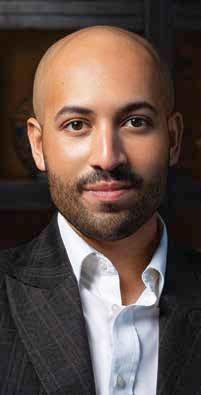
RUSOL AL HANO, 29
Senior Marketing Executive, Audi, Al Nabooda Automobiles
Rana Eyamie, National Marketing Manager, Audi, Al Nabooda Automobiles: Rusol brings a unique blend of creativity, strategic thinking and hands-on execution to every project she undertakes. Her ability to develop and execute innovative concepts has played a pivotal role in the success of numerous high-profile events and initiatives.
She stands out for her proactive mindset, independent drive and ability to deliver from inception to completion, all while enriching campaigns with fresh, original thinking. Her dedication is evident in the energy and professionalism she brings to every task, often going above and beyond to achieve exceptional results.


SARAH MOHJAZI, 25
Marketing and Communications Manager, Media One Hotel
Sarah Daud, Account Manager, KPR: Sarah has transformed the way Media One Hotel manages its marketing plans and executions. A bold, structured and endlessly helpful person, Sarah brings wisdom and expertise beyond her years to the property and to the hospitality industry in general. In the few short months I’ve worked with her, I’ve got valuable insight into the way she works. She strikes the perfect balance between ambitious and empathetic.

SHAIKH FAHAD, 29
Content Executive, Danube Group
Khushboo Raina, PR and Media Manager, Danube Properties:
I highly recommend Sara because she is an exceptional content strategist who brings creativity, structure and precision to every project she handles. In her role at Danube Group, I’ve seen her take the lead in conceptualising campaigns, crafting compelling scripts and ensuring every piece of content is aligned with the brand’s tone and objectives. Her attention to detail and her ability to transform raw ideas into polished, impactful narratives consistently elevate the quality of our communications.

Regional Marketing and Communications Manager, Arena Group
Jennie Pinilla, Hospitality and Special Projects Manager, Arena Group: I’m thrilled to nominate Fahad for Campaign Middle East’s Brand Faces to Watch. He played a key role in the success of the Dubai Desert Classic, working closely with me on the hospitality programme. Fahad led the marketing and social media for both the main event and the Pro-Am, curating engaging content that amplified our brand.
He is creative and collaborative and brings seven years of digital marketing, content creation and web skills to the table. Also, an award-winning athlete and host of the ‘What The Fahad’ podcast, he has a unique form of energy that makes him stand out.
SHATHA KHALIFA, 29
Social Media and Influencer Marketing Manager, Dubai Safari Park
Nominated by Pansy Adel, Head of Marketing, Dubai Safari Park – Dubai Municipality.
Khalifa said, “I’ve driven record engagement, launched high-impact influencer campaigns and built a platform that champions education, conservation and entertainment. Passionate about turning creative vision into measurable results and making brands unforgettable online.”


SARAH EL BATTAH, 26
Regional Marketing Specialist, Azadea Group
Nominated by Yasmin Alaa, Account Manager, Socialize Agency. Sarah is guided by a passion for purposeful marketing and meaningful connection. She approaches every campaign with intentionality, blending creativity with strategic precision to deliver real impact. Her principles are rooted in consistency, relevance and audience-first thinking.

SHIKHA ALMUNIF, 28
Senior Specialist, Destination Marketing, ROSHN Group
Mohammed Alhadlaq, Director, Campaign Management, ROSHN Group: Shikha is full of ideas, creativity, energy and positivity. She involves herself with a passion that speaks to how much she enjoys what she does. And she takes a particular interest in anything which showcases our development, evolution and transformation. I know that whenever she is involved in any project, she will give her all for the team and for the company.

SAIMA ABID, 24
Social Media Executive, Bayut
Emma Dourado, Social Media Manager, Bayut: She brings creativity, speed and strong attention to detail. She’s highly engaged in daily activities and quick on her feet. During the TruBroker launch, she took full ownership of creating engaging content with our partners, driving the campaign’s visibility. Her ideas are fresh, her execution is fast and she never compromises on quality. She’s a reliable, proactive team member who adds value to every project.
Senior Marketing Assistant, Heriot-Watt University
Sophia Benmimoun, Marketing Manager, Heriot-Watt University:
Shree has been a valuable member of the marketing team, consistently demonstrating exceptional initiative and collaboration since her first day. Her ability to work seamlessly with stakeholders has led to the creation of innovative and impactful student-centred content that highlights the university’s commitment to shaping future leaders and making a positive impact on their lives. Her collaborative approach ensures the success of promotional campaigns showcasing an inspiring and welcoming atmosphere for prospective students. Shree is an exceptional choice for the 2025 Brand Faces to Watch list.

Marketing and Communication Manager, DoubleTree by Hilton, Resort and Spa, Marjan Island
Aliya Jamal, PR Account Executive, Katch International:
I’ve had the pleasure of working closely with Sreeja Mannangath, and I can confidently say she is one of the most results-oriented and forward-thinking marketing professionals I’ve encountered. In her current role leading communications at DoubleTree by Hilton Resort and Spa Marjan Island, Sreeja has demonstrated an exceptional ability to balance strategic vision with hands-on execution.
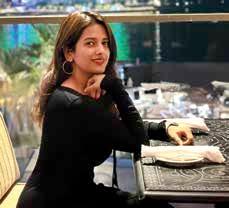

Digital Marketing Manager, Anker Innovations
Sharmila Dhun, Head of Marketing – MEA Region, Anker Innovations:
Syed Salman has quietly become one of the most dependable and impactful members of our marketing team at Anker. As our Digital Marketing lead, he has driven standout campaigns, led the launch of the Global Sales Assistant App for MEA, and meaningfully boosted social engagement. He’s sharp, quick to learn and always steps up to contribute – often beyond his remit. He has also been actively exploring AI tools to help us work smarter, faster and with greater impact. No fuss, no ego – just thoughtful, consistent marketing. A true team player and definitely one to watch in 2025.

ZAINA DEESI, 30
Mobile Experience Senior Marketing Associate, Samsung Gulf Electronics
Lara Zureik, Head of Mobile Experience Marketing, Samsung Gulf Electronics: Since joining the team just six months ago, Sohail has had an exceptional impact, not only through his work but also through his one-of-a-kind personality. In high-pressure situations, his sense of humour brings calm and lifts team morale, turning stress into laughter. Behind that light-hearted spirit lies a driven and dedicated young professional who continuously contributes to our strategy, bringing forward innovative solutions, planning and execution. He stands out for creativity, gaming passion, Gen Z insights, and he has even modelled in a local shoot. We’re proud to have him on board.
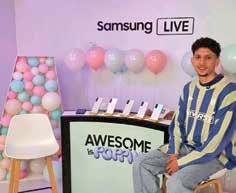
Marketing Manager, Dubai Future Foundation
Abdulla AlNuaimi, Chief of Marketing and Communications, Dubai Future Foundation: Zaina is a reliable and thoughtful project manager who brings structure, clarity and curiosity to every project. She excels at translating complex ideas into clear, engaging stories – whether through campaigns or public experiences. Zaina manages multiple projects with ease, always staying calm and solution oriented. She strikes a strong balance between creativity and execution, with a sharp eye for detail. Her collaborative nature and positive attitude make her a pleasure to work with. Her focus on storytelling and delivery has made her an invaluable part of the marketing team.
PR and Social Media Specialist, Canon Middle East, Central and North Africa

Jayashri Namdar, PR and Social Media Manager, Canon Middle East, Central and North Africa: I am pleased to recommend Swetha Ramesh for Campaign Middle East’s Brand Faces to Watch 2025. As a PR and Social Media Specialist, Swetha consistently delivers impactful narratives that drive business success and foster positive change. At Canon, she has showcased exceptional skills in creating authentic, inclusive stories that connect with diverse audiences and elevate the brand. Her work embodies a commitment to using communications as a force for good.
SIDDHI SHAH, 27
Senior Digital Marketing Manager, Blacklane
Rakhee Raval Shepherd, Head of Marketing, Capital.com: Siddhi is a professional and passionate person with an incredible ability to develop creative content.
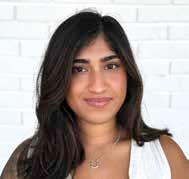
A recap of the Campaign Breakfast Briefing: Marketing Strategies 2025.
The Campaign Breakfast Briefing: Marketing Strategies 2025 event witnessed a room full of client-side marketers, agency and adtech leaders reach a consensus to get back to the fundamentals of curiosity, creativity, consumer-first mindsets and business outcomes.
The event began with a welcome speech by Nadeem Quraishi, Publishing Director, Campaign Middle East, who briefed the attendees about the brand’s latest developments. Campaign Middle East Editor Anup Oommen then took the stage to deliver the chair’s opening remarks.
KEYNOTE: THE OUTCOMES GRAPH: WHY THE FUTURE OF MARKETING IS NOT WHERE YOU ADVERTISE BUT WHAT IT DELIVERS
Getting the event started, Wade Eagar, Chief Marketing Officer, Platformance.io, explored the ‘outcomes graph’, navigating the shift from media placement to business impact.
Eagar highlighted the importance of outcome-driven marketing. He also stressed on the need for crossfunctional collaboration and performance-driven strategies to shift the focus from mere metrics to business outcomes.
“Start with the outcome, not the brief,” Eagar said. “Measure what you own – and this is the piece I want to bring home – move away from focusing only on the external data that we spend so much time measuring and building a nice story around, and move towards the internal data that shows up on the profit and loss (P&L) statement. However, it’s not about throwing the baby out with the bathwater, it’s about stitching these two together to align with business outcomes,” he said, calling for the industry to keep the end goal in mind instead of being focused on a budget-first approach.
The first panel of the day witnessed a discussion among multiple client-side marketers, including Aimee Peters, Regional Head of Brand, Partnerships and Wholesale Marketing, MENAT, HSBC; Loay Nour, Vice President – Brand and Marketing Communications, Fairmont Hotels and Resorts; Sohail Nawaz, MBE, Head of Retail Media, Landmark Group; and Virginie Ludmer, Director of Marketing and PR, Volkswagen Middle East.
The panel, powered by Bloomberg Media and moderated by Emily Bentley, Head of Client Marketing, MEA at Bloomberg Media, discussed ways to navigate complex business-to-business (B2B) sign-off chains to meeting business-to-consumer’s (B2C’s) demand for deeper, more meaningful connections. The session also explored how to create campaigns that are not only intelligent and personalised but also authentic.
HSBC’s Peters emphasised the importance of brand fundamentals as channels fragment at speed.
“We must market to be human, first and foremost,” she said. “You can’t constructively challenge if you’re not curious and if you’re not thinking about humans.”
The discussion also explored how personalisation has progressed from predictive AI to an era of shopping agents that reach out to consumers on their birthdays and then taking care of their outfit shopping.
On this front, Landmark Group’s Nawaz made the case for celebrating ‘secret cyborgs’. “These stealth employees using AI are now becoming pioneers in new AI lab environments that companies are setting up, even as leadership teams set out their clear vision for AI’s impact on the workplace and organisation,” he said. “What does this teach us? Don’t wait to be an AI expert – just be AI active.”

Addressing the conversation around B2B and B2C audiences, Fairmont’s Nour said, “What’s interesting is not only B2C and B2B audiences, which we always think about, but also how to create a funnel for B2B2C, because they become your advocates to promote your brand and your campaign.”
Wrapping up the panel well on the blurring lines between B2B and B2C, Volkswagen’s Ludmer said, “At the end of the day, the brand promise is the same. We’re all looking to enhance the customer experience. Whether we’re working alongside our dealerships, in terms of B2B, or our consumers, in terms of B2C, we need to really ensure that their success is also our success – together.”
MEDIA LANDSCAPE: A BOON OR A BANE FOR MARKETING IN THE MIDDLE EAST?
The second panel, in partnership with SRMG Media Solutions and moderated by Nader Bitar, Director of Digital Solutions, SRMG, welcomed to the stage Mitin Chakraborty, Head of Marketing, Babyshop; Nikola Djordjevic, Head of Marketing, ASICS Arabia; Andrew Ene, Head of Performance, Spark Foundry MENA; and Anjana Murali, Associate Director –Growth and Best Practices, Keyade Middle East.
The panellists delved into discussions on capturing attention and connecting with consumers in a fragmented media landscape and more.
ASICS’ Djordjevic said, “We have all seen a major shift in the way customers consume media and entertainment. These people don’t want to be passive consumers of media on traditional channels such as television any more; they want to consume on the go, whenever and wherever they choose. It’s not about going omnichannel every time. We need to pick our battles and choose the best medium contextually at a
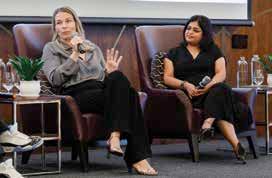
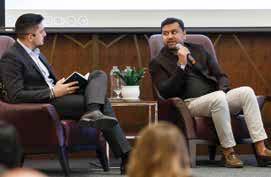
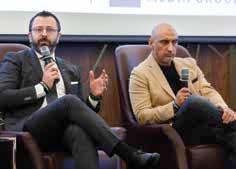

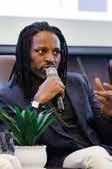
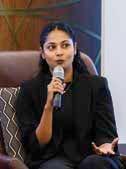


given moment of time depending on where – and when – the consumer wants it.”
Babyshop’s Chakraborty built on this discussion.
“That magical mix is what we need – a mix of logic and magic; a mix of the art and the science, which is super critical,” he said. “It goes back to really identifying: What’s the problem that we’re trying to solve? If you’re trying to chase brand equity within this fragmented space, it’s very important to know what your biggest story is, and how that is being translated across every touch point for customers.”
“Omnichannel is more about: What’s the brand truth that you’re trying to communicate to the consumer, and how do you make sure that you communicate that brand truth consistently across every touch point that the consumer engages with?” added Spark Foundry’s Ene. “However, when you’re thinking of multi-channel strategies, you’re thinking about making a choice about where you have the right to win based on where the consumers are at in a fragmented media landscape, and then crafting a story that touches all of those points.”
“Just because AI and algorithms seem to be doing the heavy lifting, it doesn’t mean some of us marketers can take a nap,” said Keyade’s Murali. “It’s important to marry the two together – what AI can do and what we bring to the table in terms of our experience, the

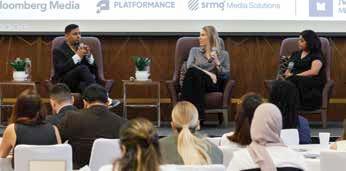
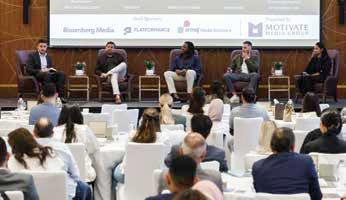

creative, understanding the feedback, leveraging what message resonates with the user, and more. That creative and strategic input still lies with us – and that’s why at the core, we are still needed.”
Concluding the panel, Chakraborty also highlighted standardised measurement as a common pain point that needs to be addressed on priority – a problem that’s becoming a roadblock for marketers trying to join the dots in terms of decision-making around platforms, providers and an ideal full-funnel approach.
CREATIVE AMBITION, BUSINESS OBJECTIVES, AND COMMUNITY-DRIVEN DEMAND FOR RELEVANCE
Moderated by Anup Oommen, Editor, Campaign Middle East, the event’s fireside chat welcomed on stage two brand marketers, Iva Kutle Škrlec, Director, Destination Marketing, Hilton MEA, and Remya Menon, Associate Director of Marketing, Bayut.
They explored ways to measure the effectiveness of cultural relevance within campaigns, while simultaneously staying aligned with broader brand and business objectives.
“The whole cultural relevance piece starts by defining what that means for your brand and what you’re trying to achieve, because that then determines
what you’re measuring. Do you need a brand-lift study? Do you need to look at your engagement rates and so on?” said Škrlec. “Getting that granularity right and understanding what it is exactly that resonates with people – in terms of messaging, offers, promotions and products is essential.”
Building on this conversation of measuring the impact and effectiveness of getting cultural relevance right, Menon said, “Measurement, specifically in the context of cultural relevance, is difficult, but am I saying that it’s impossible? No. As a brand guardian, you have to build your own hardware and use your internal data and what your audience is actually feeding back to you to build those measurement methods.”
Through the discussion, the marketers also delved into the need to truly listen to consumers to get the ‘cultural relevance piece’ right.
Menon said, “There are KPI-driven conversations and there are creativity-driven conversations, but the consumers now have made their opinions very clear – they want to co-create with brands. They want their feedback to be heard and to be more involved in the conversation.”
Both marketers agreed the main takeaway is to nurture a safe environment that embraces mistakes and learning in order to stay ahead of the curve.
Integrated







Outstanding

Frequency: 98.4 FM
Launched: 1969
Parent company: Abu Dhabi Media Company Office: Abu Dhabi
Flagship programmes: Studio 1
Language/format: Arabic
Media rep: ADMC commercial team adtv.ae
800 2366 commercial@admn.ae
Abu Dhabi FM was founded by the late Sheikh Zayed bin Sultan Al Nahyan, in 1969, making it one of the oldest Gulf radio stations. The station is renowned for having the largest radio library of recordings and data in the Gulf region, documenting significant historical events of the UAE. Additionally, it is distinguished as the first Arab radio station specialised in broadcasting live sports events and matches and its flagship show Studio 1.
Abu Dhabi FM radio station is one of eight stations fully owned by Abu Dhabi Media Company (ADMC), the UAE’s leading broadcaster and media company, and one of the largest media businesses in the Middle East and GCC.
You can tune in to all the live and pre-recorded programs on the ADtv application, where you can also listen to all previous episodes, which is available on Apple Store and Google Play.
Tune in to Abu Dhabi FM on 98.4 FM in Abu Dhabi.
Launched: 2001
Parent company: ARN Office: Dubai, UAE
Listeners demographics: Arab Expats
Flagship programmes: Extra Vibes with Heba & Khalid
Location of mast: Al Mas Tower, Dubai
Broadcast license lessor: Dubai
Reach: UAE
99fm.ae
04 455 5888
joshua.busteed@arn.ae
The UAE’s Number 1 Arabic Radio Station
Launched: 2003
Parent company: ARN
Office: Dubai, UAE
Listeners demographics: UAE Nationals and GCC residents
Flagship programmes: Oxygen with Auhood
Location of mast: Al Mas Tower, Dubai
Broadcast license lessor: Dubai
Reach: UAE
1009.ae
04 455 5888
joshua.busteed@arn.ae
The UAE’s Number 1 Emirati Radio Station
Frequency: 107.4
Launched: 2014
Parent company: Hamdan Bin Mohammed Heritage Center
Location of mast: UAE
Reach: UAE (Can be heard worldwide via the mobile app and live web streaming)
Language/format: Emirati
Media rep: MEMS aloularadio.ae 04 454 5454 mems@choueirigroup.com
Frequency: 97.8
Location of mast: Umm Al Quwain
Ownership: Fun Asia Network
Language: English
Format: Commercial house music
Location of mast: Umm Al Quwain
Broadcast licence lessor: UBN
Language: English Beat978.com
Frequency: 104.8
Launched: 1997
Parent company: Ajman Independent Studio LLC
Office: Channel 4, DAMAC Business Towers, Business Bay, Dubai
Location of mast: Ajman
Reach: UAE
Broadcast license lessor: Ajman Government Listeners demographics: 18 – 40 age group; M/ F Flagship programmes: Channel 4 Breakfast with Faris & Georgina; Channel 4 Daytimes with Shona, Channel 4 Afternoon with Shaan, The UAE’s Biggest Drive Show with Eve
Language/format: English; CHR (Contemporary Hit Radio)
Media rep: Mohammed Jundi, Network Sales Director channel4fm.com 04 567 0444 mjundi@ch4.ae
Frequency: 106.2
Launched: 2017
Location of mast: Umm Al Quwain
Language: Hindi
Format: Bollywood CHR
Location of mast: Umm Al Quwain
Broadcast licence lessor: UBN Big1062.com
Launched: 2002
Frequency: 101.6
Parent company: ARN
Office: Dubai, UAE
Listeners demographics: Indian, Pakistani, Bangladeshi and Nepalese nationals
Flagship programmes: Subah in the City with Parikshit & Varun
Broadcast license lessor: Dubai
Location of mast: Al Mas Tower, Dubai
Reach: UAE city1016.ae 04 455 5888
joshua.busteed@arn.ae
The UAE’s Number 1 South Asian Station
Frequency: 99.6
Launched: 2016
Language: Malyalam
Format: Entertainment, information, news, songs and creative campaigns
Parent company: Mathrubhumi Printing and Publishing Company clubfm.ae
Launched: 1971
Parent company: ARN Office: Dubai, UAE
Listeners demographics: A multicultural audience of families
Flagship programmes: The Big Breakfast with Jono & Nats
Location of mast: Al Mas Tower, Dubai
Broadcast license lessor: Dubai
Reach: UAE dubai92.com 04 455 5888
joshua.busteed@arn.ae
The UAE’s Longest Running Radio Station
Frequency: 93.0 in UAE
Launched: 2014
Parent company: DMI
Location of mast: UAE
Reach: UAE
Language/format: Arabic
Media rep: MEMS dmi.ae/dubai fm/ 04 454 5454
mems@choueirigroup.com
Launched: 2004
Parent company: ARN Office: Dubai, UAE
Listeners demographics: A multicultural audience of high net worth listeners
Flagship programmes: The Business Breakfast with Richard Dean, Brandy Scott, and Tom Urquhart
Broadcast license lessor: Dubai
Location of mast: Al Mas Tower, Dubai
Reach: UAE
dubaieye1038.com
04 455 5888
joshua.busteed@arn.ae
The UAE’s Number 1 Talk Radio Station
Frequency: 91.4
Language: Arabic
Format: Religious
Frequency: 99.9 - 99.7- 99.5 FM
Language: Arabic / English / French
Location of mast: Ashrafieh, BeitMery, Zahle, Jounieh, Fatka, North, Saida, Nabatieh
Reach: Lebanon
Broadcast license lessor: The Lebanese Ministry of Information and The Lebanese Ministry of Telecommunication
Listeners demographics: Young and trendy people, 20 to 50 years old
Media rep: Interadio SAL famefm.com
info@interadio.com.lb +961 156 1639
Frequency: 94.7
Launched: 2017
Parent company: Flowers International Group
Language: Malayalam and English
Broadcast license lessor: Dolphin Recording Studios flowersfm.com
Frequency: 95.8 FM in Abu Dhabi, 94.9 FM in Al Ain, and 97.1 FM in Dubai and Sharjah.
Launched: 1995
Parent company: Abu Dhabi Media Company Office: Abu Dhabi
Reach: the Middle East and GCC
Flagship programmes: Ahlaa Sabah, Podcast, and Wyn Rayhyn.
Language/format: Arabic
Media rep: ADMC commercial team adtv.ae
800 2366
commercial@admn.ae
Emarat FM, established in 1995, is the first Gulf entertainment radio station in the UAE and a leading station of the Abu Dhabi Radio Network, part of Abu Dhabi Media Company.
Emarat FM broadcasts to listeners across the UAE and the Gulf region, offering a mix of interactive entertainment programs, musical segments, and news.
Emarat FM station broadcasts flagship programs such as; Ahlaa Sabah, Podcast, and Wyn Rayhyn.
Emarat FM radio station is one of eight stations fully owned by Abu Dhabi Media Company (ADMC), the UAE’s leading broadcaster and media company, and one of the largest media businesses in the Middle East and GCC.
You can tune in to all the live and pre-recorded programs on the ADtv application, where you can also listen to all previous episodes, which is available on Apple Store and Google Play. Tune in to Emarat FM on the following frequencies: 95.8 FM in Abu Dhabi, 94.9 FM in Al Ain, and 97.1 FM in Dubai and Sharjah
Frequency: 101.3
Launched: 2010
Parent company: Ajman Independent Studio LLC Office: Channel 4, DAMAC Business Towers, Business Bay, Dubai
Location of mast: Ajman
Reach: UAE
Broadcast license lessor: Ajman Government
Listeners demographics: 18 – 40 age group; M/ F
Flagship programmes: Morning Drive with Samira & Vysakh; What’s up UAE with Deepa, Sunset Drive with Meera Nandan & Rijin
Language/format: Malayalam; malayalam music and entertainment Media rep: Mohammed Jundi, network sales director gold1013fm.com 04 567 0444 mjundi@ch4.ae
Frequency: 104.1 FM across Iraq but 100.5 FM in Basra
Parent company: Dijlah TV
Launched: 2010
Frequency: 92.6
Language: Arabic
Frequency: 102.7
Launched: 2007
Parent company: Entertainment Network LLC
Reach: Oman
Language/format: Arabic
Media rep: Arabian Media Company – Oman and Dubai halafm.om
+968 2 200 9004
AMC@choueirigroup.com
Frequency: 106.5
Language: Tamil radiogilli.com
Launched: 2004
Parent company: ARN Office: Dubai, UAE
Listeners demographics: Malayali Community
Flagship programmes: The Big Breakfast Club with Nyla, Arfaz, & Jean
Location of mast: Al Mas Tower, Dubai
Broadcast license lessor: Dubai Reach: UAE hit967.ae 04 455 5888 joshua.busteed@arn.ae
The UAE’s Number 1 South Indian Radio Station
Frequency: 107.1
Parent company: Fun Asia Network.
Launched: 2020
Location of mast: Umm Al Quwain
Language: English
Format: 80’s, 90’s and Noughties
Broadcast licence lessor: UBN luv1071.com

































n an age defined by digital disruption, radio remains a powerful and intimate medium. Its unique blend of immediacy, intimacy and cultural resonance continues to captivate audiences and offer brands a distinct platform for connection.



From hyper-localised advertising strategies to the seamless integration of emerging technologies and content formats, Fouad Debouk, Audio Growth Senior Manager at MBC Media Solutions (MMS) explores how radio is not just keeping pace with change – it’s helping shape the future of media engagement in a digital-first era.
WITH A NETWORK SPANNING MULTIPLE STATIONS AND CITIES, HOW WOULD YOU DESCRIBE YOUR OVERALL LISTENER BASE ACROSS SAUDI ARABIA? WHAT KEY AUDIENCE SEGMENTS DO YOU REACH?
MBC Group’s listener base is exceptionally diverse, both demographically and geographically, reflecting the multifaceted nature of Saudi society. MBC FM primarily serves Saudi nationals across all age groups and from every province, truly representing the cultural and social fabric of the Kingdom. Panorama FM, meanwhile, connects strongly with the broader Arabic-speaking community, including audiences from the Levant, Egypt and North Africa. MBC Group’s latest addition, LOUD FM, has quickly gained traction among English-speaking audiences, particularly resonating with Saudi youth – underscoring its commitment to innovation and evolving listener preferences.














































Fouad Debouk, Audio Growth Senior Manager at MBC Media Solutions (MMS)













HOW DO YOU WORK WITH AGENCIES AND PLANNERS TO ENSURE THAT RADIO SPOTS ARE CULTURALLY AND CONTEXTUALLY RELEVANT –ESPECIALLY IN MARKETS SUCH AS KSA WHERE NUANCE MATTERS?



and on-demand content. This transformation enables us to remain top-of-mind for both listeners and advertisers, providing real-time reach with measurable impact – something few mediums can deliver with such immediacy and intimacy.
HOW ARE YOU CHANGING YOUR APPROACH TO AUDIENCE MEASUREMENT, GIVEN THE INCREASING NEED FOR GRANULAR, DATA-DRIVEN INSIGHTS TO ATTRACT ADVERTISERS?
We are enhancing our audience analytics by incorporating more sophisticated data tools and third-party measurement solutions. Our goal is to provide advertisers with deeper insights into listener behaviours, preferences and engagement patterns – allowing for more targeted and effective campaign planning. These insights are increasingly valuable in demonstrating radio’s return on investment (ROI) in a highly competitive media environment.
WHAT ADVERTISING CATEGORIES ARE MOST ACTIVE ACROSS YOUR NETWORK, AND ARE YOU SEEING DIFFERENCES IN BRAND DEMAND BY REGION OR SECTOR?
Our advertising portfolio is remarkably broad, spanning quick-service restaurants (QSRs), fast-moving consumer goods (FMCGs), education, technology and hyperlocal businesses such as restaurants and aggregators. Notably, we’re seeing a significant uptick in interest from international brands – largely driven by the success of recent high-performing campaigns. This reflects growing confidence in our platforms’ ability to deliver measurable brand lift and localised impact at scale.

We take pride in offering end-to-end creative production for all our radio clients – an approach that allows us to collaborate closely with agencies and planners from the earliest stages of ideation. Our in-house copywriting and production teams are deeply attuned to local culture, dialects and evolving audience expectations, ensuring every radio spot lands with authenticity and precision.
In a market such as Saudi Arabia, where cultural awareness isn’t just appreciated but expected, we focus on creating contextually rich storytelling that reflects regional values, humour and behavioural trends. We also leverage data-driven insights to inform everything from tone and timing to platform selection, aligning creatives with listener habits and daily media rhythms. Additionally, we stay ahead of shifting media trends by integrating formats such as interactive radio spots, real-time triggers and geo-personalised messaging – ensuring relevance in both content and context. This holistic, insight-led approach helps us deliver culturally aligned radio campaigns that not only support brand narratives but also foster deeper, more meaningful audience engagement.

WITH THE MEDIA MIX SHIFTING TOWARD DIGITAL AND ON-DEMAND PLATFORMS, HOW IS RADIO REPOSITIONING ITSELF WITHIN THE BROADER ADVERTISING AND CONTENT LANDSCAPE?
Radio is evolving into a dynamic, integrated content platform. We’re actively bridging the gap between linear radio and digital engagement by investing in hybrid formats, interactive segments

CAN YOU SHARE AN EXAMPLE OF A RECENT BRAND CAMPAIGN THAT REALLY SUCCEEDED ACROSS YOUR NETWORK – AND WHAT MADE IT WORK?
A standout example is Starbucks’ recent promotional campaign on our network, which offered free coffee to anyone with a car plate containing the number 7. The activation resonated strongly with our audience, went viral across platforms and delivered exceptional footfall and brand visibility. The success underscores radio’s enduring power – not just as a legacy medium, but as a vibrant, high-engagement channel for innovative brand storytelling.
WHAT ARE SOME PROMISING TECHNOLOGIES OR FORMATS THAT YOU SEE RESHAPING THE RADIO EXPERIENCE IN THE REGION? WHAT CONTENT FORMATS ARE DRIVING THE STRONGEST ENGAGEMENT RIGHT NOW?

We’re witnessing a surge in demand for spotlight formats and segment-based content, particularly in entertainment and sports. Shows such as Dawreena on MBC FM continue to dominate listenership, affirming their influence. Sports, especially football, is proving to be a major growth area. We’re actively exploring ways to scale this across all our stations. In terms of technology, we’re integrating more interactive and data-driven tools that will allow for better personalisation, greater interactivity and seamless cross-platform engagement.
Frequency: 95.9
Launched: 2008
Parent company: Entertainment Network LLC
Location of mast: Muscat, Oman
Reach: Oman
Language/format: English
Media rep: Arabian Media Company – Oman and Dubai hifmradio.com
+96822009004 AMC@choueirigroup.com
Frequency: 97.3 FM in Abu Dhabi, 95.6 FM in Al Ain and 88.8 FM in Dubai.
Launched: 2020
Parent company: Abu Dhabi Media Company Office: Abu Dhabi
Flagship programmes: Kadak Mornings, Mid Day Mohabbat, Total Filmy, Bumper 2 Bumper, Purane Gaane
Language/format: Hindi
Media rep: ADMC commercial team adtv.ae
800 2366 commercial@admn.ae
KADAK FM, launched by Abu Dhabi Media Company in July 2020, focuses on delivering engaging content with a strong Bollywood connection, catering to the South Asian diaspora in the UAE. The station’s fresh, bold, and original visual identity reflects its dynamic brand.
The current lineup features popular shows such as Kadak Mornings, Mid-Day, Total Filmi, Bumper to Bumper, and Purane Gaane.
KADAK FM is one of eight stations fully owned by Abu Dhabi Media Company (ADMC), the UAE’s leading public broadcaster and one of the largest media organizations in the Middle East and GCC. You can catch all live and pre-recorded programs on the ADtv app, where previous episodes are also available. The app is accessible on both the Apple Store and Google Play.
Tune in to KADAK FM on the following frequencies: 97.3 FM in Abu Dhabi, 95.6 FM in Al Ain and 88.8 FM in Dubai.
Frequency: 90.5 FM
Launched: 1989
Parent company: Light FM S.A.L.
Location of mast: Beirut
Reach: FM only in Lebanon, stream available across the globe
Language/format: International music
Media rep: Interadio - Choueiri Group radiolightfm.com
+961 151 3517
info@radiolightfm.com
One of the leading radio stations in Lebanon, broadcasting on 90.5 FM, with an online radio stream accessible through the website, the app, or any radio aggregator.
MBC FM
Frequency: Riyadh 102 FM, Jeddah 103 FM, Dammam 101.9 FM, Madinah 103 FM, Al Qassim 102 FM, Hail 103 FM, Abha 102.3 FM, Najran 102.9 FM, Tabuk 97.4 FM, Yanbu 100.9 FM, Hofuf 102.2 FM, Zulfi 101 FM, Al Khafji 91.4 FM, Al Baha 101.5 FM, Taif 103.3 FM, Arar 100.9 FM, Al Nimas 103.2 FM, Al Jubail 102.2 FM, Al Jouf 88 FM, Makkah 100.8 FM
Launched: 1994
Parent company: MBC Group
Head office: Riyadh
Location of mast (city, latitude, longitude): Riyadh, 24.7136, 46.6753, Dammam, 26.4207, 50.0888, Jeddah, 21.4858, 39.1925, Madinah, 24.5247,39.5692, Al Qassim, 26.3259, 43.9749, Abha, 18.2465, 42.5117, Tabuk, 28.3835, 36.5662, Hail, 27.5114, 41.7208, Najran, 17.5656, 44.2289, Yanbu, 24.0232, 38.19, Hofuf, 25.38, 49.5888, Zulfi, 26.3099, 44.8318, Al Khafji, 28.4257, 48.4887, Al Baha, 20.0217, 41.4713, Taif, 21.2841, 40.4248, Arar, 30.9599, 41.0596, Al Nimas, 19.1134, 42.1671, Al Jubail, 26.9598, 49.5687, Al Jouf, 29.9538, 40.197, Makkah, 21.3891, 39.8579
Reach: KSA
Broadcast license lessor: GCAM
Language: Arabic
Listener demographics: Saudis aged - 15 - 45
Flagship programmes: Sabahkom Saudi, Helo El Kalam, Min Al Riyadh Nohadithkom, Dawrina, Ba3d El Montasaf
Media rep: MBC Media Solutions, hello@mms.net
Address: Riyadh, Dubai and Egypt mbcmood.com
Frequency: Riyadh 99 FM, Jeddah 94.3 FM, Dammam 88.5 FM, Launched: 2023
Parent company: MBC Group
Head office: Riyadh
Location of mast (city, latitude, longitude): Riyadh, 24.7136, 46.6753, Dammam, 26.4207, 50.0888, Jeddah, 21.4858, 39.1925
Reach: KSA
Broadcast license lessor: GCAM
Language/format: English/CHR
Listener demographics: Saudi nationals and expats from ages 15-35
Flagship programmes: The Byron Cooke show with Sana K, On Air With Ryan Seacrest, Afternoons with Harry, The Drive with Jay R & Dana
Media rep: MBC Media Solutions, hello@mms.net
Address: Riyadh, Dubai and Egypt
Mix FM
Frequency: 104.5 FM
Launched: 1996
Parent company: Societe Nouvelle Mix FM SAL
Location of mast: Ashrafieh
Reach: Lebanon
Language/format: English
Media rep: Interadio SAL mixfm.com.lb
+961 156 1639
info@interadio.com.lb
Parent company: Dolphin Recording Studio LLC
Launched: 2011
Language: Hindi
Format: CHR format
Location of mast: Ras Al Khaimah
Reach: United Arab Emirates
Broadcast license lessor: Government of Ras Al Khaimah
Frequency: 105.5
Launched: 2010
Parent company: Creative Edge Holding
Location of mast: Saudi Arabia
Reach: Saudi Arabia
Language/format: Arabic mixfm-sa.com ghassan.kalash@ceholding.com
Mix FM is a youth focused entertainment radio station, caters programs and music by understanding the real taste of its audience.
Frequency: 93.9 in Dubai, Abu Dhabi and Northern Emirates; 102.9 in Al Ain
Launched: 2009
Parent company: DMI
Location of mast: UAE
Reach: UAE
Language/format: Arabic
Media rep: MEMS dmi.ae/noordubai/ 04 454 5454
mems@choueirigroup.com
Frequency: Riyadh 96 FM, Jeddah 102 FM, Dammam 91.9 FM, Madinah 102.3 FM, Al Qassim 103 FM, Abha 104 FM, Tabuk 101.7 FM, Taif 104 FM
Launched: 2003
Parent company: MBC Group
Head office: Riyadh
Location of mast (city, latitude, longitude): Riyadh, 24.7136, 46.6753, Dammam, 26.4207, 50.0888, Jeddah, 21.4858, 39.1925, Madinah, 24.5247,39.5692, Al Qassim, 26.3259, 43.9749, Abha, 18.2465, 42.5117, Tabuk, 28.3835, 36.5662, Taif, 21.2841, 40.4248
Reach: KSA
Broadcast license lessor: GCAM
Language: Arabic
Listener demographics: Saudis and Pan-Arab Residents aged - 15 - 45
Flagship programmes: Ahla Sabah, Panorama Café, Huda wa Huna, 3al Khamsa, Yala Show
Media rep: MBC Media Solutions, hello@mms.net
Address: Riyadh, Dubai and Egypt mbcmood.com
Frequency: 95.00 FM
Launched: 2018
Location of mast: Sharjah
Parent company: Sharjah Broadcasting Authority
Reach: UAE
Language/format: English pulse95radio.net
Ads@sba.net.ae
English language, light talk-radio station with acoustic music covers
Frequency: 102
Language: English
Format: Shows for parents and children pearlfm.ae
Frequency: 98.1 FM in Abu Dhabi, 88.6 FM in Al Ain, and 88.2 FM in Dubai.
Launched: 1979
Parent company: Abu Dhabi Media Company
Office: Abu Dhabi
Reach: The Middle East and GCC
Flagship programmes: Sabah Al Noor, Yastaftoonek, Al Bait Al Saeed
Language/format: Arabic Media rep: ADMC commercial team adtv.ae 800 2366
commercial@admn.ae
The Quran Kareem radio station, one of the most prominent stations of the Abu Dhabi Radio Network, part of Abu Dhabi Media Company, was launched in 1979 in Abu Dhabi and is very popular among listeners. The radio broadcasts live and recorded programs that include recitations from the Holy Quran, in addition to a wide range of programs that discuss religious and social subjects.
The Quran Kareem radio station is one of eight stations fully owned by Abu Dhabi Media Company (ADMC), the UAE’s leading broadcaster and media company, and one of the largest media businesses in the Middle East and GCC.
The Quran Kareem radio station broadcasts flagship programs such as; Sabah Al Noor, Yastaftoonek, and Al Bait Al Saeed.
You can tune in to all the live and pre-recorded programs on the ADtv application where you can also listen to all previous episodes, which is available on Apple Store and Google Play.
Listen to the Holy Quran Radio station on the following frequencies: 98.1 FM in Abu Dhabi, 88.6 FM in Al Ain, and 88.2 FM in Dubai.
Team Red Dot’s Aseem Bhandari discusses the evolution of radio and podcasts in the UAE.
ONCE UPON A TIME …
Radio reigned supreme in the UAE’s audio landscape. It was the voice that millions woke up to, relied on during their commutes, and turned to for music, news and companionship. From bustling city streets to quiet desert highways, radio connected a diverse audience in real time, becoming an integral part of daily life.
AND EVERY DAY …
Listeners tuned in religiously. Virgin Radio Dubai kept them energised with international hits; Dubai Eye 103.8 engaged them with insightful discussions; and Al Rabia brought them the best of Arabic culture. Radio was king; it was an advertising powerhouse that delivered mass reach and real-time engagement.
UNTIL ONE DAY …
Digital disruption arrived. The world became increasingly mobile, and consumers craved personalised, on-demand content. The rise of podcasts introduced a new way of listening –one that empowered audiences to choose what, when, and how they consumed audio. People wanted content tailored to their interests, and AI-driven platforms such as Spotify, Anghami and Apple Podcasts delivered exactly that.
AS
Podcasts surged in popularity. The UAE saw its listenership rate rise to 18 per cent weekly, surpassing even the UK in terms of the proportion of its population tuning in.
Listeners gravitated toward highly curated and diverse content, from Kerning Cultures, which told deeply immersive Middle Eastern stories, to The Diary of a CEO, a global business favourite.
Niche interests were catered to like never before, with multilingual programming and AI-powered recommendations ensuring that every listener had a personalised experience. Businesses and creators quickly adapted, experimenting with innovative monetisation strategies, sponsorships, premium
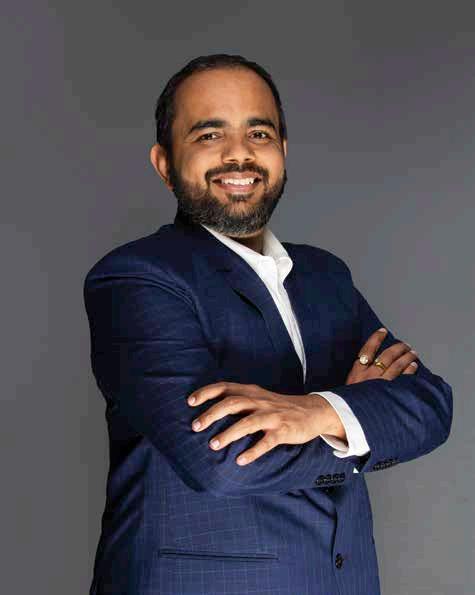
BECAUSE OF THAT …
Radio had to evolve. It was no longer just about mass broadcasting; it was about engagement, interactivity and digital transformation. Stations embraced streaming, mobile apps and social media integration. Many repurposed popular talk show segments into podcasts, ensuring they could be consumed any time and anywhere. Brands, too, recognised the shift, reallocating ad budgets to digital audio, ensuring they reached both real-time radio listeners and on-demand podcast audiences.
UNTIL FINALLY …
The realisation dawned: podcasts and radio are not competitors; they are partners in the evolving audio ecosystem. The most successful media brands in the UAE understood this and adapted accordingly.
As radio and podcasts continue to converge, the UAE’s audio landscape will be shaped by: Hybrid content models: Radio stations launching companion podcasts, while podcasters leverage live formats.
AI-driven personalisation: Smarter algorithms curating content based on preferences. Community-driven engagement: Events such as PodFest Dubai, a gathering of creators, brands
“PODCASTS AND RADIO ARE NOT COMPETITORS; THEY ARE PARTNERS IN THE EVOLVING AUDIO ECOSYSTEM.”
and listeners that fosters collaboration, networking and interactive panel discussions, reinforcing the connection between content producers and their audiences.
Subscription-based revenue models: Premium content and ad-free experiences driving monetisation.
Corporate and educational podcasting: UAE businesses and universities embracing bespoke podcasts for storytelling and thought leadership.
Smart speaker and in-car integration: Seamless transitions between live radio and on-demand listening.
The UAE’s audio media evolution is not about choosing between radio and podcasts; it’s about embracing both. Traditional radio remains a trusted, far-reaching medium, while podcasts cater to the personalised, digital-first listener. Think about this: AED 100,000 spent on radio could help a brand reach approximately 1.4 million listeners while the same on podcasts would help it reach almost a million listeners. However, podcasts offer targeting options that aren’t available on traditional radio. Therefore, the future belongs to media brands that integrate both formats, adapt to changing consumer behaviours and harness the power of technology to create richer, more engaging experiences. In this ever-evolving audio landscape, those who innovate will lead, those who resist will fade, and the UAE’s listeners will continue to enjoy an unprecedented level of choice, convenience and content diversity.
By Aseem Bhandari, Head – Media Investments and Partnerships, Team Red Dot
Frequency: FM106 in Abu Dhabi and on FM99.3 in Dubai
Launched: 2017
Parent company: Abu Dhabi Media Company Office: Abu Dhabi
Language/format: English; adult contemporary
Media rep: ADMC commercial team adtv.ae
800 2366 commercial@admn.ae
Abu Dhabi Media Company officially launched “Radio 2” in April 2017 with a focus on playing the best feel-good music from the 80’s, 90’s, and 2000’s to deliver content suitable for all listeners across the UAE.
Radio 2 offers the most familiar feel-good songs of core artists.
Radio 2 is one of eight stations fully owned by Abu Dhabi Media Company (ADMC), the UAE’s leading broadcaster and media company, and one of the largest media businesses in the Middle East and GCC.
Radio 2 airs on FM106 in Abu Dhabi and on FM99.3 in Dubai.
Frequency: 89.1
Launched: 1999
Parent company: Ajman Independent Studio LLC
Office: Channel 4, DAMAC Business Towers, Business Bay, Dubai
Location of mast: Ajman
Reach: UAE
Broadcast license lessor: Ajman Government
Listeners demographics: 18 – 40 age group; M/ F
Flagship programmes: The Morning Drive with Bhairavi & Shardul; Hashtag Trending with Shruti, The Buzz with Faizan, Most Wanted with Abhijeet
Language/format: Hindi; Bollywood music station
Media rep: Mohammed Jundi, network sales director
radio4fm.com 04 567 0444 mjundi@ch4.ae
Montecarlo
Frequency: 95.3
Language: Arabic
Frequency: 90.5
Language: Arabic
Frequency: FM 100.5 in Abu Dhabi, and FM 104.1 in Dubai
Launched: 2017
Parent company: Abu Dhabi Media Company Office: Abu Dhabi
Language/format: English; Top 40 (hit music, latest trends, celebrity news)
Media rep: ADMC commercial team adtv.ae
800 2366
Radio1UAE@admn.ae
Abu Dhabi Media Company officially launched ‘Radio 1’ in April 2017 to deliver engaging and exciting entertainment from a variety of artists to a youthful audience.
Radio 1 is an English-speaking station, playing charting western TOP 40 music. It keeps you in-the-know on the latest trends and celebrity news and is also home to the UAE’s biggest and most exciting competitions and giveaways.
Radio 1 broadcasts flagship programs such as; Radio 1 Breakfast, Radio 1 Drive, Live from LA with Dean McCarthy and Radio 1 Old Skool.
Radio 1 is one of eight stations fully owned by Abu Dhabi Media Company (ADMC), the UAE’s leading broadcaster and media company, and one of the largest media businesses in the Middle East and GCC.
You can tune in to all the live and pre-recorded programs on the ADtv application, where you can also listen to all previous episodes, which is available on Apple Store and Google Play.
Radio 1 broadcasts on FM 100.5 in Abu Dhabi, and FM 104.1 in Dubai.
Parent company: Dolphin Recording Studio LLC
Language/format: Malayalam; CHR format
Location of mast: Ras Al Khaimah
Broadcast license lessor: Government of Ras Al Khaimah
Launched: 2011
Parent company: ARN Office: Dubai, UAE
Listeners demographics: Farsi speaking residents in the UAE Flagship programmes: Sobh-E-Shoma baa Hannan
Location of mast: Al Mas Tower, Dubai
Broadcast license lessor: Dubai Reach: UAE radioshoma934.ae 04 455 5888
joshua.busteed@arn.ae
The UAE’s Number 1 Farsi Language Radio Station
Frequency: 92.2
Language: Arabic
Frequency: 92.2
Launched: 2015; 2022
Ownership: Aaren World Media & Advertising LLC
Language: Tamil
Reach: Entire GCC and globally through app-based radio Broadcast license lessor: Ras Al Khaimah Media Broadcasting Location of mast: Dubai, UAE ceo@aarenworld.com
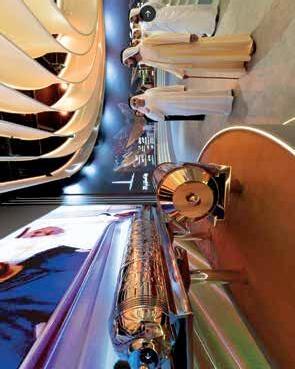




















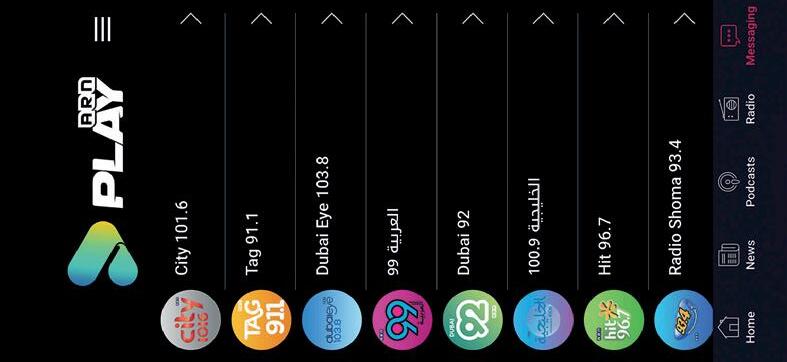



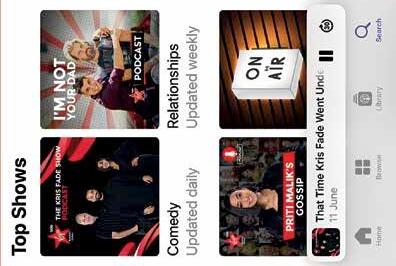


Frequency: Frequency: 88.0 MHz in Riyadh and Jeddah/ 99.9 MHz and 90.5 MHz in Amman
Launched: 2010 in KSA
Parent company: Rotana Media Group
Office: Villa 23,Boutique Villa - Dubai Media City, Dubai, UAE
Location of mast: Riyadh, Saudi Arabia
Reach: Saudi Arabia and Jordan
Listeners demographics: A youth-oriented entertainment radio station that has the largest music library in Saudi Arabia and Middle East, and broadcasts a wide range of Arabic music and entertainment content.
Flagship programmes: Live Your Morning (with Noura Hammoud); The Telescope (with Ahmad Al Hamed, Maha Saud); On the Way (with Yazi Al Rajhi); The Ball’s in Your Court (Mohammed Al-Sharif); Koora (Turki Al-Ajmah)
Language/format: Arabic
Media rep: Rotana Media Services rotanarms.net
+971 4 567 4300 joe.samaha@rotana.net
Founded: 1997
Headquartered: Ajman
Number of staff: 150+
Chairman: Mr. Abdulla Mohammed Al Murad
ch4.ae
+971 4 567 0444


Frequency: 107.8
Launched: 2000
Parent company: Ajman Independent Studio LLC
Office: Channel 4, DAMAC Business Towers, Business Bay, Dubai
Location of mast: Ajman
Reach: UAE
Broadcast license lessor: Ajman Government
Listeners demographics: 18 – 40 age group; M/ F
Flagship programmes: Sabah Al Khaire Ya Emarat with Rawan and Jad, Al Rabia Wal Nas with Abu Rashid, Refresh with Rakelle, 3A Tareeq with Salam
Language/format: Arabic; Arabic music and entertainment
Media rep: Mohammed Jundi, network sales director alrabiafm.com 04 567 0444 mjundi@ch4.ae
Frequency: 87.6
Language: Arabic Format: Religious
Radio stations under network: English (104.8 Channel 4 FM), Arabic (107.8 Al Rabia FM), Malayalam (101.3 Gold FM), Hindi (89.1 Radio 4 FM), Russian (103.2 FM - Volna)
UAE’s first FM radio network with five radio stations, reaching out to more than five million daily listeners across English, Arabic, Hindi, Malayalam and Russian languages. For more than 25 years, apart from offering contemporary trending music and all-round entertainment seven days a week, the Channel 4 Radio Network also enjoys a massive following across social media, app and podcast lovers.
SERVICES: 360-degree client solutions, brand integrations, content and entertainment creation with the best advertising packages on-air and on digital platforms.



As the UAE welcomes its first AI radio host, Channel 4 Radio Network’s Ravi Muni and Mohammad Jundi explore what’s next for listener-first storytelling.
Ravi Muni: The UAE is globally recognised as a hub for innovation, be it in space exploration, renewable energy, or artificial intelligence. The country’s commitment to future readiness is evident in its decision to introduce artificial inteligence (AI) courses in schools, preparing the next generation for a digital-first future. In such a bold and visionary environment, it’s only fitting that radio keeps pace and Channel 4 Radio Network is doing just that.
Radio thrives on immediacy, intimacy and innovation. It’s one of the most agile and adaptive media platforms that constantly evolves to stay ahead of the curve. From analogue to digital, from frequency dials to mobile apps and CarPlay, radio embraces the latest technological advancements like no other. It is a medium built for the audience, shaped by their preferences and driven by their changing needs. And now, as artificial intelligence begins to shape every aspect of modern life, radio is once again ready to lead.
Keeping with the UAE’s tech-forward vision, Channel 4 Radio Network proudly launches ‘AI RJ Steve’ – the UAE’s only AI radio jockey on its English station, 104.8 Channel 4 FM. With this revolutionary launch, the network once again sets a benchmark in innovation, audience engagement, and broadcasting excellence.
Since its inception in 1997, Channel 4 Radio Network has continually evolved with changing media consumption habits. We were among the first commercial radio stations to offer a complete package of music, news, RJ talk, sport, business, culture and entertainment updates, appealing to both locals and expats residing in the UAE. We were the first in the region to merge traditional radio with digital interactivity, creating a seamless audio experience on-air and video experience on social media for our listeners. We also led the way as the first radio network in the UAE to launch its own app and expand beyond radio podcasting.
The introduction of AI RJ Steve marks a bold leap into the next era of broadcasting where cutting-edge technology meets compelling storytelling, and where artificial intelligence transforms how audiences connect, engage and experience audio content like never before.

“Keeping with the UAE’s techforward vision, Channel 4 Radio Network proudly launches ‘AI RJ Steve’ – the UAE’s only AI radio jockey on its English station, 104.8 Channel 4 FM.”
accent, making it easily understood by the multicultural audience in the UAE. Steve is built with the same passion and purpose that has kept radio thriving through generations.
For a medium like radio, where content is king, the ability to consistently generate high-quality feature segments with the right delivery, modulation and energy is a game-changer. In many ways, Steve complements our human RJs, and listeners will get a glimpse of this in the Morning Show, where RJ Faris and Georgina will interact with Steve in an exclusive segment.
Listeners can expect a fresh radio experience tailored to the trends and moods of the day. An AI RJ allows us to experiment with newer, more diverse narratives and innovative formats. From intelligent summaries of world events to decoding complex scientific theories in simple words, Steve will make niche topics accessible and entertaining, especially for our younger and knowledge-hungry audiences.
For advertisers, AI RJ Steve opens an exciting new frontier in audio and visual branding. Steve can be programmed to deliver highly customised brand messaging, seamlessly adapting to real-time trends, listener behaviour and topical moments.
Mohammad Jundi: Powered by advanced generative AI, Steve is designed to deliver a smarter, more interactive radio experience. A lot of attention has gone into Steve’s voice, too. It has been carefully crafted to be radio-friendly, emotionally expressive and neutral in

What makes Steve stand out is his multi-platform potential. Branded content voiced and performed by the AI RJ can be extended across media ecosystems – from on-air radio features to podcasts, social media snippets, web platforms and even branded RJ videos for product demos and store walkthroughs. This not only enhances brand visibility but also ensures interconnected storytelling and broader reach.
crafted to be radio-friendly, emotionally expressive and neutral in
















We’re incredibly excited to share this next chapter with our listeners
stay ahead of the game and keep delivering innovative, listener-first
We’re incredibly excited to share this next chapter with our listeners and advertisers. Our AI RJ is more than just a tech upgrade; it’s a statement of intent. It reaffirms Channel 4 Radio Network’s vision to stay ahead of the game and keep delivering innovative, listener-first content in the most engaging ways possible.

The fusion of AI and Radio opens endless possibilities. Steve is our pilot project, and soon we will be launching more AI RJs on our Arabic, Hindi and Malayalam stations.
The fusion of AI and Radio opens endless possibilities. Steve is our Arabic, Hindi and Malayalam stations.
The future of radio is smarter, faster, more engaging – and it’s already on-air. Stay tuned.
already on-air. Stay tuned.

Ravi Muni, Group Deputy CEO & Group CFO - Al Murad Group and Channel 4 Radio Network (right), and Mohammad Jundi, Network Sales Director (left), Channel 4 Radio Network.

When I talk to marketers about podcasting, I notice a recurring pattern of misconceptions.
Many see it as a fragmented, niche and somewhat ‘less premium’ media that operates with minimal regulation. Podcasts are often perceived as a media channel that might feel unsafe for brands. Marketers worry about uncertain return on investment (ROI) and question whether their investment will truly deliver results.
These perceptions, I believe, are holding us all back from embracing one of the most promising media formats of our time. Podcasting is the intersection where media meets content, meets creative – all built and designed for audiences.
The elephant in the room (and on the page) is that yes, I am of course speaking from a perspective of a podcaster, and I am biased. There is also a but to this. I am also speaking from the perspective of someone who has worked more than 20 years in media, was a former CEO of a top three media agency, managed hundreds of clients, and has overseen billions of dirhams in media investments. I was pushing for digital media investment in 2010 and for e-commerce in 2013. In 2025, I am fighting for podcasting to be the next medium of choice, and I do so from a position of media logic, as well as creator passion.
Let’s flip the narrative. To audiences, podcasting is a trusted, personalised, on-demand experience – where listeners feel they’re in a conversation with a host who ‘gets them’. It’s a media space built on trust, passion and relevance. It’s a space where brands can genuinely connect with engaged audiences who are actively seeking content aligned with their interests.
Globally, WARC reports, audio accounts for 31 per cent of media consumption, yet only 8.8 per cent of ad spend is allocated there – an undervaluation by a factor of nearly three. In MENA, this gap is even more pronounced: there are more than 13 million unique listeners in Saudi Arabia alone, with 67 per cent of reachable audiences having access to podcasts, yet less than 1 per cent of digital ad spend is directed toward podcasting platforms.
The disparity between audience size and investment in this medium is stark and telling and, frankly, seriously disconcerting. Let’s talk media in the MENA versus in the US. According to the Interactive Advertising Bureau (IAB) and PwC’s Podcast Advertising Study, podcast advertising revenue in the US was $2bn in 2023. Up from $1.4bn in 2022. To put it in perspective, $2bn is approximately 33 per cent of MENA’s total digital spend. The first sensible counter argument to be made is that the audiences are different. The Middle East podcast audience is
bigger, at 445 million compared with the US’s total audience size of 338 million. A second argument could be that the platforms used to access podcasts are different.
However, this is not the case. YouTube, Apple Podcast and Spotify are all available here and in the US and remain the biggest three platforms for podcast consumption.
This raises a critical question: Are the listening audiences not the right ones for brands? To me, this is not the case.
According to Statista, podcast listeners tend to have higher-than-average incomes and spend approximately 20 per cent more on consumer goods and services. They are a valuable demographic that brands should be eager to reach.
And what about results? Are podcasts ineffective for marketing? Far from it.
Next Broadcast Media’s benchmarks reveal that brands advertising on podcasts experience an average 27 per cent increase in brand interest, a 24 per cent boost in
are better on podcasts than on other channels and supply side platforms (SSPs) and demand side platforms (DSPs) provide the scale. Everything is present except the MENA advertiser. The fight for digital budget and the fight for e-commerce budget now look like a distant memory. The fight for podcasting investment is now upon us, and ironically perfectly linked within the e-commerce and digital ecosystem. How marketers and agencies navigate this medium in the coming months will go a long way to deciding whether brands can deliver relevant, differentiated and integrated propositions that audiences can get behind.
Podcasting is my passion. But the other side of me can’t help but want to do more to support and protect the future of this incredible but unappreciated and misunderstood media.
By Luca Allam, Host of Luca’s Insight Track and Creator of MasterPitch – a training platform for public speaking.
Luca Allam, Founder and Host of Luca’s Insight Track, makes the case for why podcasts should be included in the media mix.










“THE DISPARITY BETWEEN AUDIENCE SIZE AND INVESTMENT IN THIS MEDIUM IS STARK AND SERIOUSLY DISCONCERTING.”










consideration, and a 26 per cent rise in consumer action intent. The same study in the US reports that 80 per cent of US podcast listeners listen to all the ads that come along with an episode, with 70 per cent taking action. These are incredible response rates and, frankly, no other media comes close.


With advanced programmatic targeting and brand-safe technology, there’s no logical reason for marketers to shy away from this medium.


We are at a pivotal moment. The question isn’t whether to include podcasting in your media mix – it’s how to do so effectively.

The biggest takeaway tip is to deploy strategies that support and amplify the voices and faces that audiences love. This ensures your investments are meaningful, long-term and sustainable. The audiences are there. Brand metrics and ROI metrics







































Ownership: Asharq News
Head office: Riyadh, Saudi Arabia
Number of staff: 600+
Launched: 2020
Language: Arabic
Format: Business
Location of mast: Riyadh, Saudi Arabia
Reach: Saudi Arabia salman.alqarni@asharq.com
Frequency: 102.3 - 102.5 – 102.7 FM
Launched: 1978
Parent company: Liban Libre pour la Production and la Diffusion Sal – RLL
Location of mast: Beirut, South, North and Bekaa Reach: Lebanon
Broadcast license lessor: The Lebanese Ministry of Information and The Lebanese Ministry of Telecommunication Language/format: Arabic Media rep: Interadio SAL rll.com.lb
+961 156 1639 info@interadio.com.lb
Frequency: 94.4
Launched: 1972 (re-launched in 2000)
Location of mast: Al-Khan, Sharjah
Parent company: Sharjah Broadcasting Authority Language: Arabic
Broadcast license lessor: Sharjah Government sba.net.ae/ar/radio/channel/13
Frequency: 102.7
Launched: 2012
Location of mast: Halwan, Al-Abar, Sharjah Parent company: Sharjah Broadcasting Authority
Broadcast license lessor: Sharjah Government Language: Arabic sba.net.ae/ar/radio/channel/12
Frequency: Abu Dhabi- 90.3 KHz; Dubai – 90.5 KHz; AlAin – 89.7 KHz
Ownership: Sky News and International Media Investments
Location of mast: Abu Dhabi- Mahawi Station; Dubai -Al Qusais Station; AlAin - Al Maqam Station
Reach: UAE
Broadcast license lessor: ADMC (Abu Dhabi Media Company)
Language: Arabic
Format: News
Frequency: 91.4
Launched: 2023
Parent company: Entertainment Network LLC
Reach: Oman soradiooman.com +968 2 200 9004 AMC@choueirigroup.com
Frequency: 89.4
Launched: 2015
Location of mast: Dubai
Language: Tamil
Parent company: Aaren World Media & Advertising Office: Dubai
Launched: 2015
Language: Tamil
Broadcast license lessor: RAK Broadcasting Authority
Reach: GCC and globally through app-based radio
Frequency: 99.9
Parent company: Alsumaria TV
Head office: Baghdad
Launched: 2005
Language: Arabic
Location of mast: Iraq
Reach: Iraq alsumaria.tv/SumerFm
Radio Zain
Language: Arabic
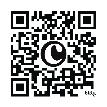
SEPTEMBER 2025
C AMPAIGN BREAKFAST BRIEFING (DUBAI, UAE) The Future is Now
OCTOBER 2025
C AMPAIGN SAUDI BRIEFING (RIYADH, KSA) Media & Marketing
DECEMBER 2025
C AMPAIGN AGENCY OF THE YEAR MIDDLE EAST AWARDS (DUBAI, UAE)
NOVEMBER 2025
C AMPAIGN BREAKFAST BRIEFING (DUBAI, UAE) Out of Home 2026
Frequency: 92.4 FM in Abu Dhabi, 100.1 FM in Al Ain, and 99.9 FM in Dubai.
Launched: 2009
Parent company: Abu Dhabi Media Company Office: Abu Dhabi
Listeners demographics: Multilingual youth and middle-aged adults in the UAE, aged between 15 and 50 years
Flagship programmes: Sabaho, Fnoon Afternoon, Alsa’ah Thalathah, Stars@5, #Star, and Alnas Altybah.
Language/format: Arabic and English Media rep: ADMC commercial Team adtv.ae
800 2366
commercial@admn.ae
Star FM, one of the leading stations of the Abu Dhabi Radio Network under the Abu Dhabi Media Company, was launched in 2009. It targets multilingual youth and middle-aged adults in the UAE, aged between 15 and 50 years.
The station has successfully given local radio a dynamic and modern character, reflecting the youthful spirit and diverse culture of Abu Dhabi in the Arab world.
The station’s identity is youthful, modern, entertaining, and musical, featuring a blend of Arab and Western influences. It presents content that elevates the aspirations of Arab youth, characterized by a modern, interactive style, a fast rhythm, and a variety of offerings.
Star FM has also achieved a global presence by participating in numerous international festivals, including the annual International Radio Festival in Switzerland.
Star FM station broadcasts flagship programs such as; Sabaho, Fnoon Afternoon, Alsa’ah Thalathah, Stars@5, #Star, and Alnas Altybah.
Star FM radio station is one of eight stations fully owned by Abu Dhabi Media Company (ADMC), the UAE’s leading broadcaster and media company, and one of the largest media businesses in the Middle East and GCC. You can tune in to all the live and prerecorded programs on the ADtv application, where you can also listen to all previous episodes, which is available on Apple Store and Google Play.
Tune in to Star FM on the following frequencies: 92.4 FM in Abu Dhabi, 100.1 FM in Al Ain, and 99.9 FM in Dubai.
Launched: 2013
Parent company: ARN Office: Dubai, UAE
Listeners demographics: Filipino nationals
Flagship programmes: Tag Gising Na with Bluebird & Keri Belle
Location of mast: Al Mas Tower, Dubai
Broadcast license lessor: Dubai
Reach: UAE tag911.ae
04 455 5888
joshua.busteed@arn.ae
The UAE’s Number 1 Filipino Radio Station
Frequency: 100.3
Location of mast: Umm Al Quwain
Language/format: English; conversation and the smooth-music mix. talk1003.ae
Launched: 2006
Parent company: ARN Office: Dubai, UAE
Listeners demographics: A youthful multicultural audience
Flagship programmes: The Kris Fade Show
Location of mast: Al Mas Tower, Dubai
Broadcast license lessor: Dubai
Reach: UAE
virginradiodubai.com 04 455 5888 joshua.busteed@arn.ae
The UAE’s #1 Hit Music Station
Frequency: 89.5 FM
Launched: 2013
Parent company: Levant Media Hub SAL
Location of mast: Jal El Dib, Beit Mery, Ashrafieh
Broadcast license lessor: Dubai
Reach: Lebanon
Language/format: English Media rep: Interadio SAL
virginradiolebanon.com +961 156 1639
info@interadio.com.lb
Frequency: 89.7
Launched: 2019
Parent company: Levant Media Hub SAL
Location of mast: Jal El Dib, Beit Mery, Ashrafieh
Reach: Lebanon
Language/format: English
Media rep: Interadio SAL
virginradiolb.com +961 156 1639 info@interadio.com.lb
Location of mast: UAE
Launched: 2020
Parent company: Parallel Lines Media Network FZE
Language/format: Desi station
Broadcast license lessor: Fujairah Broadcasting Authority vibe1054.com
Sharjeel@vibe1054.co
Frequency: 103.2
Launched: 2023
Parent company: Ajman Independent Studio LLC
Office: Volna Radio 103.2, Zentral Building, DWTC
Location of mast: Ajman
Reach: UAE
Broadcast license lessor: Ajman Government
Listeners demographics: 18 – 55 age group; M/ F
Flagship programmes: Hello Morning Show, Second Wind
Afternoon Show, Boombox Evening Show
Language/format: Russian
Media rep: Anna Firsova CCO volna.ae
054 431 5321
anna@volna.ae
Frequency: 97.6
Language: Arabic
Format: Religious
Parent company: WPP, Part of The Landor Group Regional HQ: Dubai, United Arab Emirates
Founded: 2008
Amp is the world’s leading sonic branding company. Utilising its award-winning Sonic DNA® design approach and AI-fueled Sonic Hub® Ecosystem, Amp creates holistic sonic identities for global brands and creates 360º sonic experiences.
Ownership: Create Group
Founded: 2018
Language/format: English; audio and video talktous@creategroup.me
This is where we talk all things digital, content and start-up culture and share some valuable agency insights.
Parent company: Matrix Public Relations
Head office: Dubai
Language: English Reach: Global podcast@thematrixgreenpill.com thematrixgreenpill.com
Founded: 2001 HQ: Dubai mindloopstudios.com Production@mindloopstudios.com
Mindloop offers the highest quality in voiceover production, music composition and sonic branding, tailoring all languages and styles alongside over 20 awards for sonic branding.
Founded: 2017 HQ: Kuwait musicgrid.com hello@musicgrid.com
MusicGrid is the leading sonic branding agency in the GCC, crafting audio identities and sound experiences for brands across industries since 2017.
Founded: 1999 Parent company: Enchant Group sonicbrand.com david@sonicbrand.com
Born in 1999, Sonicbrand was the first agency in the World for sonic strategy. From London, Riyadh and Amsterdam, we help brands create, own and manage their sound across time, territory and touchpoint.
Headquartered: Riyadh, Saudi Arabia info@soundmine.me
Sound Mine is KSA’s first Dolby-enabled sound studio, producing unique original soundtracks with international standards and local fusion. We specialise in music production, sonic branding, ADR, voice over, sound mixing and design.



Founded: 2022
HQ: Dubai
Type of agency: Sonic Branding & Original Music Agency
Head of agency: Chris Atkins, CoFounder & Managing Director withfeeling.com +971 55 148 2259 hello@withfeeling.com

Atkins Co-Founder & Managing Director

Dickinson Co-Founder & Chief Composer
WithFeeling is a multi-award-winning sonic branding and original music agency with a strong presence across Dubai, Riyadh, Dublin, London and Amman. We design emotionally intelligent sound identities and music that spark connection and drive performance. Our culturally diverse team of composers, strategists and producers work across brand, screen and event, creating immersive sonic experiences that cut through the noise. Whether it’s a full sonic identity, a global event soundtrack, or a voiceover in twenty languages, we help brands sound as good as they look and feel even be er.
SERVICES OFFERED: Sonic branding, original music, sound design, brand voices
KEY CLIENTS: Expo 2020 Dubai, Diriyah Biennale Foundation, Dubai Airports, YourBazaar, Dubai Racing Club, Special Olympics GB, Ministry of Tourism KSA, Qiddiya, BBC Worldwide, McDonald’s, Parkin, MBRL, Emarat
AWARDS: Gold – Best Use of Audio Branding – Transform Awards MEA 2025 (YourBazaar); Silver – Best Use of Audio Branding – Transform Awards MEA 2025 (Dubai Racing Club); People’s Choice – Creativepool 2024 (Destination Imagination); Finalist – Music + Sound Awards 2024 (Destination Imagination)




WithFeeling partnered with Your Bazaar to craft a sonic identity that stood out in the crowded UAE e-commerce space – something vibrant, cross-cultural and unmissable on radio.
The brief was simple: make it memorable. But in a market as diverse as the UAE, where multiple languages and listening habits collide, familiarity was key. So, we did something unexpected: we reimagined the most recognisable melody in the world. By adapting the final phrase of ‘Happy Birthday’ – which is out of copyright – we matched the brand’s six-syllable name – ‘your-baz-aardot-ae’ – to a tune everyone knows. The result was a jingle that felt instantly familiar yet cleverly fresh. Listeners didn’t always clock the reference immediately – which made it all the more memorable. It sparked curiosity, made people smile and helped the brand stay top of mind without them even trying. But it didn’t stop there. We designed a suite of supporting sonic cues to reinforce the product experience: CLICK CLICK – effortless browsing DING DONG – doorstep delivery
KA CHING – secure transactions and opportunity
Each sound effect was tightly tied to the Your Bazaar brand promise and designed to work across a wide range of touchpoints – from mobile app alerts and onboarding videos to TikTok ads and radio stings. These weren’t just audio garnishes. They were tactical, hardworking assets that delivered brand
consistency wherever sound was heard. Adaptability was also baked in. The same melody flexes to local markets with regional endings –‘.ae’, ‘.sa’, ‘.om’ and ‘.qa’ – making localisation quick, simple and effective without compromising the core sonic identity.
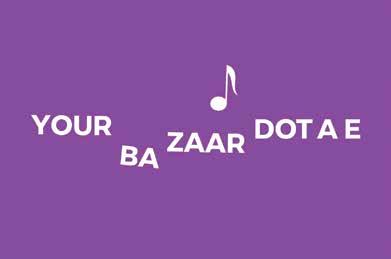
To ensure the work performed, we tested the assets internally and externally using Veritonic analytics. The results showed strong attribution, high recall and an uplift in perceived brand warmth and trust. The identity also resonated across diverse audience groups – a key factor in its effectiveness. The campaign didn’t just work in theory. It performed in the real world. The jingle is now heard in taxis, TikToks, YouTube bumpers, and streaming platforms – wherever the audience lives and listens. It’s recognisable, joyful and culturally smart – and earned Gold at the Transform Awards MEA 2025 for Best Use of Audio Branding. More than just a jingle, Your Bazaar now has a sound it can own. One that makes people feel something –and act on it.




















































Fischer Chief Growth and Innovation
Officer,
Publicis Groupe Middle East
Publicis Groupe Middle East’s Jennifer Fischer says that it’s time for us to unlock our AI superpowers.
“Will your job survive artificial intelligence (AI)?” “Find out which jobs are AI-proof.” “AI won’t take your job but someone who knows AI will.” Those are the scary headlines everywhere.
Let’s flip the script and look at the bright side for a minute.
Stepping into this era – I like to call it ‘Potentialis’ – is like stepping into a sci-fi utopia where AI isn’t just another tool; it’s the secret sauce for unlocking human superpowers.
Imagine this as the moment in every great superhero story where something big happens – an experiment gone wild, a cosmic accident or even a radioactive spider bite – that transforms the protagonist forever. That’s you, dear reader. AI is our rabbit-hole moment, à la Alice in Wonderland, but here’s the kicker: there’s no crawling back out, no ‘return to normal’ – it’s forward all the way.
Let’s step back in time for a second to the time before AI superpowers.
When we explore the before era, what we see is that technology didn’t eliminate jobs; it transformed them. The sewing machine revolutionised tailoring, typewriters changed clerical work and ATMs reduced branch costs, boosting job numbers.
However, historically, our relationship to skills was very different: One skill sustained a person for life, often passed down through generations as a family profession. Specialisation remained crucial even during industrialisation. If you look at your own family, there were likely many individuals who held specialised jobs throughout their lives.
I like to think of the present as our sci-fi moment when we become aware of our superpowers. We’re in this decade of AI mega-acceleration, when everything is faster, smarter and more accessible … and that is powerful.
Yet, there are challenges and hurdles to unlocking these AI superpowers.
“Human bias towards AI is stopping us from making the best use of our new superpowers.”
For one, human bias towards AI is stopping us from making the best use of our new superpowers. Take creativity tests, for example. AI now outshines humans in thinking outside the box – until people find out it’s AI-created. Then, suddenly, it’s like the magic disappears.
Same story with doctors. Research shows that when AI offers input, some physicians simply ignore it if it doesn’t align with their own opinions. The result? Lower accuracy. It’s like having a genius co-pilot but refusing to take their advice. Second, the world is getting louder, with so much noise out there. AI is churning
out billions of assets at lightning speed; as it is a statistical model, originality is at risk.
The danger? Falling into the ‘mediocre middle’, where everything feels right but kind of average. The solution? Better prompts. This is all about prompts that help you escape the probably, obvious answers. And the good news is that AI can actually help us get better at prompting AI better. If only all our colleagues were this helpful.
A sneakier problem than poor prompting is how AI might be giving your brain a little too much ‘help’. Turns out, relying heavily on AI could be making our brains lazy. Early studies suggest that those who frequently use AI are finding it harder to evaluate information, solve problems and use critical thinking.
This is neuroplasticity at work: the brain creates new pathways through use and removes old pathways through disuse. And technology impacting neuroplasticity is not new.
Remember how our attention span has been shrinking? Or how, not long ago, we used to be able to go back home without Google Maps shouting ‘turn left’?
Now, with AI and how all encompassing it can be, we have to be more intentional. We owe it to ourselves and the next generation to build a ‘cognitive immune system’, and we must be careful not to outsource too much of our thinking.
That means using AI as a partner – not a crutch. Personally, my brain turning into mush scares me more than AI taking my job.
OUR POTENTIALIS FUTURE
This is when the true era of Potentialis begins. Your DNA has changed – you’ve joined the superhero club. Your superpower isn’t flying or invisibility – it’s the ability to learn and master new skills faster than ever before. In the past, you could build an entire career on one skill.
Now skills are melting away faster than ice cream on a sunny day. But here’s the kicker: that’s not a bug; it’s a feature. Learning new skills becomes our power-up system.
And for teams, it’s all about power-up cycles. Teams that get the hang of levelling up quickly will leave the competition in the dust, creating true superhero leagues.
NOW WHAT?
My biggest take away is this: Fear and growth go hand in hand.
This is a classic case of ‘feel the fear and do it anyway’… and you’d better have some fun along the way too.
So, welcome to Potentialis – a world where your superpowers are boosted by AI.
Ready to dive in?

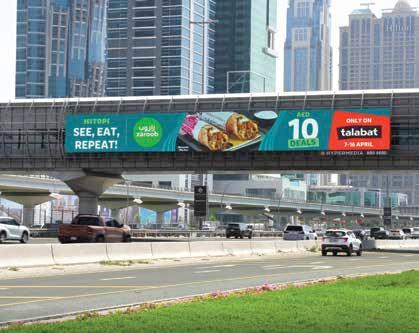






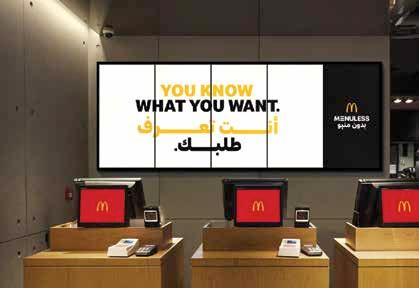

RORY MCENTEE
Chief Marketing Officer, GymNation


TALABAT X KITOPI: SEE, EAT, REPEAT (1)
This campaign turned heads and tastebuds with a classic combo: low friction, high visibility and irresistible pricing. AED 10 meals? That’s not a promo, that’s culinary clickbait. By blanketing Dubai with out of home (OOH), hijacking hunger with influencers and removing every barrier to trial, they didn’t just sell meals, they hacked customer acquisition. Lesson: feed them cheap, feed them often and feed them everywhere.
MG EGYPT: WELL KNOWN, EVEN IF NOT OWNED (2)
This did more than flaunt cars; it sparked love for a brand you might never own. By turning curiosity into admiration, they built brand equity through eye-catching ubiquity. The insight? People fall for aspirational visuals, even if their wallet isn’t ready for the drive.
BOUTIQAAT: YA HALA CAMPAIGN (3)
This went full sitcom on the Ya Hala Festival, turning discount fever into comedy gold. The irreverent, locallyflavoured jokes broke through ad fatigue proving that humour + cultural resonance = mega shareability. Message learned: don’t just promote sales to consumers. Make them laugh, make them feel seen and watch those metrics party like it’s raffle night at The Avenues.
RAM: RHO AIRLINES – THE SHORTEST FLIGHT (4)
This campaign brilliantly turned a product demo into a theatrical stunt, using humour and misdirection. By parodying the airline experience – right down to boarding passes – it elevated utility into entertainment. The real marketing insight? Consumers don’t remember specs; they remember how you made them feel. RAM didn’t just talk performance – it made audiences feel it, proving that emotional storytelling can drive product credibility without a single feature list.
MCDONALD’S SAUDI: MENULESS (5)
From a marketing standpoint, it was a masterclass in brand confidence, nostalgia and behavioural insight. By challenging choice overload with simplicity, McDonald’s sparked viral engagement and reaffirmed its iconic status – not by adding, but by taking away. I’m lovin’ it.
RICHA RAI Account Director, AKQA Dubai


TALABAT X KITOPI: SEE, EAT, REPEAT (1)
Kitopi’s shift from a back-end cloud kitchen to a consumer-facing brand was done with clarity and simplicity. The ‘See, Eat, Repeat’ message was catchy and consistent, especially across OOH and influencer content. It made the offering easy to grasp and remember. One thing that could’ve added more value would be integrating QR codes or clearer digital extensions to bridge awareness with action.
MG EGYPT: WELL KNOWN, EVEN IF NOT OWNED (2)
This campaign tapped into a culturally relevant insight –Egyptians love discussing cars, whether they own them or not. MG used that idea cleverly to build warmth and relatability. The humour felt organic, and the subtle product placement didn’t interrupt the storytelling. A clearer next step, like encouraging test drives, could have helped tie emotional engagement with tangible outcomes.
BOUTIQAAT: YA HALA CAMPAIGN (3)
This one leaned fully into bold, local humour, and it worked. The over-the-top execution made it easy to share and perfectly suited platforms such as TikTok and Instagram. It felt fun and intentionally unpolished. That said, the raffle mechanism and brand presence could’ve been brought to the forefront a bit more, so viewers connected the fun with a clear takeaway or action.
RAM: RHO AIRLINES – THE SHORTEST FLIGHT (4)
RAM’s approach was theatrical and unexpected, turning a product demo into a full-on desert stunt. The visual production and airport setup created buzz without feeling out of place. The use of influencers felt integrated, not forced. The campaign did well to anchor the showmanship in product performance.
MCDONALD’S SAUDI: MENULESS (5)
Stripping menus from stores sounds risky, but it worked in McDonald’s favour by driving curiosity and footfall. It made people pause, think, and rediscover their favourites – a nice twist on everyday behaviour. I would’ve loved to see some more layered storytelling to deepen impact. Amplification beyond store walls could’ve helped sustain the momentum beyond the initial surprise.
Talabat x Kitopi
Title: See, Eat, Repeat Agency: Hypermedia
MG Egypt
Title: Well Known, Even If Not Owned Agency: DDB Egypt
Production houses: Kino Films, The Barber Shop
Boutiqaat
Title: Ya Hala Campaign Agency: Shareet Studios
RAM
Title: RHO Airlines – The Shortest Flight Agency: Publicis Middle East Production house: Stoked Post-Production: Optix
McDonald’s Saudi Title: Menuless Agencies: Leo Burnett, Dubai
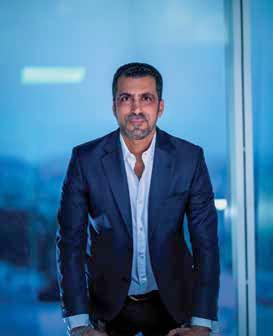
Managing Director
Cicero & Bernay Communication Partner
In the rush to embrace artificial intelligence (AI), some brands confuse technology with creativity, substituting machine mechanics for human insight. These approaches leave brands with shiny, shareable campaigns that fail to make a lasting impression. If AI drives the idea, originality drowns in sameness. Consider Coca-Cola’s 2024 AI-generated holiday advert, a remake of its
iconic ‘Holidays Are Coming’ commercial. Despite its glossy animation, audiences and critics labelled it a ‘creepy, dystopian nightmare’, describing it as cold, uncanny and devoid of festive warmth. The backlash wasn’t about technology; it centred on tone. The advert had the data and mechanics to be successful, but lacked the heart behind its message.
AI can amplify and enhance creativity, but it should not be viewed as the replacement. Artificial prompts and visuals can assist the process, yet the emotional core still requires a creative mind. The best campaigns won’t be the most automated; instead, they will strike a balance between mechanical and human input to bring more profound ideas to life.
1 in 2
Creative directors believe AI can improve output but not originate emotionally resonant ideas.

Google’s VEO 3, revealed at I/O 25, can generate videos with synced dialogue, sound effects and ambient audio using only text prompts. While creators praised its realism, others voiced concern over deepfake risks and the potential disruption to traditional video workflows. As excitement builds, so does the debate over balancing innovation with responsibility.
56%
Consumers have stopped buying from brands perceived as inauthentic.

Labubu, the offbeat plush collectible, has become the latest viral sensation. Recent weeks have seen social media flooded with videos of fans vying for the blind-box toy due to its rarity and mystery model, fueling repeat purchases and viral momentum. Sensing an opportunity, brands such as Deliveroo have entered the conversation, hosting exclusive drops to tap into the plush-driven cultural wave.
42%
Consumers find brands using AI less trustworthy unless disclosures are made.

Boxed out by the hype
Australian fashion e-retailer Peppermayo came under fire for prioritising influencer trips and sponsorships while customer complaints over unfulfilled orders, delayed refunds and limited communication mounted. The contrast drew criticism, with many accusing the brand of favouring image over customer experience. A response followed, alongside a month of free express shipping, but reputational recovery may require more than a marketing fix.

Marriott International has appointed RHIANNON CALLAGHAN as Multi-Property Director of Marketing and PR for Marriott Hotel Al Jaddaf, Dubai, Marriott Executive Apartments Al Jaddaf and Marriott Executive Apartments Dubai Creek. In her new role, Callaghan will be responsible for the full spectrum of marketing and communications activity across all three properties. Her focus will include driving integrated campaigns, strengthening brand positioning, expanding digital reach and leading high-impact PR and partnership strategies.

HAVAS Red Middle East has made three key leadership promotions as the agency enters a new phase of momentum and market growth. DANA TAHIR has been appointed Chief Executive Officer. In her new role, she will continue to lead the agency’s regional vision while deepening its commitment to creative innovation, client impact and talent development.
RISHI TALWALKER steps into a newly elevated role as one of two Heads of Communications, along with RAZAN KARIM. Talwalker will oversee the agency’s corporate-consumer
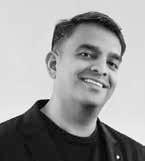
portfolio while leading strategy and growth. Alongside him, Karim takes the lead on fashion, beauty, lifestyle, and wellness clients across the region.
HAVAS Red Middle East currently partners with some of the world’s most influential companies, including Estée Lauder, COTY, adidas, Nakheel, Disney+ MENA, Spotify MENA, Gold Apple, Marriott International, Versace, Tom Ford, Pampers Arabia and Dubai Holding, delivering bold, meaningful work across industries and sectors.

MRM MENAT has appointed WARREN DAVEY as General Manager of MRM KSA. With more than 27 years of international experience in commercial growth and brand transformation, Davey brings a rare blend of deep regional understanding and a global strategic outlook. In Saudi Arabia, he has led integrated marketing strategies across sectors including tourism, culture, education and entertainment – driving stronger audience engagement, brand visibility and long-term impact.
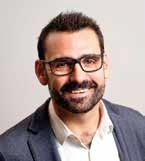
Publicis Communications KSA, the creative hub of Publicis Groupe Middle East has appointed HESSA AL SUDAIRY as Executive Creative Director. In this role, Al Sudairy will collaborate with the Leo Burnett and Saatchi & Saatchi offices across the Kingdom to further strengthen their creative vision across a diverse and growing client portfolio. Al Sudairy joined
Leo Burnett early in her career as a copywriter and now returns to lead the creative charge in a market that continues to evolve rapidly.
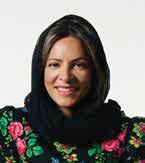

Global brand experience design and marketing agency AKQA has appointed JON HOLLOWAY as Managing Director for the Middle East and North Africa. Based between the UAE and KSA, Holloway will aim to accelerate the agency’s momentum in the region, partnering with ambitious brands to shape new experiences at the intersection of creativity, culture and emerging technology. With a global career spanning across the EMEA, APAC and MENA regions, Holloway brings more than two decades of experience as a creative and strategic leader.
Advertising agency Magic Mango Group has appointed ROSHAN FAROOK as Chief Marketing Officer to lead its Dubai operations. With this move, the agency aims to signal a bold new chapter in its global journey, combining Sri Lankan ingenuity with international ambition. Farook’s entry to Magic Mango MENA aims to enhance current skillsets and enable its efforts to spread its wings in the region and beyond.


During the month of June, The Spin welcomed submissions from across the globe, including several unfortunate typos.
Passengers flying American Airlines (AA) took to social media, drawing attention to a typo on the safety signage within the aircraft. The mistake appears in the airline’s Airbus A320 aircraft. While the error in the word ‘cushion’ has reportedly been neglected for years, here’s hoping that the actual seat-bottom cushion is being given the attention it is due.


Red Bull was also pulled up for a typo on a promoted social media post tagged #GivesYouWings. Responses to the post included comments such as #GivesYouTypos. If you don’t spot the typo on the first look, read it again.
We also have a ‘sooth’-ing typo after repairs on US Highway 31. Responding to the typo, the Vestavia Hills City staff shared a post on Facebook saying, “Woke up to a striping error this morning. City staff has been in contact with JeffCo to coordinate repair by the striping vendor. This will be repaired as soon as possible. Look for this photo on the next ‘You Had One Job’ reel.”
Speaking of fixed typos, Disney has finally fixed the typo spotted by visitors at the Walt Disney World Resort Magic Kingdom theme park in Florida. Those with a keen eye for such things noticed that the description for Team Green’s Integrated Systems Engineer MOTO in the TRON Lightcycle

Run’s post-show room inadvertently had more than a single ‘and’. Although it’s easy to miss, clearly this tiny detail irked enough people that Disney decided to step in and save the day.
On a more serious note, New York Magazine posted an absolute howler on X (formerly Twitter) –made worse by the fact that it was on a rather sensitive topic. The magazine posted that celebrity podcaster Alexandra Cooper, host of the famous show Call Her



Daddy, has accused ‘Nancy Mace’ of harassment. Trouble is, they actually meant Nancy Feldman, the former Boston University women’s football coach who Cooper has raised allegations
against. Nancy Mace, on the other hand, happens to be a US Congresswoman, who has been representing the 1st Congressional District of the US state of South Carolina since 2021. Clearly, Mace was not happy and blasted the magazine on social media for the “lazy, dangerous typo”.
The final entry in The Spin was more of a ‘visual typo’ for an advertisement promoting Prestige Nail School. Makes you wonder what sort of ‘nail tech school’ teaches you to paint your own nails while holding someone else’s hand. The only tech used here seems to be generative AI, and it clearly has not nailed the ad.














